THE NEXT LEVEL OF IMPACT






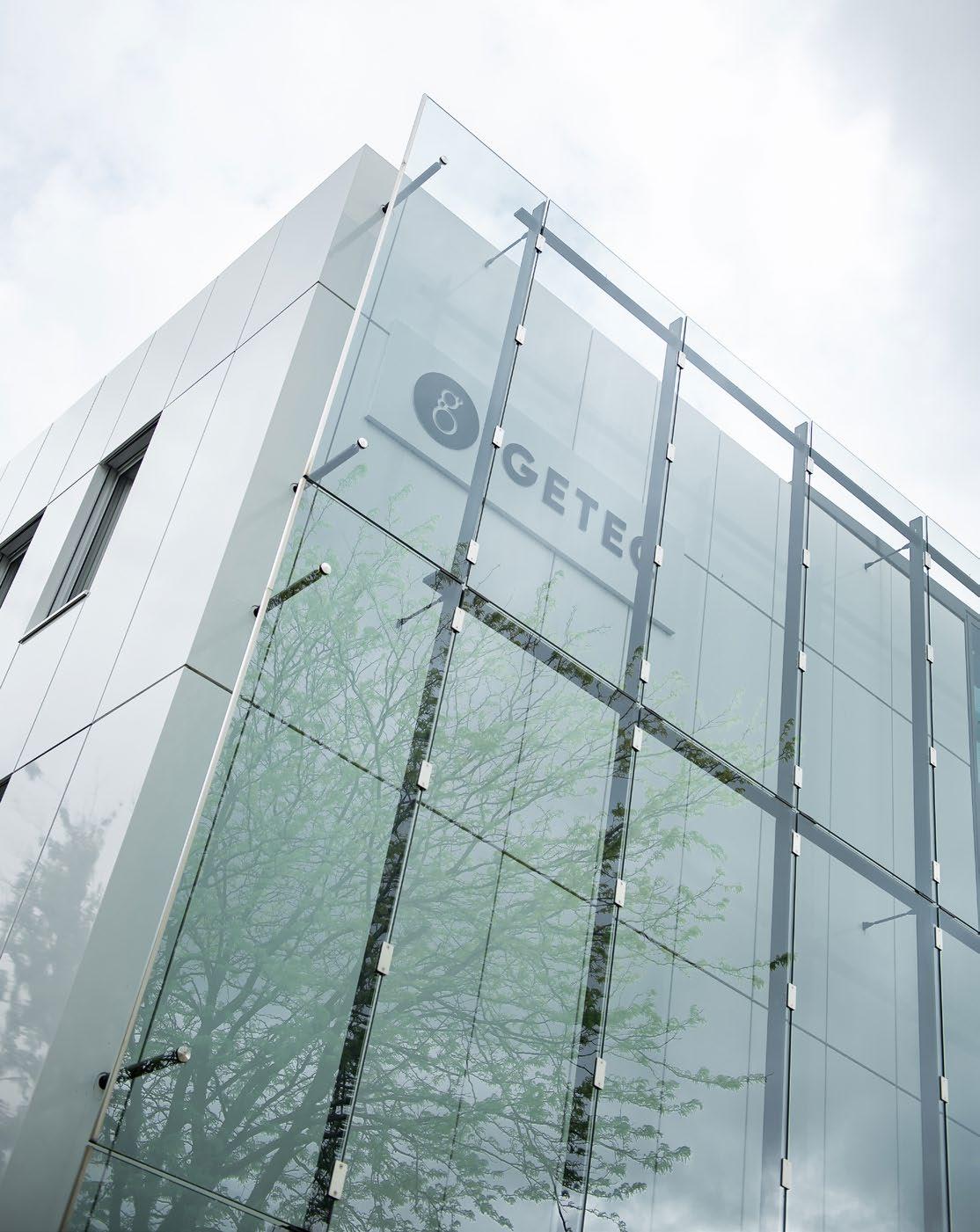
THE NEXT LEVEL OF IMPACT
FOREWORD CEO T. WAGNER, GETEC
ESG ROADMAP
GENERAL DISCLOSURES
GRI – GENERAL DISCLOSURES 14–31 WHAT WE HAVE LEARNED
ENVIRONMENT
ENERGY METRICS
GRI – ENVIRONMENT 38–67
AGROTHERMAL TECHNOLOGY: AGRICULTURE ABOVE GROUND, ENERGY BELOW GROUND 46 ROZZANO DISTRICT HEATING: THE NEW CONNECTION
ICE STORAGE: OPPOSITES ATTRACT
WASTE-TO-VALUE: VALUABLE WASTE
SOCIAL 68 SAFETY AND DIVERSITY METRICS 70 GRI – SOCIAL 72–92
OCCUPATIONAL SAFETY: DEVOTING HEART AND MIND TO SAFETY 82 HOW COMMITTED ARE OUR EMPLOYEES? 94 AID FOR UKRAINIAN ORPHANS 96
GOVERNANCE 98 COMPLIANCE METRICS 100 GRI – GOVERNANCE 102–137
INTERVIEW – GOVERNANCE: A. BERNER, ADVISORY BOARD 118 ENERGY SECURITY: THE EVOLUTION OF HYDROGEN 120 INTERVIEW – GOVERNANCE: R. BUCH, VONOVIA 126 IT/OT SECURITY: THE GUARDIANS OF INFORMATION 128
OUTLOOK
ARTIFICIAL INTELLIGENCE FROM GETEC: VEROENERGY
APPENDIX 140
OF MEMBERSHIPS
LIST OF KPIs/SASB INDEX
INDEX
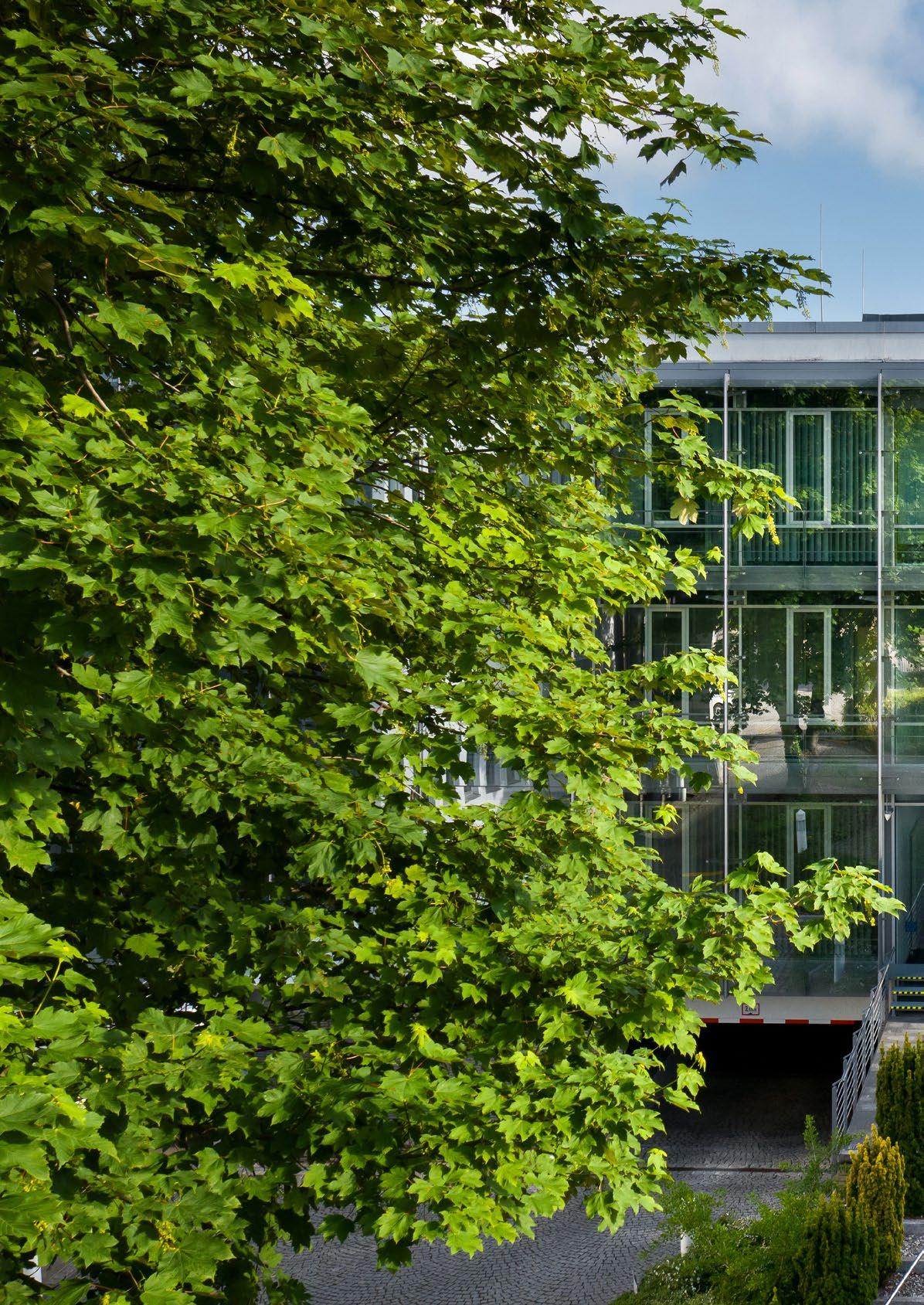
Sustainability is an evolutionary process, as we wrote in our last report. One year on, the world of energy supply has indeed changed and has a new focus in the public spotlight. It is no longer just a question of which type of energy we use, but of where it comes from. We are taking responsibility for this new dimension of energy supply, with an evolutionary approach to expanding our understanding of sustainability in what we call
This report shows you how we are implementing this concept.

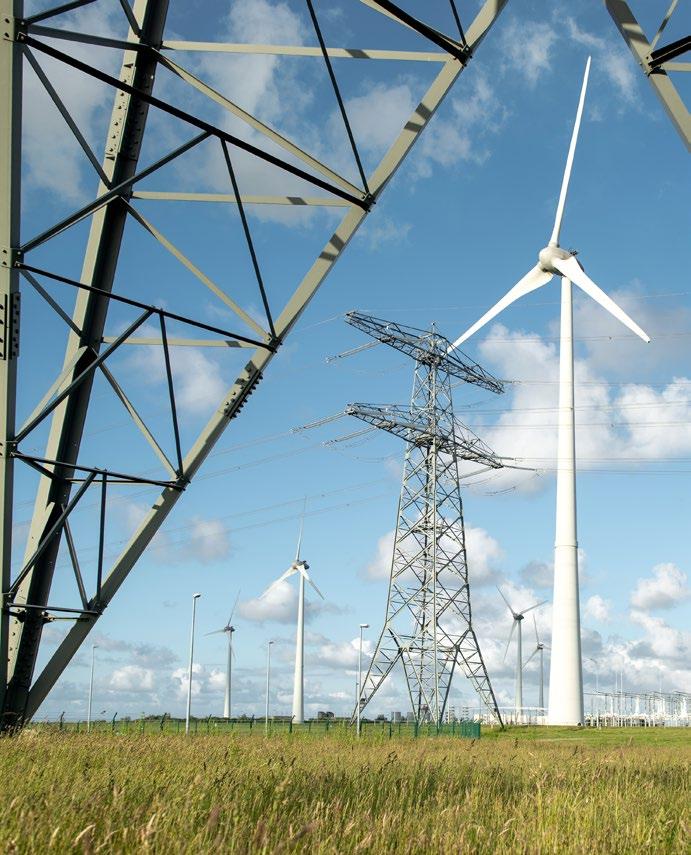
MR. WAGNER, LAST YEAR’S FOCUS WAS ON ACHIEVING AN IMPACT AND, ESPECIALLY, REDUCING CO2 EMIS SIONS. WHAT DO YOU SEE AS THE NEXT LEVEL?


The dreadful conflict in Ukraine has made it clearer to everyone that sustainability is not only about providing clean energy.
Just as important is the provenance of the energy. For ex ample, no one wants to finance Russia’s war. This is nothing new within the context of good governance – the G in ESG. Previously, however, the public focus was on environmental

“IMPACT IS NOT ONLY ACHIEVED WITH ONE SOLUTION: FOR A BETTER WORLD, WE NEED LOTS OF INTELLIGENT SOLUTIONS, BOTH LARGE AND SMALL.”
“GETEC is committed to the sustainable development of the energy industry, espe cially in the fields covered by our customer segments of industry and real estate. We are taking responsibility in the energy transition, focusing on intelligent and sustainable energy solutions – GETEC green solutions – to reduce greenhouse gas emissions in the industry and real estate segments. In this way, we aim to combat climate change, improve people’s lives and create a future that offers a high quality of life. We aim to advance and foster diversity, inclusion and integration. We are committed
THOMAS P. WAGNER GROUP CEOprotection. Now, the various stakeholders – industry, the real estate sector, suppliers, government and the public – are real izing that the two aspects can’t simply be improved overnight. Other considerations are involved as well, including supply reliability and energy costs. That is why we are now experi encing a very serious and very important debate about how to transform energy supply.
IT’S UNLIKELY THAT YOU ARE GOING TO SIT BACK AND WAIT FOR THE OUTCOME OF THIS DEBATE: WHAT IS GETEC DOING SPECIFICALLY?
Energy supply is always dependent on political decisions and going it alone would not be helpful. However, we do have lots of innovative concepts which are setting new standards and delivering solutions to a number of issues. We will be present ing some of them in this report. For example, we will supply the Blurado business park in Radolfzell in southern Germany almost entirely from geothermal sources. In other words, we will harness the underground heat from beneath the region’s fields. This form of energy supply is both autonomous and en vironmentally friendly. There are other examples as well: the ice storage system in Nuremberg, the use of AI by GETEC Italia to save energy, or our Waste-to-Value concept for generating energy from industrial waste products.
to acting responsibly and transparently, thus fulfilling the trust placed in us by our custom ers, our employees and society in general. This means that we consider both the short-term and long-term impacts on the environment and on society in the decisions we make every day, at the same time focusing on the needs of the present and future generations.”
You will find the strategy from the GRI Perspective on page 24.
We believe in the evolutionary approach of impact. This is not achieved by just ONE solution, ONE law or ONE industry. In abstract terms, a better world needs lots of intelligent solu tions, both large and small. Consumers can achieve an impact through their own behavior. And we can achieve an impact by finding as many good solutions as possible and working with our customers to implement them. In March 2022, we were able to observe just how varied these solutions are. On the one hand, there was a fantastic donation campaign initiated by our employees for a Ukrainian organization which looks after orphans. This is quick and direct help. At almost the same time, we were part of the delegation that accompanied Germany’s Economics Minister, Robert Habeck, on a trip to Qatar to secure supplies of liquid gas, ammonia – which is an energy carrier – and, for the future, green hydrogen. This will help strategically in the medium term. We simply need to think flexibly and work together to identify solutions which will ensure a better future for the next generation.
EU and national GETEC
NFRD was defined in 2014, came into force in 2018 and was updated in 2020 to align with ESG-focused regulations
CSRD adopted late May RED II adopted by Member States by June 30
Conducted ESG mate riality assessment
· Started reporting in respect of ESG KPIs ESG board committee established
Regular reporting Head of ESG appointed Scale-up of green solutions portfolio
CO2 accounting model devel oped
Emission reduction achieved 610 ktCO2 p.a. by end of 2020 (Scope 1, 2, 3), 59 kt thereof Scope 3 EcoVadis review of a GETEC company
Integration of Italian platform into the Group
Updated ESG material ity assessment
Sustainability report in accordance with GRI and SASB standards UN SDG analysis and inclusion in reporting Assessment of ESG risks in supply chain Net zero roadmap developed EcoVadis rating of GETEC Group
sustainability
stan dards, October 31
Sustainability report updated to reflect CSRD requirements
Critical mass of cus tomers signed up to Green Steam program for lignite exit
Emission reduction targets -3,158 ktCO2 p.a. by end of 2030 (Scope 1 & 2 only) 2021 Sustainability Report targets implemented in social and governance areas Group-wide lignite exit with closure of last European site
exit in Germany




GETEC is one of Europe’s leading energy suppliers and con tracting specialists in the industry and real estate segments

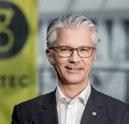



Our value statement “We have the energy for more” guides our some 2,200 employees at more than 50 sites who apply their excellent engineering skills, outstanding regulatory knowledge, proven swiftness and extensive sustainability ex pertise in helping our customers to navigate the increasingly complex energy landscape.
We see ourselves as THE partner for our customers when it comes to delivering smart, efficient and green energy solu tions. Sustainability, cost-effectiveness and the careful use of resources have been anchored in our DNA from the very start and are permanent components of our ESG strategy. In this way, we support our customers in improving their carbon footprint and have our sights fixed firmly on the future, thus making a difference for generations to come.
Shareholders Sites in nine countries
Since 4/2022
Advised by J.P. Morgan Asset Management

Head office: Magdeburg, Germany

Bruinenberg (labo ratory technician), Bianca Tijman op Smijers (QHSE manager), Roel Braam (busi ness process engineer) and Rick ten Velde (controller) in Eemshaven, Netherlands. This is where hydrogen will soon be transferred to the Emmen multiclient site. We are also proud of this achievement.
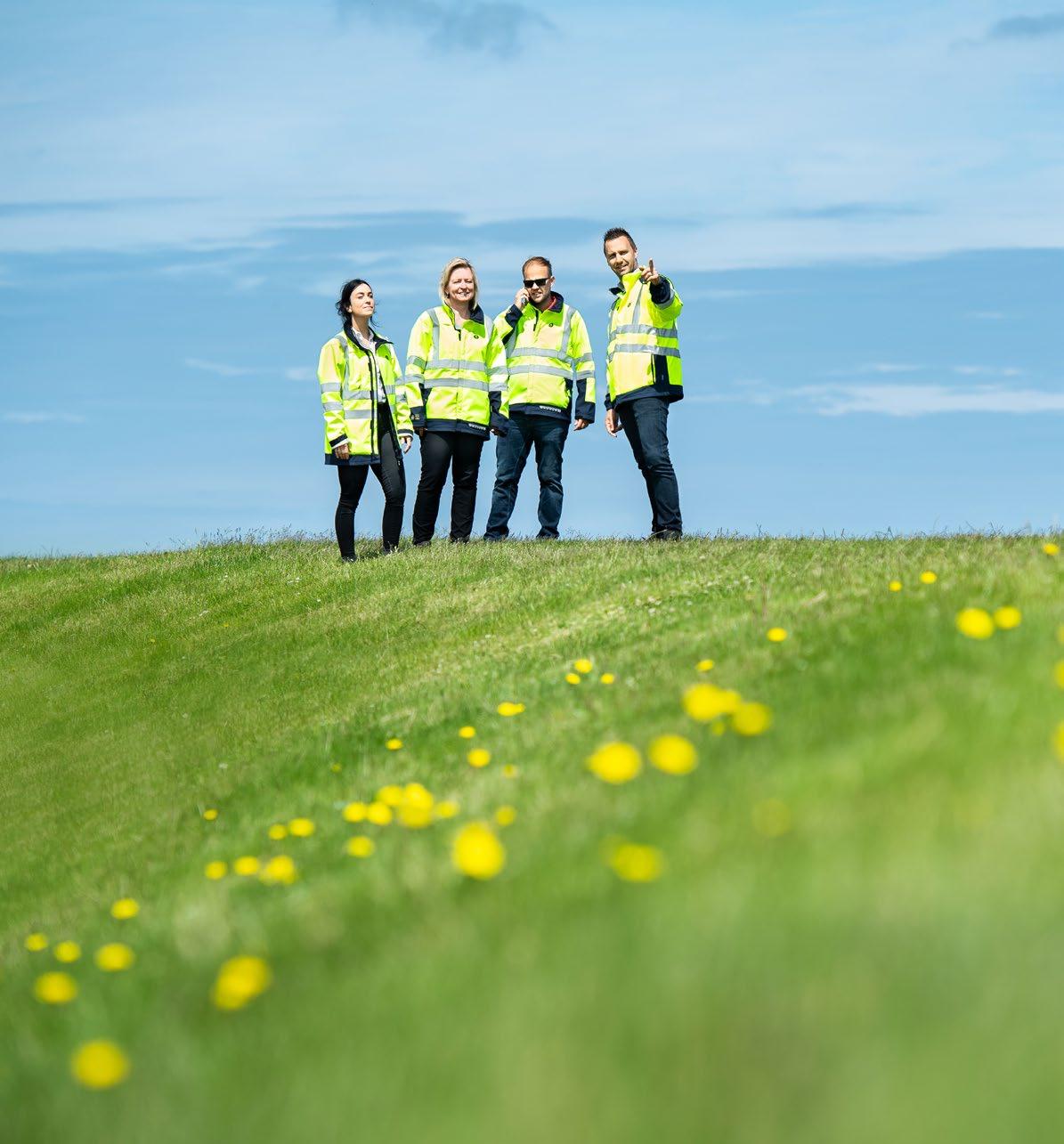
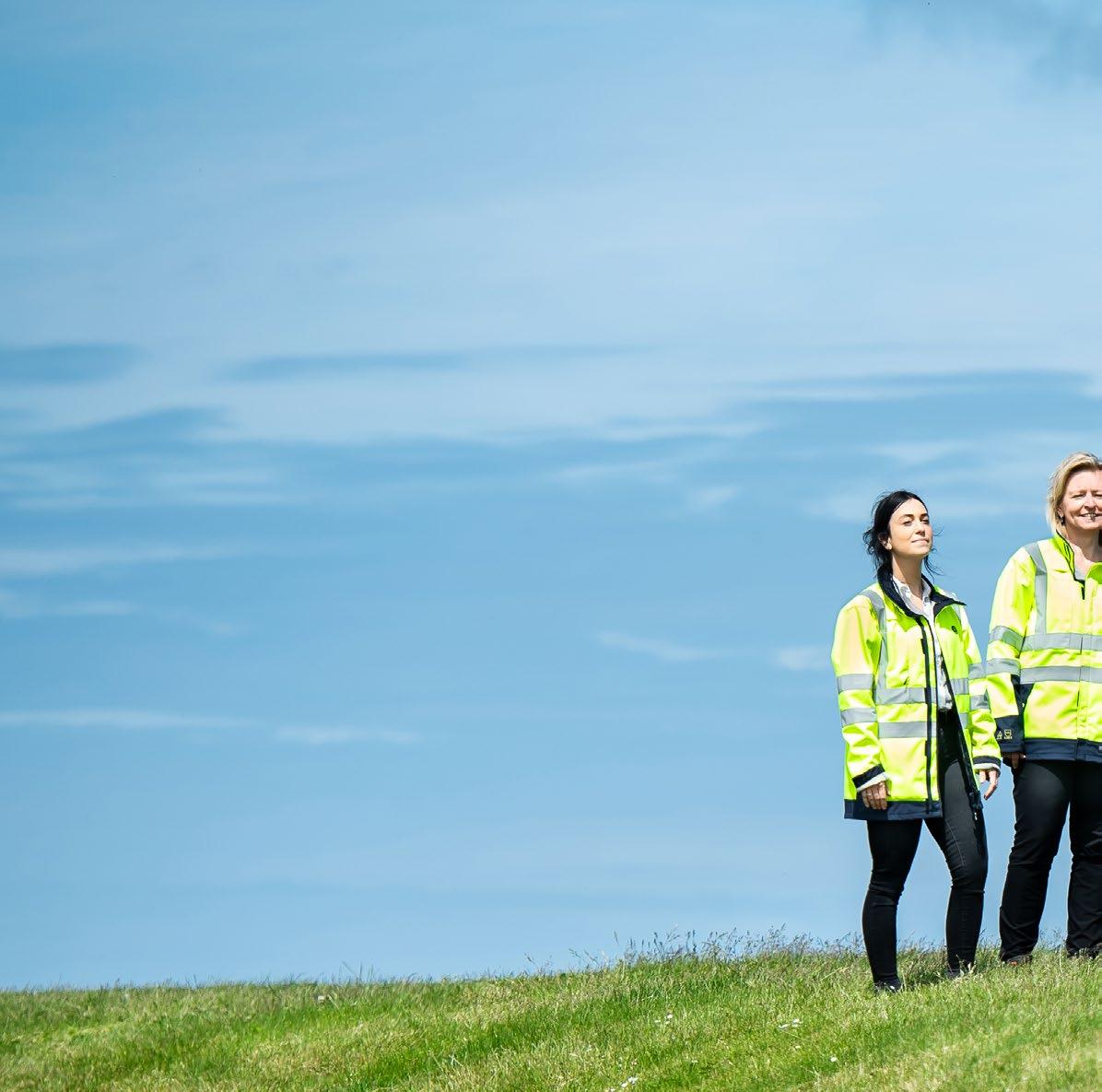
We offer our customers in the industry and real estate segments a comprehensive package of outsourced energy solutions. Across the value chain, we implement energy supply and energy reduction contracts that deliver precisely the cost-effectiveness and sustainability our customers need.
Developing ideas and planning sus tainable concepts with optimal use of local energy market regulations Integrated energy con trolling and billing
Transparent energy procurement and management, fuel and CO2 management Data-driven maintenance, remote interventions, AI-based optimized service via our 24/7 Smart Control Center
Approval processes, applications for subsidies and subsequent emissions reporting
Operations management based on digitalized pro cesses and systems
Financing of invest ments for contract term
Implementation, design and plant construction with full Internet of Things functionality
Demographic change, affordable housing, climate-neutral supply concepts, e-mobility and digitalization are just some of the challenges currently faced by the real estate and building sectors.

Whether for the private residential market, commercial, co operatives, developers or public housing – we develop, finance and implement full-service green solutions for real estate, for example, in smart districts or in the joint venture model. We are the single-source provider of heating, cooling, electricity, site networks, CO2 monitoring, e-mobility and the smart networking of all elements tailored to customers’ needs. With us as their outsourcing partner, customers can lower their energy costs, substantially reduce their carbon footprint and enjoy maximum supply reliability, enabling them to concentrate on their own core business.
Whether our customers are active in the chemical and phar maceutical industry, food or paper production, the materials or automotive industries: GETEC delivers exactly the sustain able, smart and efficient solutions they need. We support our industry customers as they work toward achieving net zero production, at the same time ensuring cost-effectiveness and reliability of supply. In developing our solutions, we consider the entire value chain – whether we are working with one customer at a single-client site or with many industrial cus tomers at multiclient sites like the GETEC parks in Muttenz, Switzerland, and Emmen, Netherlands.


We operate at a range of geographical locations that we have named “regional platforms,” which are responsible for the countries in which they are located and for some neighboring countries, efficiently implementing GETEC’s European growth strategy. Each platform offers a broad range of services from our extensive Group portfolio of solutions and operates independently in its regional environment. In this way, we ensure rapid decision-making for our customers while fully benefiting from the advantages of being a medium-sized enterprise. Since our aim is to meet our responsibility across Europe, we apply the philosophy of thinking globally but acting locally. This philosophy is implemented by a management structure that has defined a number of geographical centers.
Each platform strengthens the company’s local business operations and the Group as a whole. In addition, competence centers ensure that each business area’s specific expertise contributes to the Group as a whole. Platform Italy, for example, is contributing an innovative approach to using artificial intelligence (see story on page 136). Switzerland is delivering expertise to all platforms in the area of waste-to-value (see story on page 58). And lastly, all the countries benefit from the innovative hydrogen solutions from Platform Netherlands (see story on page 118) –to name just a few of our competence centers.
This platform strategy and close networking also benefit GETEC’s ESG commitment. The company’s ESG concept is anchored in its broad operational presence and enables the company to satisfy country-specific regulations and business requirements while complying with the relevant EU regulations and global agreements at the same time.


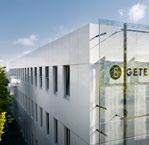


G+E GETEC Holding GmbH Magdeburg, Germany
100% Golf BidCo GmbH
GETEC heat & power GmbH Magdeburg, Germany
100% G+E GETEC Holding GmbH
GETEC Polska sp. z o. o. Turek, Poland
100% GETEC heat & power GmbH
GETEC Energia sp. z o. o. Turek, Poland 100% GETEC heat & power GmbH
GETEC Zielona Energia sp. z o. o. Turek, Poland 100% GETEC heat & power GmbH
GETEC Projekty Przemyslowe sp. z o. o. Turek, Poland 100% GETEC heat & power GmbH
ENERSERV GETEC GmbH Vienna, Austria 100% GETEC heat & power GmbH
GETEC SERVICII ENERGETICE S.R.L. Bucharest, Romania
95% GETEC heat & power GmbH
5% Lehniner Fernwärme u. Betriebs GmbH
GETEC Switzerland AG Muttenz, Switzerland
100% GETEC heat & power GmbH
GETEC PARK.SWISS AG Muttenz, Switzerland
100% GETEC heat & power GmbH
ARA Rhein AG Pratteln, Switzerland
48.11% GETEC PARK.SWISS AG
Industriefeuerwehr Regio Basel AG (IFRB) Muttenz, Switzerland
25% GETEC PARK.SWISS AG
GETEC Energy Efficiency B.V. Emmen, Netherlands
51% GETEC Infra NL B.V.
Emmtec Services B.V. Emmen, Netherlands 100% GETEC Infra NL B.V.
Bioenergie Wächtersbach GmbH Wächtersbach, Germany
64.9% GETEC heat & power GmbH
Carbotechnik Energiesysteme GmbH Geretsried, Germany 75.49% GETEC heat & power GmbH
Borchers Biomassekraftwerk GmbH Borken, Germany 50% GETEC heat & power GmbH
Magdeburger Bau- und Schulservice GmbH Magdeburg, Germany 40% GETEC heat & power GmbH
GETEC BBE GmbH Magdeburg, Germany 100% GETEC heat & power GmbH
LEHNINER Fernwärme und Betriebs GmbH
Kloster Lehnin, Germany 100% GETEC heat & power GmbH
KG Energo s.r.o. Prague, Czech Republic
50% GETEC heat & power GmbH
Albert-Vater-Straße 50 Verwaltungs GmbH Magdeburg, Germany 100% GETEC heat & power GmbH
Albert-Vater-Straße 50 Verwaltungs GmbH Magdeburg, Germany General partner: Albert-Vater-Straße 50 Verwaltungs GmbH 94.50% GETEC heat & power GmbH 5.5% Heidelinde Gerhold
GETEC Infra NL B.V. Emmen, Netherlands
100% GETEC heat & power GmbH
GPE logistiek B.V. Emmen, Netherlands
100% GETEC Infra NL B.V.
Enven Green Energy B.V. Emmen, Netherlands
51% GETEC Infra NL B.V.
Emmtec Green Steam B.V. Emmen, Netherlands
51% GETEC Infra NL B.V.
GETEC Wärme & Effizienz GmbH Magdeburg, Germany 100% G+E GETEC Holding GmbH
Bayernwärme GmbH Magdeburg, Germany
100% GETEC Wärme & Effizienz GmbH
G+D Gesellschaft für Energiemanagement mbH Magdeburg, Germany 51% GETEC Wärme & Effizienz GmbH
Stadtwerke Thale GmbH Thale, Germany 100% G+D Gesellschaft für Energiemanagement mbH
GETEC efficiency solutions GmbH & Co. KG Berlin General partner: GETEC efficiency solu tions Verwaltungs GmbH
Limited partners: 51% GETEC Wärme & Effizienz GmbH 49% CEKA Holding GmbH
GETEC efficiency solutions
Verwaltungs-GmbH Berlin, Germany 100% GETEC efficiency solutions GmbH & Co. KG*
Energie für Schleswig-Holstein GmbH Kiel, Germany 50% GETEC Wärme & Effizienz GmbH GDB Infra GmbH Magdeburg, Germany 51% GETEC Wärme & Effizienz GmbH
PionierWerk Hanau GmbH Hanau, Germany 50.1% GETEC Wärme & Effizienz GmbH
Verwaltungs-GmbH Berlin, Germany 100% GETEC Wärme & Effizienz GmbH
G+P energy solutions GmbH & Co. KG Berlin, Germany
General partner: G+P energy solutions Verwaltungs-GmbH
Limited partners: 51% GETEC Wärme & Effizienz GmbH 49% g+p energy solutions Beteiligungs GmbH
QETEC Energieeffizienz GmbH Berlin, Germany 51% GETEC Wärme & Effizienz GmbH
Re+Start GmbH Magdeburg, Germany 51% GETEC Wärme & Effizienz GmbH
G&H Energy GmbH Magdeburg, Germany 51% GETEC Wärme & Effizienz GmbH
Mondstein 441. GmbH Koblenz, Germany
GETEC Wärme & Effizienz GmbH
GETEC Energy Horizon GmbH Magdeburg, Germany
GETEC Wärme & Effizienz GmbH
G+Q Effizienz GmbH Berlin, Germany
51% GETEC Wärme & Effizienz GmbH
G+G Energy Services GmbH Berlin, Germany 49% GETEC Wärme & Effizienz GmbH
BETEC Energieeffizienz GmbH Berlin, Germany
51% GETEC Wärme & Effizienz GmbH
GETEC Wärme & Effizienz GmbH Nord Hamburg, Germany 100% GETEC Wärme & Effizienz GmbH
GETEC energy efficiency GmbH Magdeburg, Germany 100% GETEC Wärme & Effizienz GmbH
G+L Energieeffizienz GmbH Magdeburg, Germany
GETEC Wärme & Effizienz GmbH
G+A Energy Efficiency GmbH Magdeburg, Germany
GETEC Wärme & Effizienz GmbH
GETEC Green Heating GmbH Magdeburg, Germany 74.9% GETEC Wärme & Effizienz GmbH
GETEC smart energy GmbH Magdeburg, Germany 50.1% GETEC Wärme & Effizienz GmbH
G+N Energieeffizienz GmbH Magdeburg, Germany 51% GETEC Wärme & Effizienz GmbH
G+M energy efficiency GmbH Magdeburg, Germany
GETEC Wärme & Effizienz GmbH
GETEC Contracting GmbH
Osnabrück, Germany
100% G+E GETEC Holding GmbH
GETEC green solution GmbH i.G. Berlin, Germany
50.1% GETEC Wärme & Effizienz GmbH
GETEC energy solutions GmbH i.G. Magdeburg, Germany
51% GETEC Wärme & Effizienz GmbH
FFIRE Energy GmbH Berlin, Germany
51% GETEC Wärme & Effizienz GmbH
GET New Energy GmbH Kempfen, Germany
51% GETEC Wärme & Effizienz GmbH
CERO2 GmbH Großbottwar, Germany
51% GETEC Wärme & Effizienz GmbH
INBRIGHT Energy GmbH Berlin, Germany
51% GETEC Wärme & Effizienz GmbH
GETEC Mieterstrom GmbH Magdeburg, Germany
51% GETEC Wärme & Effizienz GmbH
GETEC Energy Management GmbH Magdeburg, Germany 100% G+E GETEC Holding GmbH
Legal
GETEC Kundenservice GmbH Magdeburg, Germany
100% G+E GETEC Holding GmbH
TREVISO GS4 Società Consortile a Responsabilitià Limitata Zola Predosa (Bologna), Italy
19% GETEC Italia S.p.A.
Laboratorio Energia e Ambiente Piacenza (LEAP) S.C. a r.l. Piacenza, Italy 10.60% GETEC Italia S.p.A.
Consorzio Stoccaggi e Mercato Gas I. L. Milan, Italy 1.234% GETEC Italia S.p.A.
ATMOS S.r.l. Gragnano Trebbjese (Piacenza}, Italy
99% GETEC Italia S.p.A.
MESOS S.C. a r.l. Gragnano Trebbjese (Piacenza), Italy 70% GETEC Italia S.p.A.
GETEC Italia S.p.A. Gragnano Trebbjese (Piacenza), Italy 100% G+E GETEC Holding GmbH
Energy Wave S.p.A. Alessandria, fraz. Spinetta Marengo
100% GETEC Italia S.p.A.
REAM S.p.A. Alessandria, fraz. Spinetta Marengo 49% Energy Wave S.p.A.
1. Total number of employees ~2.200
2. Total number of operations
Number of sites: 56 Number of companies: 72
3. Net sales ~€985 million in 2020
4. Total capitalization broken down in terms of debt and equity ~€2.016 billion balance sheet total ~€1.380 billion debt ~€636 million equity
Total number of employees: ~2,200
Employment contracts (temporary/permanent):
Almost all our employment contracts are permanent.
Employment type:
Most of the company’s activities are performed by workers who are employees. There is no significant amount of seasonal work.
Employees by gender (GETEC Group):
GETEC has a presence in nine European countries and has an international workforce. We employ people from the following countries:
Bosnia and Herzegovina Bulgaria Denmark and Faroe Islands Germany France
India, including Sikkim and Goa Iran Italy Colombia Croatia Lebanon Netherlands Austria
Poland Portugal Romania Russian Federation Switzerland Serbia Spain Syria Tunisia Turkey Ukraine Vietnam Belarus
In response to the large growth of the GETEC Group, new structures were implemented at the start of 2022. Four regional GETEC platforms in Germany, Italy, the Netherlands and Switzerland now operate under the um brella of the GETEC Group to provide energy solutions to customers in a total of nine countries. In the future, this platform approach will enable GETEC customers to benefit from the expertise of the entire Group, coupled with the proximity to regional contacts and short decision-making routes.
In April 2022, Infrastructure Investments Fund (IIF), an investment company advised by J.P. Morgan Asset Management, acquired all shares in G+E GETEC Holding GmbH and all its subsidiaries and affiliates from EQT Infrastructure III and GETEC Energie Holding GmbH. Platform Italy has been fully integrated into the GETEC Group, initially in technical and organizational terms during 2021, followed by brand integration in 2022.

Risk management is an integral part of GETEC’s business processes and forms the basis for key decisions made by the company. The company’s uniform principles and control standards for risk assessment were verified during ISO 9001 certification. They are regularly adapted to current requirements on the basis of internal or external audits. A risk management report systematically and continuously documents the risks that have been identified, describes and assesses the measures that have been initiated to handle the risks, and serves to mitigate threats or at least render them manageable. The company’s Controlling Department performs regular and detailed analyses throughout the year to assess developments at project level. On this basis, we are able to identify and analyze any deviations from our business plan so that we can take suitable measures to control them. Uniform reporting throughout the Group is a further effective tool that enables the Group Executive Committee (GEC) and the Advisory Board to identify and minimize risks. Reporting throughout the fiscal year about the GETEC Group, the regional platforms, the Industrial and Real Estate segments and the main (individual) entities allows continuous monitoring of business performance.


In addition to its role as a strong employer in various regions and at the regional platforms in Europe, GETEC is a corporate citizen which assumes social responsibility in many different ways. Alongside major charitable donations, such as the support of the company and its employees for the Ukrainian Ridni Foundation for or phans within the context of corporate volunteering (see the report about Ridni in the Social chapter starting on page 96), there are a number of external initiatives at the individual GETEC platforms which are explained in detail in the appendix. In addition, GETEC is active in many associations, increasingly assuming its responsi bility as an expert and a pioneer of the energy transition in the political and regulatory environment. Through our work in associations, we consider ourselves a trendsetter when it comes to innovative solutions and business models aimed at advancing decarbonization. There follows a list of our activities and memberships. See the appendix for a complete list.

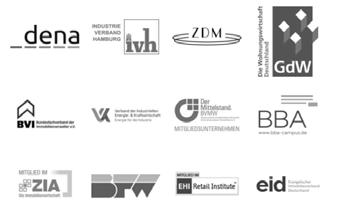
Carbon neutrality by 2045 – five years sooner than required by the European Union: That is the vision we are aiming to realize with our sustainability strategy. In accordance with this objective, we have developed an ambitious roadmap with clear milestones for making our portfolio climate-neutral in the long term. Our customers, in particular, will benefit from the complete decarbonization we are working to achieve. We see our role as supporting industry and the real estate sector in developing their own net zero strategies in a cost-effective and sustainable way. Year for year, we aim to provide “greener” steam, heat and electricity to our customers. You will find an overview of our ESG Roadmap on page 10. Our route to carbon neutrality is based on three key elements: CO2 emissions accounting; the CO2 emissions forecast model; and our Technology Roadmap built on green technologies and environmentally friendly fuels. We are focusing on intelligent and sustainable energy solutions (green solutions) in order to reduce green house gas emissions.
Our path to transformation therefore means shifting away from fossil fuels to producing green energy. Nu merous measures have already been initiated. Above all, we are improving our ESG reporting and management processes in order to establish a strong basis for the next steps. The planned packages of measures are spread across the following six strategic strategic fields of action:
1 GETEC is the decarbonization solution partner with a full range of services for future market needs
2 Thriving deployment of new green technologies while being agnostic to technologies and manufacturers
3 GETEC operates in an attractive, policy-supported and resilient market environment
4 Undisputed market leader with an increasing pan-European footprint
5 Superior growth prospects via multiple growth pillars in core business and via M&A platform
6 Commercial and operational excellence supported by leading digital products and services
GETEC is an integrated energy solution provider on both the (energy) supply and energy savings sides, supporting customers in achieving their CO2 targets and enabling the energy transition to a net zero carbon world with clean and innovative (and often single-source) solutions. GETEC is theoretically1 already net zero today.
GETEC is ready to deploy proven new technologies on the supply side in high-growth areas such as renewable sources, P2X and hydrogen across all end industries, being uniquely positioned with established interfaces and relationships to all key manufacturers of equipment and systems, while being highly agnostic and OEM-independent.
Attractive market poised for strong growth driven by a continuous trend to outsource energy solutions due to increasing complexity and environmental requirements and policy support from the European Green Deal and national climate projects; high resilience to economic downturns because of the contract nature of the market.
GETEC is the clear market leader in Germany with a growing European footprint driven by strong competitive advantages over peers thanks to clear sales and technology leadership and regulatory expertise; successfully entered adjacent geographic markets (e.g., Italy, Switzerland, Netherlands) by leveraging strong capabilities from the German market.
Tangible medium-term growth prospects driven by secured order backlog (and growing markets) and ideal position to unlock untapped opportunities on the demand side; thrust to expand into attractive EU markets and uplift other companies via existing platforms and track record from Italy, Switzerland and Netherlands.
Strong track record in sales and project execution (time and budget) supported by fully imple mented digital processes (e.g., FSM solution, asset digitalization); additional advantage from being the industry innovation leader with internal digital capabilities and successful digital product rollouts paving the way for the next growth wave.
1. Gas and lignite dust portfolio can already be powered with biogas, synthetic gas or biomass dusts today. Usage is driven by political incentives to make these more expensive fuels attractive for customers. Source: BCG analysis
We have identified all groups with an interest in our company as our stakeholders. Our (internal and external) stakeholders include our employees, customers, suppliers and service providers, investors and shareholders, authorities, associations and NGOs.
There are no collective bargaining agreements for the employees of the Germany platform. In Switzerland, 39 percent of employees are covered by collective employment agreements (Gesamtarbeitsverträge, GAV). All platform employees in the Netherlands are covered by collective employment agreements (Collectieve Arbeidsovereenkomst, CAO). Likewise, all our employees in Italy are covered by the national collective bargaining agreement (contratto collettivo nazionale di lavoro, CCNL).
The three main drivers of decarbonization in energy supply are the legislator, our customers and, above all, our own expectations. The energy transition thus harbors numerous opportunities and risks for our business model, as detailed in the disclosure on GRI 102-15.
Our sustainability strategy covers environment (E) issues, which are directly related to our core business, as well as our action plans in respect of social (S) and governance (G) issues, which we aim to implement by 2030. As a result of growth, our company has increased its ethnic and cultural diversity in recent years. We aim to build on this and have defined goals for diversity and equal opportunities. The publication of annual sustainability reports and ESG evaluations by EcoVadis are important steps toward achieving transparency. A dedicated committee at management level is responsible for continuously raising our ESG performance. We are committed to acting responsibly and transparently, thus fulfilling the trust placed in us by our customers, our employees and society in general. This means that we consider both the short-term and long-term im pacts on the environment and on society in the decisions we make every day, We document our progress in achieving the targets set in 2021 and the comparison of key performance indi cators in the corresponding chapters of this ESG Report. It also details the action plans we have developed as interim milestones on our 2030 timeline. Our overarching vision is to curb climate change and create a future worth living for the next generations. We aim to achieve this as a company which is dedicated to fairness.
Our ESG statement – “Making a difference for generations to come” – has become our company’s core mission. Through our conduct, we aim to have a positive and sustained impact on society, the markets and the environment. In order to achieve this aim, we have initiated a large number of action plans at both Group and platform level. When justifying the materiality of the issues we address, we analyze the impact of our business operations in detail.
As a company that operates in the energy sector, GETEC is subject to various uncertainties and the associated risks, but can also benefit from opportunities. The use of energy in the form of heat or electricity can be considered a basic human need of our affluent society. It presents GETEC with the challenge of ensuring the permanent supply of energy.
Since the start of 2022, geopolitical changes have forced us to realign energy provision and focus on more independence in energy procurement. We will describe these challenges in more detail in the “Compliance” chapter. However, even in previous years, statutory decisions were taken with the aim of driving progress in the energy transition and promoting the use of renewable energy.
This also defines the path taken by GETEC: developing environmentally friendly, efficient but affordable energy solutions for its customers. Here, GETEC is seeking to do justice to its pioneering role as Europe’s leading energy services provider in the field of energy supply contracting, defending and growing this position against other market participants. Thanks to long-term customer contracts and future energy requirements (energy will always be needed), GETEC has a business model which offers reliability to its stakeholders – employees, investors and other business partners.
When it comes to sustainability trends, GETEC is able to exploit many opportunities and deliver a strong con tribution to reducing emissions of CO2 and other greenhouse gases, which are responsible for global warming.
As a first step, GETEC is replacing pulverized lignite with biomass and modifying existing plants accordingly. In principle, all fossil fuels (gas and oil) can be replaced with biomass, green hydrogen or green electricity. GETEC is also increasing its focus on heat pumps.
Digitalization: While advancing digitalization improves business processes and the efficiency of plant man agement, it also exposes us to the growing risk of cyber crime which can result in disruption to operations, plant outages and damage. Our employees especially can unwittingly give attackers access to the company. That is why we offer training and awareness programs, alongside strengthening our company-wide security systems, so that we can continue to exploit the clear benefits of digitalization.
Price fluctuations: The evolution of the energy markets also represents a constant risk that is difficult to assess. Prices are very volatile and in recent months have only increased. GETEC is continuing to optimize its procurement strategy to protect itself and its customers from extreme volatility and ensure a high degree of planning security for both sides. This also means optimizing the Technology Roadmap to expand the range of options available.
Regulatory changes: GETEC must comply with stringent statutory regulations in order to operate its facili ties. The company must be prepared for regulations to be tightened or changed if it is to avoid plant outages and the loss of its licenses to operate. To this end, Platform Germany has established a Regulatory Group (see below) which enables GETEC to create a basis of trust for existing and future stakeholders who depend on reliable energy supplies that comply with both current and future standards and legislation. Risk of outages and damage: Also important are other precautionary measures such as regular plant inspections to avoid technical outages or damage (explosions or leaks) which can have a substantial impact on people and the environment. Moreover, both our customers and GETEC itself profit from a reduction in outage time as well as efficient and reliable plant utilization.
Energy transition: Thanks to its extensive expertise, GETEC can provide its customers with (cost-)effective, green energy solutions, at the same time helping them to reduce their carbon footprint. In addition, the contracting business plays a key role in decentral energy supply.
GETEC has established a regular information and dialog group for discussing legal issues in connection with industry regulation in the Platform Germany region. The participants are selected in consultation with man agement and represent the entire value chain, including peripheral administrative functions. On the one hand, the participants contribute topics for discussion and, on the other hand, they take information and working mandates back to the operational organization. They thus serve as multiplicators to disseminate knowledge to their respective business areas.
The Regulatory Group addresses those legislative changes which already have legal character. In this context, a legislative change is either a change to an existing legal position or the creation of a new one. In Germany, laws and regulations are considered to have legal character from the time a ministerial draft exists. At EU level, a Commission draft is a document with legal character.
In addition, an overarching Regulatory Group Steering Committee is to be implemented in the medium term to promote dialog on regulatory issues at platform level. Its focus will be on selected EU legislative topics and their impact on national law in the GETEC platform regions.
Since 2021, GETEC has expanded its implementation of a Group-wide risk management system aimed at improving the management of the company through early risk identification and response, thus reducing planning deviations.
We use expert opinions to identify risks and scenarios that could jeopardize the existing business, quantify the extent of the damage they could cause and estimate the frequency of their occurrence. We then aggregate these scenarios for use in a Monte Carlo simulation to determine the potential extent of the overall damage or the overall risk to the GETEC Group. We then compare this with the overall risk coverage potential of the GETEC Group. If coverage is insufficient, direct measures must be implemented to reduce the potential level of damage that could be caused by one or several risks and thus avoid jeopardizing the existing business at an early stage. In addition, countermeasures must be implemented for all risks. It must then be monitored whether the risks have been reduced and are under control.
In 2022, as part of the continuous improvement of the risk management system, the GETEC Group Risk Policy will be published across the company. It is aimed at fostering understanding of the value added by a risk management system and helping to establish a risk culture throughout the company.
As one of the leading contracting specialists in Europe, we are committed as a participant in the UN Global Compact and we are committed to its ten principles and the 17 Sustainability Development Goals (SDGs) of the United Nations. Our business operations give us the greatest influence on SDGs 7, 9, 11 and 13 and we make an important contribution to SDGs 3, 5 and 8.

We are supporting our customers en route to net zero, helping them switch to low-emission and emis sion-free forms of steam, heat, refrigeration and electricity generation in an appropriate and cost-efficient way. We are making a significant contribution to increasing the share of renewable energy. With our waste-to-energy approach, we are specifically considering the circular economy in our solutions.
SDG 9: Industry, innovation and infrastructure
Thanks to innovative products and services, we are fostering the sustainability of energy supply, using our state-of-the-art solutions to help other companies decarbonize their processes.
SDG 11: Sustainable cities and communities
We also help cities and districts cope with the energy transition and become more sustainable and energy-ef ficient – for example, with our districts of the future and sustainable district heating solutions.
SDG 13: Climate action
Through our innovative solutions and services, we help our customers to improve their energy efficiency and lastingly reduce their CO2 emissions. Our waste-to-value approach recycles key raw materials and waste products, thus preserving valuable resources.
SDG 3: Good health and well-being
Our 360° Safety Culture focuses on the health and protection of our employees. It is our priority to ensure workplace safety and to promote health and mental well-being. During the COVID-19 pandemic, we imple mented extensive protective measures.
SDG 5: Gender equality
Our focus is on equal opportunities for all genders and on promoting inclusion and diversity. We aim to foster and benefit from diversity.
SDG 8: Decent work and economic growth
We take responsibility by creating and maintaining decent and viable workplaces. In the future, we aim to anchor human rights and social and environmental standards more strongly in our supply chains.
We have identified all groups with a fundamental interest in our company and with an interest in sustainabili ty and innovation in the energy sector as our stakeholders. Our (internal and external) stakeholders therefore include our employees, customers, suppliers and service providers, investors and shareholders, authorities, associations and NGOs.
External Customers
Invitations to webinars on specific issues such as the CO2 levy, climate policy and its impact on customers’ business models, regular information about GETEC and regulatory changes
Annual customer meetings
Annual customer surveys
Investors (banks and insurance com panies)
Government and associations, local authorities
Regular contact with the top management and special ist departments of banks and insurance companies
Annual meetings with lenders that include an extensive Q&A round and detailed information about GETEC’s strategy and market concept
Association activities on the basis of memberships Political dialog Ongoing dialog
Suppliers Information to service providers
Valuable collaboration for both parties
General public, NGOs Several partnerships/initiatives with cities (for example, Hamburg), industry stakeholders (for example, ZIA, DENEFF), science (for example, New Energy Coalition, IQ Innovation Prize), society (for example, Diversity Charter, Alexander Otto Sportstiftung)
Internal Employees Intranet, emails to employees, internal newsletter
Employee engagement survey
Regular meetings (inter- and intradivisional)
Annual employee dialog meetings Works council
Shareholders, Advisory Board
Regular meetings to consult with shareholders
Regular Advisory Board meetings
Feedback on energy issues of relevance to customers, for ex ample, green energy solutions, efficient processes, regulatory aspects
Direct feedback on a broad range of issues including: How is GETEC perceived by customers? How are customers’ requirements implemented? How do customers assess GETEC’s services?
Dialog concerning strategy and business model, feedback from the capital markets
Information about what banks and insurance companies expect from GETEC in terms of sustainable financing and ESG
Dialog on energy policy and similar issues
Legislative changes
Market developments
Positions on specific energy and environmental issues
Information about changes to the business, innovations
Ongoing dialog, discussions and feedback on relevant issues and initiatives
Information about project developments
Information on corporate goals, strategy and culture
Discussions and feedback on company topics, processes and optimization of procedures
Dialog about the promotion and development of employees
Strategic consultation and transparent information about managing opportunities and risks
Consultation/performance assessment in all business areas
In identifying our stakeholders, we started by analyzing the demands, interests and expectations each group has concerning our company. These were obtained either from direct dialog, via the business model itself or by analyzing documents such as position papers, white papers or similar. The next steps involved dividing the various groups into internal and external groups and prioritizing the external groups. We then clustered the internal stakeholder groups in smaller units: employees, shareholders and Advisory Board. The external stakeholders who have expectations of our company – either on the basis of business relationships or legal requirements – have been classified as accurately as possible: customers, suppliers and service providers, investors, government, associations and NGOs. We included all the stakeholder groups we identified and therefore believe that their issues and concerns are well documented in the process.
We contact our stakeholders in various ways, using different forms of dialog for each stakeholder group. The table shows the communication formats used for each stakeholder group and the information we obtain in this way. This is the basis for defining the process to engage with our stakeholders. We regularly provide information to internal stakeholders such as employees and the Advisory Board at dedicated meetings and specifically encourage dialog in accordance with the rules defined for these meetings by requesting and dis cussing input on material topics. In the case of external stakeholder groups, the process varies depending on their proximity to the company and the regularity of contact. We have almost daily contact with customers, suppliers and investors, which in part directly results in requirements that could be material. Nevertheless, regular customer surveys are performed in order to record a representative quantity of customer opinions. The company has direct contact with government, the scientific establishment and local authorities, as well as indirect contact via an extensive network of associations. The latter has the advantage that it identifies any material topics in a consolidated and focused manner. The following diagram shows GETEC’s stakeholder dialog process in simplified form.
Weighting of material topics using Liekert scale questions
Regular meetings with a defined meeting culture and targeted dialog; prioritization and weight ing of topics during meetings
Consolidation and weighting of mate rial topics resulting from work in our network of associations; setting own agenda for material topics
The starting point for this report is the materiality analysis we performed in 2017 and updated in 2021. The results of the analysis are shown in this matrix. The axes illustrate the relevance of the topics for our external stakeholders and for our company. Specific to GETEC’s regional platform in Switzerland with its multiclient site in Muttenz, the topics of waste and waste water are of greater importance and are considered to be material. Therefore, GRI 306 (Waste and waste water) has been included in this present report.
We have reviewed, analyzed and weighted the topics and concerns identified in order to produce a materiality matrix. This process involved company-wide discussion across all our locations. As a result of our increasing internationalization, social developments and strategic decisions, two topics have gained significance: com pliance (ethics and anticorruption) and diversity. Moreover, the security of our IT infrastructure and our oper ating technology, cybersecurity and data protection issues came to the forefront of stakeholder requirements. That was why, in 2021, we prepared the certification of our information security management system (ISMS). The topics of waste and waste water remain more significant for GETEC’s regional platform in Switzerland with its multiclient site in Muttenz and were therefore classified as regionally material.
In this report, we are presenting GETEC’s sustainability performance in a broader context. In describing our management approaches, we provide the detail our stakeholders need in order to assess our performance during the reporting period. The information contained in the report is balanced and expressed clearly. Despite the dynamic growth of our company, which is accompanied by many changes, we are ensuring the compara bility of the KPIs and, in the case of provisional data, for example, the high reliability of the values.
Unlike the prior year, we are additionally reporting on the topics of waste (including waste water) as well as the security of information and operational technologies (IT and OT security), including cybersecurity and data protection. Now that the integration of the regional platform in Italy into the GETEC Group has been completed, the figures and data for Italy will no longer be disclosed separately (as in the last report) but are integrated in all indicators.
The reporting period is the 2021 calendar year.
last report was published in July 2021.
We report annually on sustainability topics.
ANKE BORTFELDT
Head of ESG for the GETEC Group

G+E GETEC Holding GmbH
Albert-Vater-Straße 50 39108 Magdeburg Germany anke.bortfeldt@getec.de
Phone: +49 (0)391 2568-100
This report was prepared using the GRI Standards Core Option.
External assurance of this report is not planned.
Our report this year has the motto of “Next Level of Impact.”
This not only applies to our work on challenges such as reduc ing CO2 emissions, utilizing waste or working for the benefit of our employees, society and suppliers, but also to the way in which we report our sustainability activities.
We were overwhelmed with feedback when our first ESG report was published. Employees, management, customers, ESG experts and investors rated our premiere as successful and inspiring. Of course, this does not mean that we can lean back. Quite the opposite. We received valuable suggestions, especially from the sustainability experts, as to what we could do better. Thank you. There are few things more indicative of respect than experts taking the time to have a close look at our work.

We will keep our visually powerful stories. These were import ant to our business community, to our employees, local politi cians, investors and customers. It is obviously a good thing to describe our mostly very abstract activities in clear words and images. Our stories made our own role clearer to us as well. While there are many sustainable companies which feel good,
there are few companies like ours which might not be so chic, but have an enormous influence when it comes to really driving change. It is something that superheroes have always understood: great power means great responsibility. There is nothing to add to that. However, an ESG report is not just about images and stories, but about hard facts and compliance with formal require ments. That might be less chic but is ultimately what it is about. And in this report, we certainly have room to improve after a good start. It is good to think in evolutionary terms. We have accepted the challenge and restructured the GRI section in tabular form. The first effect of this is a clearer dis tinction between the image and GRI sections. Second, we are trying to provide more detail. This might not always help legi bility, but an ESG report is not an end in itself. Third, we want to increase both the breadth AND depth of the information we provide. We have achieved greater breadth by reporting on topics that were not included last year, such as waste and waste water. We have also reported on future topics which are not yet assigned to the GRI framework, such as informa tion security, which has gained enormously in importance in light of the current threat situation. And we are reporting in more depth by dividing the Group more clearly into country platforms. This creates greater transparency about where we have made progress and where we need to make even more effort.
Broader, deeper and, of course, more attractive. These were our goals for this year’s report. We are relying on you to give us feedback this year as well so that we can continue to improve in the future. Many thanks in advance.












Especially in light of the uncertainties of the current energy environment, we need to steer our customers toward a sustainable and economic future for energy and keep everyone on course for achieving net zero. GETEC works in close proximity with its customers and the market, and is supporting the energy transition with sustainable and innovative solutions and business models. In this way, we are achieving a substantial reduction in CO2 emissions and significantly increasing the efficiency of our energy solutions. In just one year, we were able to reduce the key indicator “GHG emissions intensity” from 219 gCO2/kWh to just 203.6 gCO2/kWh. It should be down to only 89 grams in 2030.
IS HOW HIGH CO2 EMISSIONS
HAVE BEEN
GETEC HAD NOT ACQUIRED
PLANTS AND OPTIMIZED THEIR
We are systematically reducing our CO2 emissions, even if this sometimes does not appear to be the case at first glance. We are constantly acquiring plants which we optimize to make them more efficient. We are also building new multifuel-ready plants that comply with the highest technical standards. In this way, we and our customers will be able to achieve net zero by 2045. How much CO2 would have been emitted if we did not operate the plants? Answer: a great deal more.

We supply our customers in the industrial and real estate sectors with innovative and sustainable energy solutions that include heat, cooling, steam, electricity, compressed air and other media. Thus, our core competencies concern energy. Often, emissions are released so we have a duty to ensure a clear sustainability perspective in our business model. Our business operations mean that we have a substantial and direct impact on emissions because customers still request the use of fossil fuels, even if this use is gradually decreasing.
Depending on a customer’s strategy, we always find the optimal solution in terms of balancing ecology and economy. Actively reducing greenhouse gases (GHG) is thus the central challenge to our business model that we face as an energy service provider. This is because GHG emissions, especially carbon dioxide (CO2), are a major factor in climate change.
The Kyoto and Paris Climate Agreements and the European Union’s Green Deal have raised the pressure on all sectors to act. That is why our customers are increasingly requesting smart, efficient and green energy solutions and our mission is to help them reduce their carbon footprint.
Alongside the EU’s ambitious climate goals outlined in the Fit for 55 package, Germany has introduced the Fuel Emissions Trading Act to regulate the pricing of emissions and the trade in emission certificates. Against the backdrop of sustainable finance and the EU Taxonomy, sustainable companies are developing ESG (envi ronment, social, governance) strategies underpinned by clear measures and milestones. These include a net zero roadmap with a clear plan for reducing their own emissions of greenhouse gases (Scope 1) and emissions by other companies (Scope 2 and 3).
Russia’s war on Ukraine is having a further disruptive impact on the energy industry. It is accelerating Europe’s reassessment of its fuel mix and has been a catalyst in the industry. It is not just question of how climate-friendly a fuel is but also where energy comes from, how supply reliability can be ensured and which alternatives can be accessed quickly. This is explored in the “Governance” chapter of this report.
A detailed justification of materiality was included in last year’s ESG Report
Our business model focuses on the EU Green Deal with its goal of achieving climate neutrality by 2050. How ever, we are raising the bar even higher, aiming for climate neutrality across the company by 2045.
To achieve this, we developed a CO2 forecast model on the basis of our decarbonization technology roadmap in order to predict the Group’s future emissions profile by 2045. It is our stated objective to significantly reduce our CO2 emissions, supporting our industrial and real estate customers on their path to climate-neutral production and supply. Our company is increasingly evolving into a partner for renewable energy and an expert in decarbonization. Development currently has a clear direction. While more than 29% of heat was produced from renewable energy sources in 2020, it was 30% in 2021. Thus, our share of renewable heat was around double the German average. We are targeting 63% for 2030.
In accordance with the plans for decarbonization, GETEC is concentrating on energy management and green energy generation. This will greatly reduce CO2 emissions by 2030. The share of renewable energy in GETEC’s energy mix should double over the next ten years. Regarding the use of lignite in energy production (Platform Germany only), GETEC is planning to convert most of its pulverized lignite plants to sustainable fuels in the years ahead.
The crucial yardstick that GETEC uses to measure decarbonization is the key indicator “GHG emissions intensity.” This KPI describes the ratio of GHG emissions in gCO2 for every kWh of energy output. It is a significant value because it is part of GETEC’s business model to operate a growing number of its own plants and customer’s plants. Due to the company’s growth, absolute figures are not adequate. While GHG emissions intensity was still 219 gCO2 per kWh in 2020, it was already down to 203.6 in 2021. We are targeting a value of 89 grams in 2030.
Responsibilities are allocated in line with our ESG governance structure, with the GEC at the top, followed by the head of ESG and the individual departments.
In order to optimally balance energy supply and demand, energy systems must be connected via smart, data-based networks. GETEC uses efficient process control to support its customers in reducing energy con sumption, CO2 emissions and costs. Our 24/7 Smart Control Centers (SCCs) maximize power plant availability and minimize intervention cycles. The digitalization approach covers:
Energy generation and production plans are optimized. Plant monitoring and smart optimization methods reduce fuel consumption. Intelligent algorithms (AI) help optimize market revenues for electricity.
Predictive systems enable us to prevent supply outages. Digital field service management helps us to perform repairs more quickly and efficiently. Thanks to the strong use of IoT in our portfolio, we can optimize plants via remote intervention from the SCC.
Commercial processes (ordering, invoicing) are integrated into customers’ systems. Incidents are managed directly in the portal and/or customers’ processes. Integrating service providers into our systems accelerates and optimizes the entire process.
Digitalization facilitates new solutions tailored to customers’ requirements. Control and monitoring models provide optimization opportunities for real estate and industrial customers.
On the operational level, we offer a range of solutions for reducing emissions. Although we have consolidated our individual measures in product lines, we can also offer tailored solution packages for any customer.
Examples of our solutions for reducing emissions: Green strategy (for industrial and real estate customers) Green Steam (for industrial customers at single-client sites) Green eHeating and Fossil-to-Green (for real estate customers) Districts of the future and district heating (for real estate customers) Multiclient sites industry (for industrial customers in competence clusters) Waste-to-Energy and Waste-to-Value
GETEC offers its Green Strategy product module to both industry and real estate customers. This starts by analyzing the status quo of the customer’s CO2 emissions and using these data to define reduction targets together with the necessary measures and investments. In the industry sector, a holistic approach is taken to producing these analyses for individual plants. Large portfolios in the real estate sector are analyzed using forecasting tools. Here, key data such as the type, age, surface area and size of residential and commercial units, final energy volumes and CO2 emissions are collated from various sources such as energy certificates and then analyzed. The recording and analysis tool draws on various parameters and basic assumptions to de fine measures for the different properties in the portfolio over a period of years. At the same time, it identifies the investments that will be necessary in the years ahead. All the measures are aligned with the defined CO2 reduction target. If the carbon footprint cannot be reduced to specified emissions per square meter and year by a certain point in time, the tool defines the necessary measures in a holistic approach that also includes the building envelope.
For those industries whose energy supply is based on fossil fuels, the pressure to change is particularly strong due to the high CO2 emissions. Since 2021, any manufacturers that have so far not participated in the EU emission trading system have faced an additional CO2 levy. Launched in 2020, GETEC’s Green Steam solutions are aimed at these market participants. This process steam serves as a direct heat transfer medium in industri al processes.
Our Green Steam approach combines various technologies to reduce emissions – and support our customers in the long term as they make the switch from fossil fuels to climate neutrality. In addition to assessing the energy value, we also look at all available options for cutting energy consumption. The energy actually needed is utilized as efficiently as possible. Green Steam supports our customers on their path to zero impact produc tion. We take care of project planning, financing and conversion to a climate-neutral energy supply – whether this is based on biomass, green gas, hydrogen or any other climate-neutral solution. With Green Steam, other innovative technologies such as Power-to-X (storage or other use of surplus electricity when there is an oversupply of renewable energy, industrial heat pumps as part of electricity-based approaches), photovoltaics (conversion of sunlight into electricity) or the use of hydrogen can be integrated into the supply concepts.
We tailor the conversion strategy to each individual customer and calculate the finance requirement. The Green Steam approach optimizes efficiency, the use of subsidies and the fuel and plant design. By modern izing the existing energy supply or building new plants, Green Steam helps our customers to significantly reduce CO2 emissions compared with standard solutions based on fossil fuels.
Paper production is an energy-intensive business. Each year, Pfleiderer Teisnach GmbH & Co. KG manufactures around 40,000 metric tons of paper on three paper machines. As a result, the medium-sized enterprise based on Teisnach, Germany, has an annual steam requirement of some 72 GWh. At present, the paper mill is still supplied by GETEC from a steam generation plant fueled with pulverized lignite and operated on a contracting basis. But that is set to change. As part of its own sustainability strategy, Pfleiderer is seeking to reduce its CO2 emissions and has chosen a modern biomass heat plant (Green Steam) designed by GETEC as a climate-neutral replacement which will come on stream by 2023.
The new biomass heat plant consists primarily of a biomass-fueled steam generator, a fuel feed and transpor tation system, a fuel store, a building, piping, electrical and control systems, and other necessary plant compo nents. The plant satisfies the emission requirements of Germany’s Clean Air Act (TA-Luft) and has been designed for unsupervised 72-hour operation.
This new plant investment is a major step by Pfleiderer toward climate-neutral production. In the future, more than 90% of the company’s annual steam requirement will be produced in a virtually climate-neutral plant, cutting annual CO2 emissions by more than 27,000 metric tons.
The project is being supported as an energy efficiency project by Germany’s Federal Ministry for Economic Affairs and Climate Action (BMWi).
Biomass heat plant for Pfleiderer: Figures and facts
Customer: Pfleiderer Teisnach GmbH & Co. KG, Manufacturer of customized paper solutions
Location: 94244 Teisnach, Germany
Current energy supply: PC steam generation plant operating by GETEC on a contracting basis
Future solution: Biomass heat plant
Planned steam volume: 72,000 MWh/a
Boiler system: 22 t/h at 7 bar(ü)
Fuel: Biomass (mix of A I + A II waste wood and wood chippings), heating oil as a redundant fuel
Start-up: From the end of 2023
Filter unit
Biomass boiler Line
Steam engine connection
Steam Condensate
Process water Data line
Waste water (WC)
Waste water
Rainwater Power supply
GETEC Pfleiderer paper mill
GETEC
Since 2020, our solutions for buildings and homes aimed at helping real estate companies on their path to net zero have been consolidated as Green Heating. In this way, we are helping to reduce CO2 emissions in the real estate sector. We enable our customers – irrespective of their current heating plants – to individualize their heat supply so they can achieve the emission reductions required by law in the medium and long term. The two product modules we offer are Fossil-to-Green and Green eHeating.
The Fossil-to-Green module incorporates various models for replacing oil heating systems and modernizing central heating systems. Alongside basic solutions such as state-of-the-art condensing technology are a growing number of renewable options such as pellet heating systems, heat pumps providing simple powerto-heat solutions and solar energy. The use of hydrogen is a further option, the keyword here being H2-ready. The aim is to continue reducing carbon emissions step by step. Lastly, we are pursuing a multifuel approach that can be used by the real estate sector. For example, if houses are connected to the gas grid, the existing structure can be supplied with green gas instead of natural gas.
Pfleiderer paper mill
The Green eHeating product module offers an economical and sustainable solution to replace obsolete night storage heating systems. In Germany today, more than five million storage heating units are installed in over 1.4 million households. Around half of these electric heating systems are installed in apartments that belong to housing companies. The average age of the systems is more than 20 years. They are less efficient and result in increasing energy costs and decreasing comfort for tenants. In terms of energy efficiency, replacing these systems has additional benefits: The annual storage capacity of all the storage heating systems installed in Germany could total 15 TWh if they were to be combined into virtual power plants. This presupposes the use of new digitally networked and controlled storage systems. If, for example, electricity is generated by wind turbines at night, it can be stored decentrally in a network based on the Internet of Things (IoT). We are work ing with a partner company that operates an IoT platform. Networking the storage heating systems optimizes energy flows. The intelligent control platform makes it possible to draw on electricity on the basis of weather conditions and requirements. At those times when there is a lot of wind or sunshine, this could be renewable green electricity. In this way, a significant reduction in CO2 emissions of up to five metric tons per year and apartment can be achieved.
Smart modernization of night storage heating systems
Sustainable conversion of central heating systems
Multifuel
ElectricityElectric heating based on renewable energy
Heating system based on efficient condensing boiler technology, optional micro CHP
Hybrid
Renewable
Renewable energy from solar power or heat pumps
Pellet heating without fossil fuels
When designing residential districts, the real estate sector and the energy industry need to collaborate closely. GETEC is developing comprehensive concepts for supplying infrastructure services to entire districts – for housing associations, private housing companies, construction companies, utility companies and munici palities. Here, too, reducing CO2 emissions is the priority. The infrastructure services include efficient and decentral energy solutions (heating, cooling, electricity), smart applications based on full data transparency, site networks, CO2 monitoring, e-mobility, telecommunications and broadband.
For GETEC, the energy-optimized development of districts entails implementing energy efficiency measures for the entire district rather than just for individual buildings. These measures include:
Utility procurement and supply (heating, cooling and electricity)
Sustainable modernization of the heat supply for entire cities or districts
Power generation/provision
Synergy effects from smart networking (smart city)
Operational optimization, for example using load management Infrastructure (e-mobility)
Integration of smart storage solutions
Compared with conventional energy supply, this targeted sector networking approach enables the districts of the future to achieve large reductions in CO2 emissions.
Green Steam Climate-neutral energy supply
PF D
Utilization of specialty gases CO2 reduction
Reference project: Installation of a climate-neutral en ergy supply for the Pfleiderer paper mill (Teisnach, Germa ny); heat supply (process steam) from a modern biomass heat plant; annual reduction of more than 27,000 metric tons of CO2 emissions
Example of an individual customer solution: Utilization of specialty gases at Haltermann Carless Deutschland (Speyer, Germany); the climate-damaging vent gases which form in storage tanks are now used to generate energy. State-of-the-art technology integrates the vent gas – which was previously flared off unused – into the combustion process in the thermal oil plant. Over the course of the 15-year contract period, the CO2 reduction will thus total more than 50,000 metric tons.
Summer 2023
Green eHeating CO2 reduction
We completed a first reference project together with Dawonia, a housing company in Bavaria. This was fol lowed by further projects with Dawonia and Familienheim Mittelbaden.
Established
Green Strategy Decarbonization schedule
Strategic collaboration with Wankendorfer, a housing cooperative: Development of a package of measures to achieve climate neutrality by 2045; investment plan for a property portfolio of 8,300 apartments based on a decarbonization roadmap (insulation, heat pumps, photo voltaics and solar energy)
Established, further demand triggered by gas supply con cerns due to the conflict between Russia and Ukraine
In implementation
Energy management Certification
In 2021, 95% of the plants are certified to ISO 50001 (Energy management systems).
Established Energy management CO2 reduction
PF ITA Energy management Certification
District heating Energy saving
Installation of a rooftop PV plant at GETEC’s headquarters in Magdeburg
Several Italian plants are certified to ISO 50001 (Energy management systems).
Acquisition of the district heating supply for the city of Rozzano, Italy; modernization and refurbishment of three power plants to enhance the efficiency and safety of the city’s energy supply
Completed in 2022
Established
Under construction
Digitalization solu tions CO2 reduction/energy efficiency
Remote control and optimization of more than 3,000 buildings with total output of more than 1 GWth using Platform Italy’s VeroEnergy dashboard; energy saving of 15%
GETEC’s platforms in the Netherlands and Switzerland operate multiclient sites. As an infrastructure operator, we offer supply and service concepts to the industrial companies located there. These cover consumables as well as logistics, laboratory and engineering services. We manage a complex network of material and energy streams. Our aim is to support our customers in Europe on their path to climate neutrality, focusing on pre serving resources and delivering sustainable, efficient and digital energy solutions.
Established
Recycling
Reduce our customers’ carbon footprint and increase their value creation
Energy saving Development of efficiency measures for an industrial site in order to improve the commercial and energy-related situation for businesses located there
Energy man agement
Climate-neu tral supply
CO2 reduction
Goal for the next ten years: Reduce share of fossil fuels by 50%; long-term goal: ensure the climate neutrality of the industrial park
Waste-to-Value: Used and depleted raw materials are recov ered and reused, and waste products are utilized in thermal recycling.
The customer’s production process is investigated for en ergy-saving potential. GETEC applies its experience in heat recovery and, especially, heat transformation to this analysis. In this way, economic and environmentally friendly energy concepts can be tailored for the companies based at the site.
Installation of rooftop PV plants at the GETEC PARK.SWISS multiclient site
One of the largest rooftop photovoltaic facilities in the Neth erlands with 21,000 solar panels
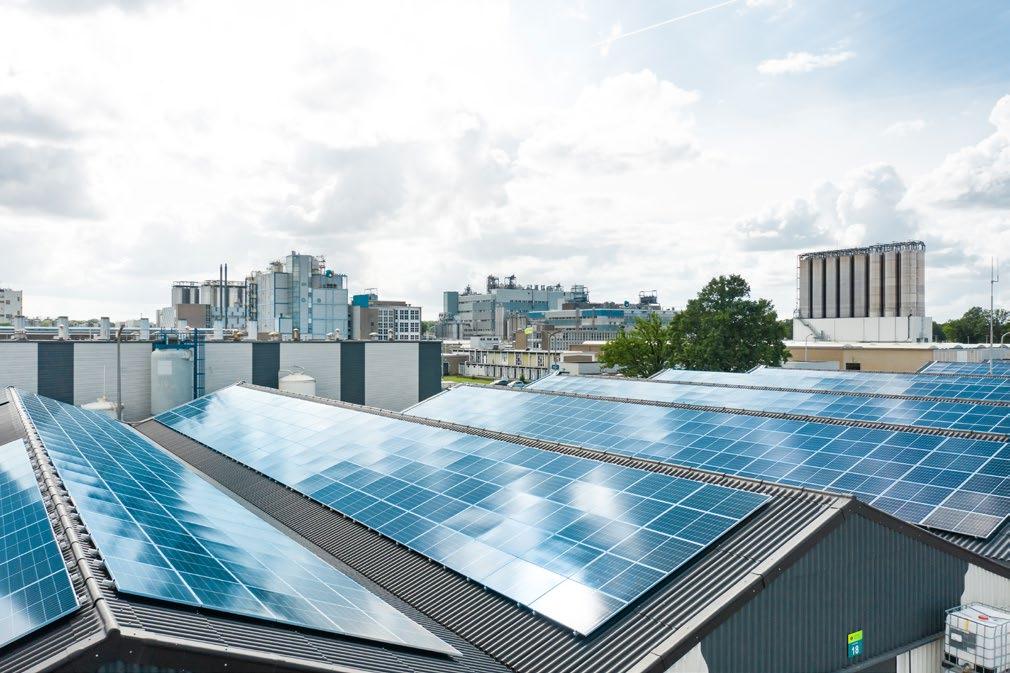
Established
Established
Climate-neu tral supply
Goal for the next ten years: Reduce share of fossil fuels by 50%; long-term goal: ensure the climate neutrality of the industrial park
Participation in a project to construct hydrogen electrolyzers to facilitate the gradual addition of green hydrogen to the energy generation mix in the future (Hydrogen Competence Center); partner of the Hydrogen Valley project and GZI Next
Under construction
Completed in 2021
In 2020, we launched a Group-wide energy data initiative to continuously record information about the out put of our power plants, with the goal of increasing their energy efficiency. In the reporting year, around 75% of the plants were already digitalized, compared with 70% a year earlier. This allows their remote monitoring. In addition, GETEC has developed a CO2 emission model which makes it possible to forecast the company’s future emissions profile. There are also systems for calculating and tracking annual Scope 1, Scope 2 and Scope 3 greenhouse gas emissions.
We aim to make our energy services carbon-neutral by 2045. As interim milestones, we have defined targets for Scope 1 and 2 emissions that we aim to achieve by 2030 (see “Emissions metrics”). We are planning to define scientifically based GHG reduction targets as encouraged by the Science Based Targets initiative (SBTi). The various approaches for calculating science-based targets and the decision as to which factors should be considered are being discussed.
In the future, we will involve our suppliers in reducing greenhouse gas emissions. A central project in opti mizing our procurement structures is the development of an app to achieve transparency about our suppliers’ emissions.
The following KPIs and the prior-year values are shown in the table on page 142:
GRI 305-1 Direct (Scope 1) GHG emissions
GRI 305-2 Indirect (Scope 2) GHG emissions
GRI 305-3 Other indirect (Scope 3) GHG emissions
GRI 305-4 GHG emissions intensity: Ratio of total emissions (Scope 1 & 2 in gCO2) to energy generated (gCO2/kWh)
GHG emissions intensity is the best KPI for measuring the success of our decarbonization efforts. This is because, in our business model, we often operate or acquire our customers’ plants. Thus, the absolute volume of emissions increases in line with our growth and is less meaningful as a measure. It is therefore important to demonstrate how increased efficiency produces less CO2 per unit of energy output, which is achieved using GHG emissions intensity as a KPI.
The future is already happening at Clean Energy Park Blurado in Radolfzell on the shores of Lake Constance. It is the first new business park in Germany powered exclusively with renewable energy. GETEC came up with something special to supply this project, using agrothermal technology to generate energy which is almost entirely clean. This technology is currently an exotic option in the renewable energy mix and there are few suppliers with experience in this area. With this project, GETEC is literally treading new ground, using the plow process to install large geothermal energy col lectors below the earth on agricultural land. For Blurado, a to tal of ten collector segments are planned in furrows of equal length (see graphic at right). Each furrow is linked segment by segment to input and output lines via header trenches, which in turn are connected to central structures. In principle, it is like an underfloor heating system with the land above still being farmed. Is this good for the environment? Studies show that installing agrothermal collectors has less impact on flora and fauna than extreme weather fluctuations, for example. In addition, possible soil changes are constantly monitored. The heat required is thus collected entirely on site from cli mate-neutral and renewable heat sources, and supplied via a cold local heating network to decentral heat pumps installed in the buildings. Most of the electricity needed to power the heat pumps is produced on site by climate-neutral photovol taic plants. However, the concept is not only environmentally friendly, but also economical. The energy concept used in the Blurado Park is the basis for supplying renewable energy to all the companies located there. This means that the energy costs will remain predictable in the years ahead, offering a major advantage over heating systems that use fossil fuels like oil or gas especially. At present, virtually every business owner is painfully aware of the high double-digit percentage increases in conventional energy prices as a result of the geopolitical
situation. Future development is highly dependent on political decisions, which are currently difficult to forecast.
Total area: 4.2 HECTARES
Share of renewable energy: UP TO 100%
Ground broken for geothermal plant: 2021
Geothermal plant completed: 2022
GETEC’s role in this project is as contractor and investor. In addition to the financing, the company is handling the profes sional planning of the technology and approvals, construction, maintenance, monitoring, repair and operation of the agro thermal collectors, cold local heating network, heat pumps and photovoltaic modules in the individual buildings. Similar cold local heating concepts are currently being developed and implemented throughout Germany. Unlike conventional heating concepts, cold local heating systems deliver environ mental heat to consumers at temperatures of between 0 and 12 °C.
As already described above, the project has gained additional relevance due to current developments. The core question is how we can become less dependent on the non-domestic energy market while reducing CO2 emissions at the same time. Clean Energy Park Blurado is delivering many answers in the field – quite literally.
The main line of collectors was laid in the spring of 2022, with two pipelines running to and from the technology center in the business park. The pipelines were laid underground using the cable plow process. In the same way as agricultural plowing, a plow is towed by an all-terrain vehicle with the aid of a winch. To cope with any unevenness in the ground, the plow is equipped with four adjustable booms and hy draulically controlled rubber wheels. Thanks to the traction of the winch, the plow share pushes the earth away and, at the same time, the vertical and horizontal movement of the laying shaft smooths the trench floor. This creates a cavity in which the pipe can be laid tension-free at the desired depth. The plow can lay several pipes and warning tapes in a single operation. The average depth of the pipes is between 1.00 and 1.70 meters, which allows the fields above to still be used for agricultural purposes.


RELIABLE HEATING AND A CONSTANT SUPPLY OF HOT WATER – THIS SHOULD BE NORMAL FOR THE INHABITANTS OF COMMUNITIES CLOSE TO THE GLAMOROUS CITY OF MILAN. HOWEVER, IT ISN’T IN ROZZANO. OUTDATED INFRASTRUCTURE AND OVERLOADED SYSTEMS MEAN THAT HEATING FROM OCTOBER EACH YEAR IS A LOTTERY. GETEC AIMS TO CHANGE THIS WITH THE LARGEST DISTRICT HEATING PROJECT IN THE COMPANY’S HISTORY.
CHRISTIAN BOLOGNESI at the IOTTI power plant, one of three power plants that will soon ensure a reliable district heating supply in Rozzano.

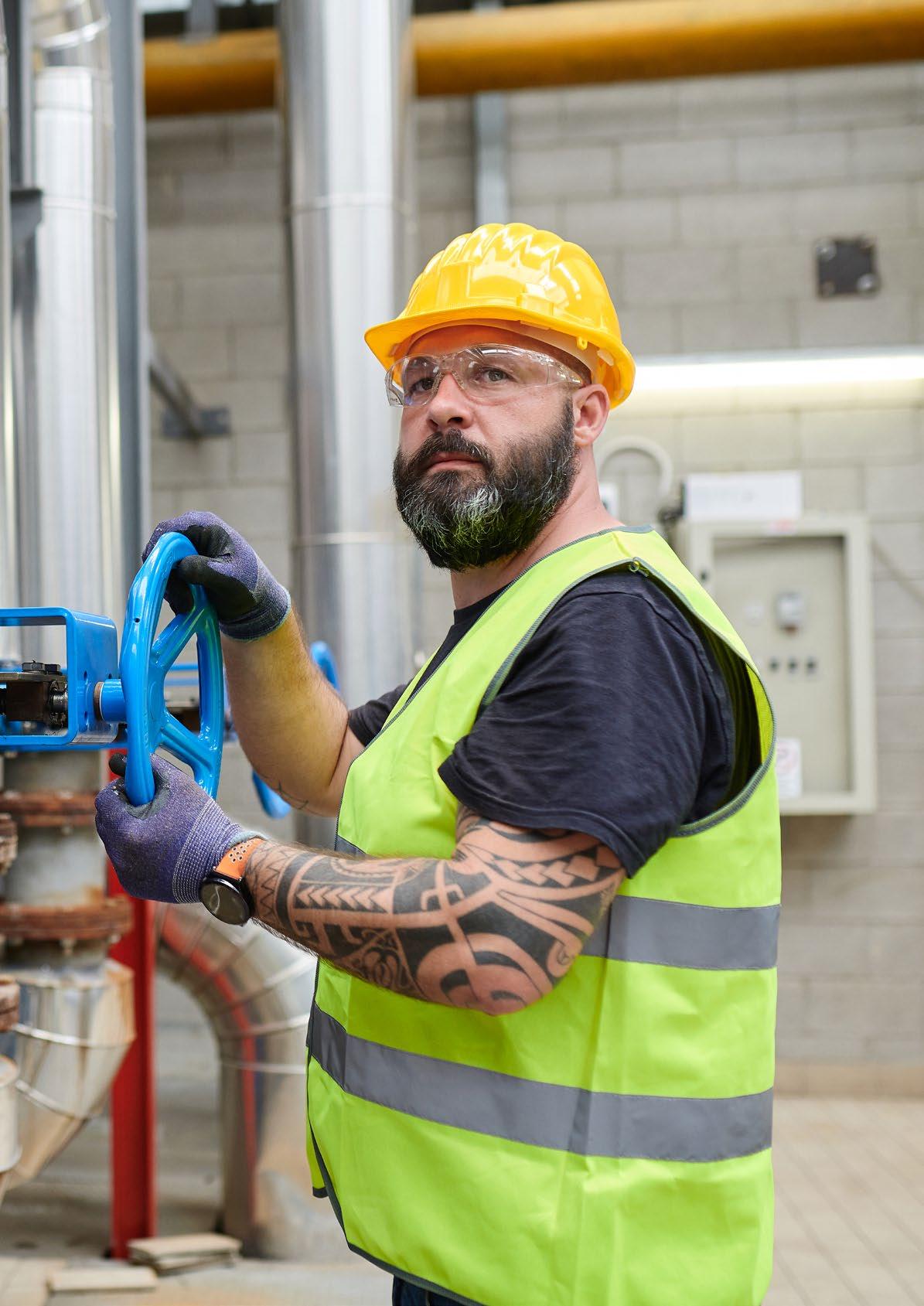
When GETEC assumed responsibility for supplying the district operated by housing company ALER in 2021, the heating supply in winter was anything but reliable. The energy infra structure had been built around 1960 and was outdated. Of three planned power plants, only one was supplying heat. A second one just pumped it around and the third was never completed. The homes in the ALER district of Rozzano, Italy, were built 70 years ago. Some of their tenants are even older and the summer temperature averages 30 degrees Celsius. In October, night-time temperatures in the social housing dis trict drop to 11 degrees Celsius and are just 2 degrees Celsius in December. This all came together to result in a poor supply situation.
“It was not unusual for the heating supply to fail for several hours or even an entire day,” says project manager Andrea Zanetti. “It was difficult to locate any damage which oc curred. As a result, supply was unreliable and repair work was necessary – a major nuisance for the tenants.”
The only solution was the complete modernization of the infrastructure and technology. However, there was no money for this. Gianni Ferretti, Mayor of Rozzano: “When I took office three years ago, the ALER’s district heating system was managed by municipal company AMA. It wanted to invest in modernizing the network but it quickly became clear that AMA could not do so because one of its affiliates went bank rupt at the time. ALER took court action against AMA, which reacted by raising prices to €22 per square meter and year.
However, I wanted a price of €16 per square meter and year.” A new solution was needed. In order to make the project attractive, the town changed its strategy. Instead of requiring the supply of energy for a foreseeable period of time, as is the standard, the tender was for an epic 48 years. Any company that wanted the project would have to think long-term. In close collaboration with the industry and district experts at GETEC’s Platform Germany Competence Center, the company’s Platform Italy developed a viable concept and submitted an offer. This included a sus tainable plan and an investment commitment of €50 million to improve Rozzano’s energy infrastructure. GETEC won the contract and initiated the future of energy in Rozzano.
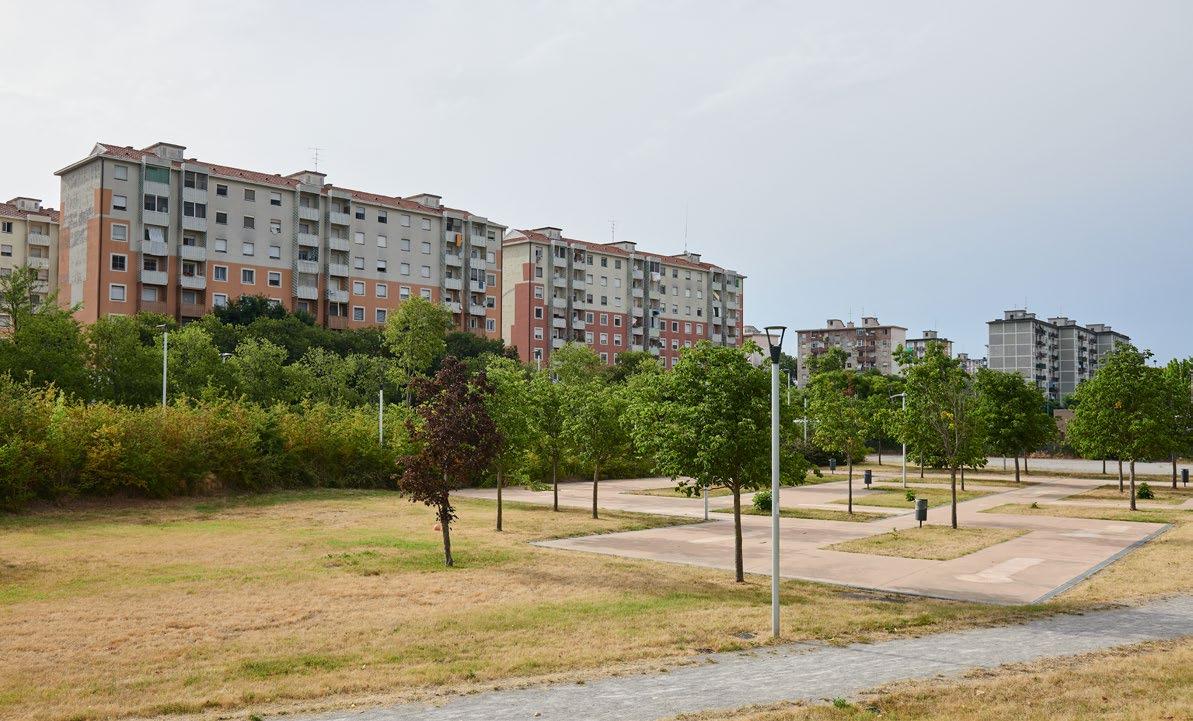
“IT WAS NOT UNUSUAL FOR THE HEATING SUPPLY IN THE ALER DISTRICT TO FAIL FOR SEVERAL HOURS OR EVEN AN ENTIRE DAY”
The goal of the district heating project is to produce environ mentally friendly energy, reduce consumption and ensure the improvements in quality and efficiency that residents expect for many years to come. In the years ahead, GETEC is planning to invest €50 million in Rozzano. However, as the price of heating should not be increased, a long-term commitment and efficient processes are needed for this investment to pay off. The corresponding concept was developed jointly by the GETEC team in Italy and the GETEC Competence Center. The changes won’t happen overnight. Until implementation of the plans, the main task of the GETEC team will be to ensure the best possible supply of heating to residents on the basis of the existing technology.
When it was installed, Rozzano’s heating grid was well-designed. However, the energy manager has not modernized the pipelines since the 1960s. That is why all the pipes in the complex 12.2-kilometer ALER network need to be replaced and modernized. This work has already started, but GETEC’s plans go further. The company will link the ALER grid to the municipal grid so that the energy manager can serve both public and private buildings. The vision is to create a ring around the town that will allow further expansion and the use of additional capacities.



In order to leverage these efficiencies, it is necessary to fundamentally re-imagine energy production. The first step is to modernize the IOTTI combined heat and power plant. This will involve installing new and highly effi cient boilers in both the power plants and the combined heat and power plants. In a second step, production will be shifted from one to three heat plants and optimized to avoid the need for purchasing emission certificates. In this way, it is planned to increase output to a total of 74.16 MWt.
The aim is to improve the supply to residents in the future, but without the costs exploding. The only way to achieve this is by taking the long-term view. Danilo Piermarini, GETEC Director of Operations Industry and Contract Manager for Rozzano: “We will be investing massively at the start: in more efficient technology, in more efficient processes and in more efficient maintenance and monitoring. This will cost a lot of money, but the approach will pay off in the future. For the residents of Rozzano and, of course, for us as well.”
The future of energy lies in intelligent grid control. Fabrizio Buttaboni, GETEC Power Plant Manager in Rozzano: “Improv ing the infrastructure will make many things better. We will have a back-up grid to ensure continuity, fiber optic cables for rapid data transfer, sensors at critical locations and re mote-controlled valves. There will be a control room manned by six experts, but the system will also be equipped with automated controls and is open for innovation.”
Energy production is being optimized in line with Europe’s energy transition objectives. Andrea Zannetti, GETEC Con struction Project Manager: “We are using the energy more efficiently by installing state-of-the-art technology and sus tainable innovations like heat pumps and storage systems. We are constantly looking for new ideas and better solutions such as using biomass produced from the waste from public parks.”
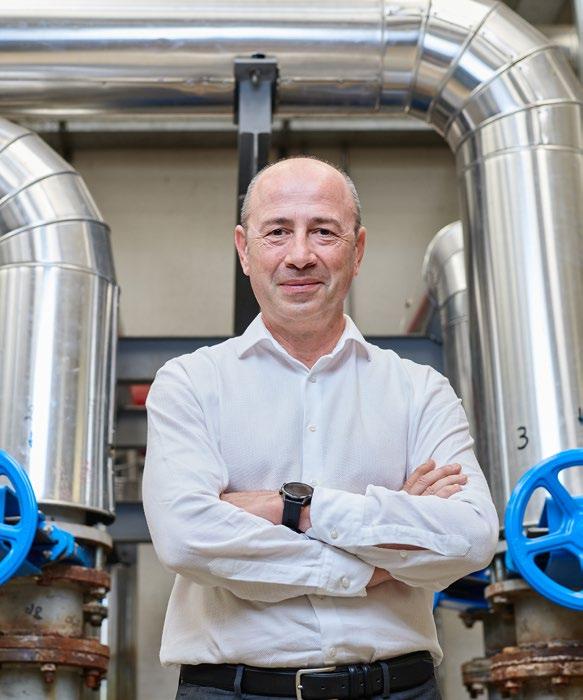
“WE WILL BE INVESTING MASSIVELY: IN MORE EFFICIENT TECHNOLOGY, IN MORE EFFICIENT PROCESSES AND IN MORE EFFICIENT MAINTENANCE. THIS WILL PAY OFF LATER.”
Danilo Piermarini, GETEC Director of Operations Industry and Contract Manager for Rozzano



WHAT DOES ROZZANO EXPECT FROM THE DISTRICT HEATING PROJECT? WE SPOKE WITH MAYOR GIANNI FERRETTI.

Rozzano has many faces. It has public transportation links to the heart of Milan so you can get downtown quickly. Young people here can be educated from kindergarten through to university. Rozzano is also an industrial town, with many companies providing interesting jobs. One example is the excellent Humanitas hospital complex. But there’s another side to the town as well. Rozzano has a very large proportion of public housing – a total of 6,000 units which are home to around 20,000 people. This mix is what makes Rozzano special.

The district heating project will have a double effect. It will make the 70-year-old homes more pleasant to live in and help to halve the environmental impact, which will benefit the residents as well. The project is also socially beneficial in financial terms. The town authorities have set a financial cap for the project for the next three years of €16 per square me ter year. However, this figure was decided before the energy crisis so we may have to revisit it.
Yes, because it solves two problems. First, we will soon be able to provide a reliable heat supply to socially disadvan taged residents. Second, GETEC’s acquisition of the district heating grid has given Rozzano the funds to use in resolving a number of public and social problems, which had been assumed by the previous administration. I’m convinced that GETEC will keep to the schedule, make key savings by improv ing efficiency and reduce the impact on the environment.
Going forward, I would like GETEC to use the modern grid to supply new buildings and public facilities as well as our social housing. This would reduce the costs of heating an apartment and the impact on the environment. I see GETEC as a partner for the entire region with which we can collaborate in identi fying solutions for the future that will improve the lives of our residents and reduce emissions, for example, by using solar power plants.
“I SEE GETEC AS A PARTNER FOR THE FUTURE WITH WHICH WE CAN COLLABORATE IN IDENTIFYING SOLUTIONS.”
Constructive dialog: MAYOR GIANNI FERRETTI and GETEC Power Plant Manager Fabrizio Buttaboni in Rozzano Town Hall
Heating and cooling of the Hansapark district in Nuremberg – an office complex with a hotel and car parking – is now ensured by an ice storage system, completed in 2022. GETEC supplies the district with climate-friendly heat, cooling and energy in a dedicated project. Solar and ambient heat are fed into the water-filled storage unit. A heat pump extracts the stored heat to warm the surrounding buildings. Extracting the heat reduces the temperature in the ice storage unit to the freezing point. The crystallization energy released in the form of heat as the water freezes is then used. More than 90 Wh are produced per kilogram of water. In summer, the ice gener ated by operating the heat pump is used to cool the buildings, without any additional energy requirement.


Florian Unger, Head of the Real Estate Seg ment for GETEC’s Platform Germany

Over 70% of the heating and cooling energy required is generated by the environment = free environmen tal energy
Seasonal storage of solar energy Ensuring stable energy supply prices DGNB gold certification to increase the value of the property
“WITH AN INNOVATIVE COMBINATION OF ICE STORAGE AND HEAT PUMPS, GETEC HAS SUCCEEDED IN SUPPLYING HEAT AND ENERGY IN A WAY THAT IS NOT ONLY ABSOLUTELY EFFICIENT BUT ALSO VIRTUALLY CLIMATENEUTRAL.”
MICRO CHP & PHOTOVOLTAIC PLANTS The electricity is also used for powering e-mobility.

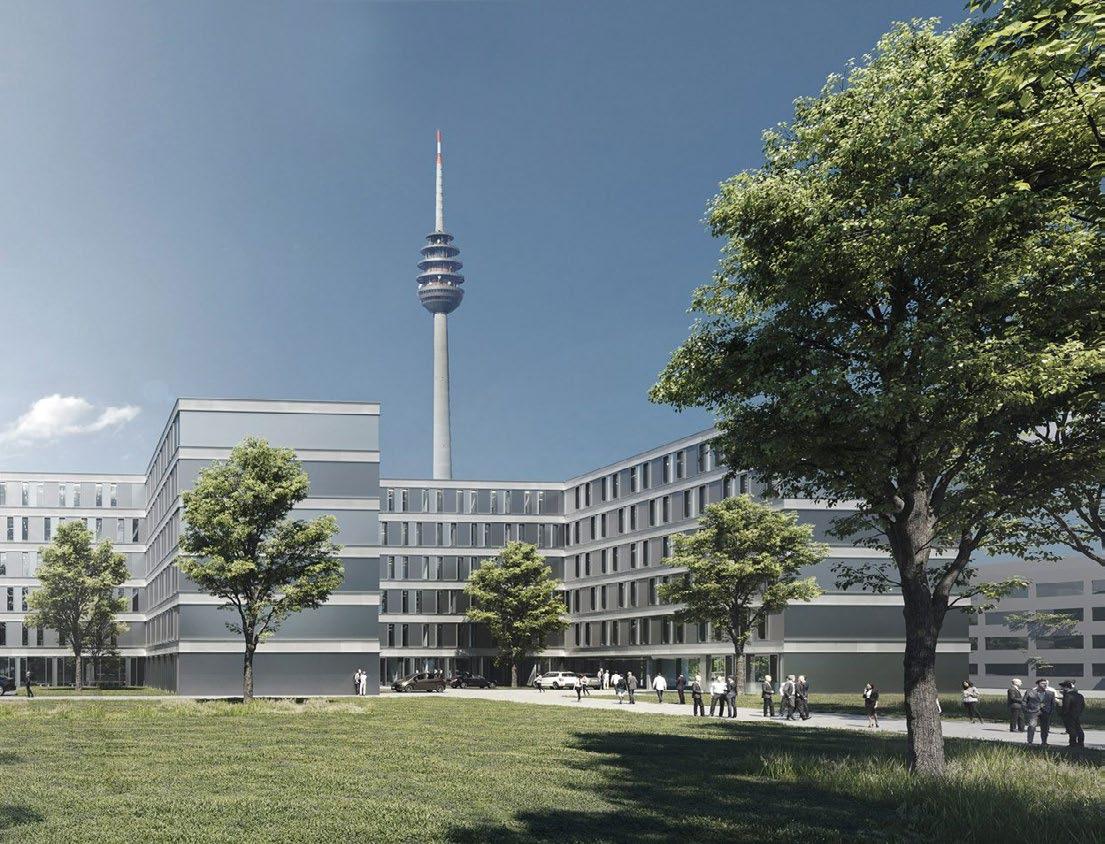
THE HEAT
We admit that, at first glance, the GETEC PARK.SWISS looks like any large industrial park. The site is home to a range of different building designs. Lots of pipelines criss-cross the production areas and chimneys rise to the sky here and there. So what is different about this industrial park?

The differences lie hidden in the processes, the approach to sustainability and, especially, the material cycles. GETEC PARK. SWISS is a waste-to-value park. Put simply, all types of indus trial waste are recycled, waste water is purified and chemical substances are recovered. This makes a valuable contribution to the environment and for the park’s customers as well.
Dr. Guido ZimmermannPlatform CEO,

“MAJOR PLAYERS IN THE CHEMICAL AND PHARMACEU TICAL INDUSTRIES LIKE BASF, BAYER, CLARIANT, NOVARTIS AND SYNGENTA VALUE THE PARK’S EXPERTISE IN THE CIRCULAR ECONOMY. IN THIS WAY, WE MAKE AN ADDITIONAL CON TRIBUTION TO THE SUSTAINABILITY OF OUR CUSTOMERS’ PRODUCTION PROCESSES.”
Switzerland

In 2019, GETEC acquired two neighboring but separate industrial parks from Novartis and Clariant as the nucleus for Platform Switzerland and the GETEC Group’s competence cen ter for industrial recycling solutions, whether for multiclient sites such as Muttenz or Emmen or for contracting solutions for individual customers. Since then, the some 300 employees of Platform Switzerland have been working to optimize the services and processes offered and develop network solutions to save energy, create closed material cycles and deploy their expertise for the benefit of customers within and outside the Park and across the GETEC Group.
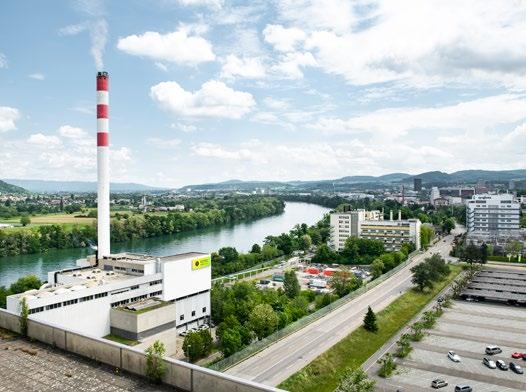
What exactly happens at the Park? Applying the waste-to-en ergy principle, the energy for all the production processes operated by the Park’s customers is generated in an entirely climate-neutral way from waste products, many of which originate from the Park’s customers themselves. However, not all waste is the same. It can be solid, liquid or gaseous so the power generation plants are designed to use all of them. This is a major advantage since the waste produced by the Park’s customers can be in any one of these states and this flexibili ty is therefore necessary.
Digital data streams have a growing role here. The Park’s new Smart Control Center (SCC) is far more efficient at steering and monitoring the fuel used. On the basis of the measured waste streams, the networked monitoring systems enable GETEC’s specialists to see in near-real time when production plants adjust their processes. Today, the Platform Switzerland SCC is one of the country’s most modern control centers and helps to optimize the use of resources. Waste is actually a resource and one that is becoming increasingly important.
This is nothing new – and certainly not at GETEC. Since it was established, the company has prioritized the preservation of resources. Efficiency follows closely behind. Greater efficiency means generating exactly the right amount of electricity using the smallest possible amount of resources. The first and most important principle of the circular economy is that it is so much more than “just” recycling.
Reduce, reuse, recycle, recover: preventing waste is inarguably the main objective. The use of raw materials is optimized by efficiency-enhancing measures in GETEC’s own plants and in the plants operated by the contracting customers of all the regional platforms. This includes the repeated use of water, heat and other resources, increasing value overall and reduc ing consumption.
GETEC PARK.SWISS sets standards in the reuse of resources, whether in their recovered form or as a constituent of new substances. Especially valuable is its ability to regenerate used solvents that have been contaminated in chemical processes and reuse them in another way, as is its great capacity to pretreat and treat waste water for reuse in production and cooling processes.
In order to become even more sustainable, we have collab orated with the canton and other partners to develop initial plans for investing massively in and modernizing waste water treatment capacities. A fourth step to remove micro-impu rities was added to the existing waste water pretreatment and biological treatment processes. In this way, GETEC and its partners have ensured future viability in respect of more stringent regulatory requirements.
Thanks to its innovative approaches and investment in the reduction, recycling, reuse and energy-related use of valuable resources, GETEC is easing the path to net zero. “Closed ma terial cycles are not an end in themselves. We take a holistic view along our customers’ value chains and create measur able added value without using additional resources. This is something we’re proud of,” concludes Dr. Guido Zimmermann.
Opened in 2022, the Smart Control Center (SCC) operated by GETEC’s Platform Switzerland is the heart of the com pany’s AI-supported energy and contracting solutions. It consolidates the control centers at the GETEC PARK. SWISS multiclient site and for customers across the country at a single location. Virtual operating environ ments and big data allow logical process automation and greater operating efficiency for customers at the indus trial park and at decentral locations. The new high-tech control center in Muttenz is one of the the most modern in Switzerland, providing state-of-the-art ergonomic workplaces.

“GETEC IS AN INNOVATIVE COMPANY WHICH IS INVESTING LARGE SUMS IN THE FUTURE, THUS MAKING A POSITIVE CONTRIBUTION TO SOCIETY, THE ENVIRONMENT AND SWITZERLAND AS A BUSINESS LOCATION.”
Thomas Weber, State Council of the Canton Basel-Landschaft

“RECYCLED RAW MATERIALS ARE AN IMPORTANT ELEMENT OF THE BASF CIRCULAR ECONOMY PROGRAM. THANKS TO THE ENVIRONMENTALLY COMPATIBLE TREATMENT OF SOLVENTS BY GETEC PARK.SWISS, BASF AT THE SCHWEIZER HALLE SITE HAS ACCESS TO RECYCLED DISTILLATES WHICH ARE EQUIVALENT IN QUALITY TO NEW PRODUCT AND PROVEN TO CUT GREENHOUSE GAS EMISSIONS.”
Jürg Dudler
Site Head, BASF Schweiz

“NOVARTIS HAS SET ITSELF HIGH TARGETS TO INCREASE SUSTAIN ABILITY IN ITS OWN OPERATIONS AND BY ITS SUPPLY CHAIN PARTNERS. WITH ITS INVESTMENTS AND SMART OPERATING CONCEPTS, GETEC MAKES AN IMPORTANT CONTRIBUTION BY PRESERVING RESOURCES THROUGHOUT THE ENTIRE LIFE CYCLE.”
Stephan Buser Head of Engineering NTO Switzerland, Novartis
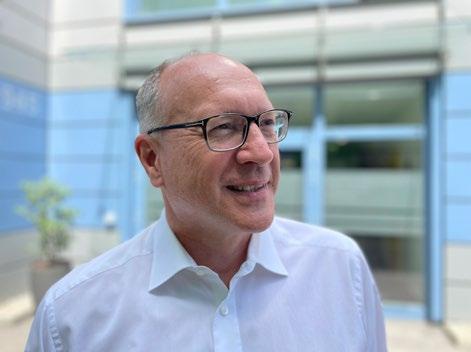

“BAYER’S COMMITMENT TO SUSTAINABLE DEVELOPMENT IS EXPRESSED IN THE WAY IT HANDLES UNAVOIDABLE WASTE. ANY WASTE THAT CANNOT BE AVOIDED OR RECYCLED IS USED RESPONSIBLY BY GETEC TO GENERATE ELECTRICITY FOR THE INDUSTRIAL PARK.”
Dr. Thomas Wessa Site Head, Bayer
The GETEC Group’s Platform Switzerland offers various ecological and economical disposal routes. It is proof that treating problematic industrial waste works – whether this is waste air, waste water, solid waste or hazardous liquid waste. Waste and waste water treatment is a part of this platform’s business model and therefore a material topic. In this way, the following three targets are met:
1. With its state-of-the-art plants, GETEC ensures that any hazardous constituents of the various waste streams do not endanger or impact the environment.
2. Another reason for treating waste is to recover as much as possible of any valuable constituents of the various waste streams for use in recycling (waste-to-value).
3. If neither are possible or expedient, GETEC seeks to deploy efficient thermal recycling (waste-to-energy) to supply its Platform Switzerland and its industrial customers with process steam and other energies without using additional fossil fuels in their production.
Platform Switzerland offers environmentally friendly waste and waste water treatment to the companies lo cated at the Park and to customers in other regions. At GETEC PARK.EMMEN, Platform Netherlands also offers state-of-the-art waste water treatment. Legally non-compliant disposal that is not environmentally friendly would jeopardize the company’s business model.
At GETEC’s other platforms in Germany and Italy, less waste and waste water are produced or delivered by third parties for disposal. That is why these topics are not identified as material for these platforms, which are therefore not considered in this chapter. Moreover, water and steam are mostly used in closed circuits there, for example, for heating and cooling processes, so that there are only small losses from conventional plants. The replacement volumes are negligible.
With these waste-to-value and waste-to-energy concepts, GETEC’s Platform Switzerland achieves a balance between ecology and economy at GETEC PARK.SWISS. Both these approaches help to reduce CO2 emissions and support the companies located at the Park in improving their climate balance. In this way, GETEC is con tributing to the lasting improvement of the companies’ sustainability profiles.
Another key advantage of the location is that most of the waste streams are transported via short pipelines to the disposal and recycling facilities. This both minimizes the carbon footprint and the risks associated with transporting hazardous waste.
Most of the waste disposed of is produced by the chemical and life sciences companies that are connected to the Park’s infrastructure. Inherent to the core business of these companies is that they generate waste products in varying amounts and concentrations from the production of fine chemicals, specialty chemicals, agrochemicals and pharmaceuticals. This means it is not possible to calculate environmental indicators to track the continuous improvement in GETEC’s processes and plants. Moreover, the companies are dependent on the full treatment and disposal of this waste.
GETEC PARK.SWISS operates six disposal plants in three business units (BUs). The Energy & Recycling BU has four plants for the thermal recycling of solid, liquid and gaseous wastes. They also supply the site with process steam and other utilities (steam for heating, hot water, electricity).
The plants operated by the Solvent Distillation BU have the task of recovering as much as possible of the contaminated solvents delivered by industrial customers and then returning them to the production plants in a closed loop.
The AVORA waste water treatment plant operated by the Waste Water BU is the site’s fifth disposal plant and treats highly contaminated waste water. For example, it removes more than 99% of the copper and zinc in waste water contaminated with heavy metals and ensures that the site’s industrial waste water meets the threshold values for the downstream biological treatment plant. By separating the individual production waste water streams until they reach AVORA, GETEC is able to efficiently and effectively adjust the treatment processes to deal with problematic constituents.
All
Waste-to-value
Closed loops
Increased added value
Waste-to-energy Energy from sustainable sources
Group
Competence Center Consulting Recycling/recovery Waste management
Waste-to-value: Extracting raw materials from waste
Through its solvent recovery plant and AVORA, GETEC is implementing its stated aim of achieving high-quality recycling of as much of the waste as possible.
Waste-to-value core expertise: Solvent recovery
In 20 recovery columns, by-products, off-spec material, mixtures and other liquid streams from the produc tion of fine chemicals, specialty chemicals, agrochemicals and pharmaceuticals are treated to yield specific high-quality raw materials. One focus is on the recovery of valuable solvents.
These plants are designed to deal with large volumes. Those residues which cannot be recycled (bottom prod ucts) and the plant’s emissions are treated in the nearby GETEC plants in accordance with the waste-to-ener gy principle.
With a 200-tank farm, our solvent recovery facility has a capacity of more than 20,000 metric tons and is one of the largest such facilities in Europe. GETEC’S in-house research and development laboratory and its many years of experience in recovering solvents for customers from the agrochemical, pharmaceutical and polymer industries with demanding quality requirements guarantee a high level of recycling and above-average quality.
GETEC operates four special waste incinerators at GETEC SWISS.PARK which enables it to burn hazardous solid, liquid and gaseous wastes.
In this way, we convert more than 56,000 metric tons of special and industrial waste to thermal energy each year. The energy products generated are: electricity (230V/400V/500V), steam of various pressure stages and hot water at 160 degrees Celsius.
The site’s emissions network transports the gaseous waste streams from the production plants to be used as combustion air in the incinerator. Generating energy by the waste-to-energy approach is sustainable and therefore essential in modern zero impact production.
Waste water can be delivered to GETEC PARK.SWISS in rail or road tankers or in intermediate bulk containers (IBC). Companies located at the site are connected to our facilities via pipelines.
The waste water pretreatment plant (AVORA) at the Muttenz site pretreats industrial waste water which is poorly (bio)degradable or contains toxic constituents or heavy metals. Thanks to its industrial scope and high degree of specialization in disposal issues, AVORA is able to pretreat a broad range of problematic types of waste water expertly and in an environmentally compatible way. Pretreatment includes the removal of all types of heavy metals (except mercury) and the elimination of water-soluble and toxic organic constituents, trace substances or industrial chemicals.
We analyze industrial waste water in our own laboratory, offering the full spectrum of laboratory analyses – environmental, fine chemical, consumer goods and REACH analysis*. Based on the analytical results, we advise our customers on the most suitable disposal route. On request, we provide a detailed disposal report on conclusion of the pretreatment process as verification that the waste water has been disposed of expertly and responsibly.
At the GETEC PARK.SWISS site, waste water disposal is regulated by a detailed process instruction setting out clearly defined responsibilities. In this way, GETEC seeks to ensure the legally compliant treatment and dispos al of aqueous waste from the companies located in the Park and from external companies.
The Head of Waste Water Disposal is responsible for waste water treatment and has prepared separate oper ating instructions for the various types of waste water. The AVORA experts have drawn up an instruction for taking samples which are then analyzed by the AVORA laboratory or by GETEC PARK.SWISS Analytic Services.
The waste water is treated after calculation of the treatment parameters. The processes used include precip itation/flocculation, copper removal, metal precipitation and oxidation. The treatment process is monitored by regular in-process controls (IPC). If the results of treatment do not meet specifications, the waste water is treated again. If the results are good , the waste water is transferred to our affiliated company ARA Rhein in Pratteln for biological treatment as industrial waste water.
* REACH Regulation: EU chemicals legislation; REACH = Registration, Evaluation, Authorisation and Restric tion of Chemicals
GETEC is primarily a disposal company rather than generating waste and waste water itself. GETEC PARK. SWISS has been rated as a safe and good site by the relevant authorities, especially for plants whose produc tion is covered by the Hazardous Incident Ordinance. For this reason, the authorities support the location of these types of production facilities at GETEC PARK.SWISS.
GETEC works with its industry customers at the site to sustain the great confidence of the authorities and to continuously improve the site’s high safety and environmental standards. To this end, GETEC is certified to ISO 9001 (quality), ISO 14001 (environment) and ISO 17025 (analytics) at this site. As well as ensuring optimized waste treatment at the site, GETEC also supports its customers in the professional and compliant disposal of all other waste streams.



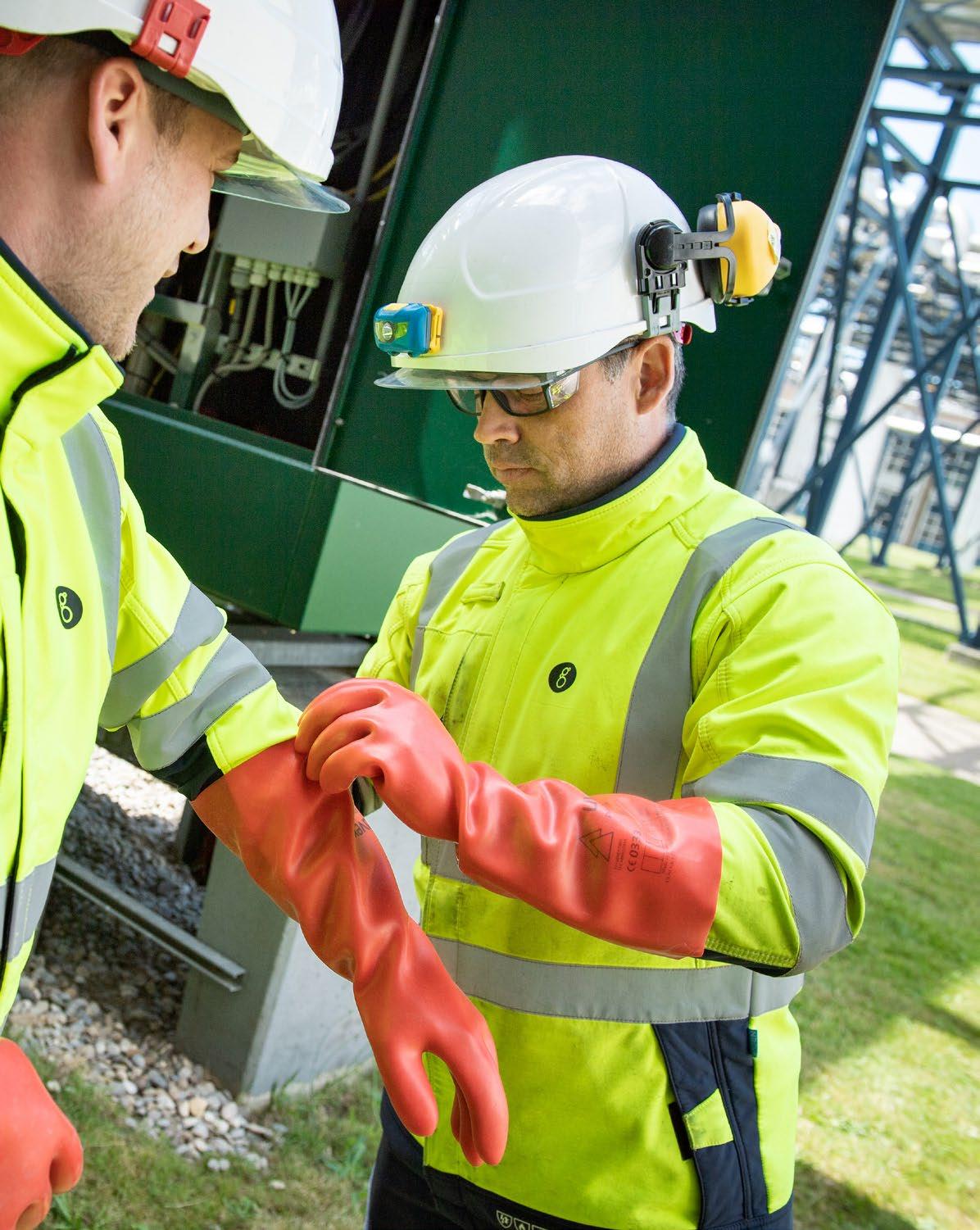
WE ARE CONVINCED THAT DIVERSITY BENEFITS OUR INDUSTRY, WHICH IS CHARACTERIZED BY THE LARGE NUMBER OF ENGINEERS. IN ORDER TO FURTHER IMPROVE OUR SAFETY CULTURE, WE LOOK FOR NEW APPROACHES – AND HAVE FOUND THEM.
Diversity helps us to move forward. GETEC has started to shift away from its traditional roots toward greater diversity. And we’re making good progress. Safety is a great priority at GETEC. In 2021 again, we recorded no fatal or serious accidents. However, there were more accidents overall, which is probably because we have motivated our employees to report even minor accidents. Therefore, the increase can actually be seen as an improvement in our safety culture. In addition, we have been looking for new ways to achieve improvement – and have found them in our Hearts & Minds safety project.

The following three strategically relevant aspects make diversity a material topic for the entire GETEC Group and its four platforms in Germany, Italy, the Netherlands and Switzerland.
GETEC is a service company whose employees often work with people representing a colorful cross-section of society In order to remain successful, achieve a high level of customer satisfaction and recruit and retain committed employees, GETEC aims to address the many aspects of diversity and utilize the opportunities it offers.
Various studies (for example, by McKinsey) and scientific articles on the organization of successful companies reveal a positive correlation between the diversity of teams and corporate success. One reason for this is that challenges are best solved by looking at them from many different perspectives. That is why it is important for companies that their teams bring together people with very different skills and diverse experience. GETEC aims to use this potential through its management principles and international alignment.
Broad experience of specialists and managers
GETEC must also address the shortage of specialists and managers. Appointing employees with the right qualifications and expertise to the right positions is the biggest challenge – also in light of the company’s growth trajectory and internationalization strategy. At the same time, diversity offers GETEC the opportunity to attract and develop qualified specialists and managers with wide-ranging experience – both in internal employee development and external recruiting. Increasing the proportion of women in STEM subjects will play a role in implementing this diversity strategy. Between 2008 and 2019, for example, the proportion of women in mechanical and process engineering increased from 18.8% to 23.7% (source: Heise.de).
A detailed justification of materiality was included in last year’s ESG Report
GETEC’S HR strategy is aimed at making the company so attractive as an employer that it can attract as many employees and managers as possible with the most varied intercultural experience, ethnological competence and social intelligence.
The following three levers should provide greater access to larger and more diverse groups of potential employees.
1. Employer attractiveness: GETEC is an employer which offers a broad range of development opportunities for committed employees in an increasingly international environment. As an energy services provider, the company develops innovative solutions which have a direct impact on the climate and the future of energy. Anyone who works for us is making a contribution to the energy transition and thus also serving future generations. The main sites of our four regional platforms are easily accessible at the heart of Europe’s energy transition. Alongside the regional platform in Germany (Magdeburg), there are regional platforms in the Neth erlands (Emmen), Switzerland (Muttenz, near Basel) and Italy (Piacenza, near Milan).
2. Internationalization: Within just a few years, GETEC has evolved from a regional company into a corporate group with Europe-wide operations. Internationalization and growth have fostered and strengthened our in tercultural competence. GETEC’s success has resulted in the company being entrusted with a growing number of international projects. We aim to use this momentum to become an attractive employer with a reach far beyond Germany’s borders.
3. Individualized working organization: For us, diversity encompasses all ethnic and social competences based on differences in ethnic origin, age, sexual orientation, religious belief and socialization – irrespective of exterior characteristics. Diversity and equal opportunity in the workplace mean ensuring that everyone who works for GETEC has the greatest possible freedom. Therefore, the heart of our diversity policy is to create the optimal conditions within the company to enable each and every employee to develop his or her individual skills, talents and aspirations. At the same time, however, we want to involve our employees in such a way that they can develop a deep-rooted loyalty to the company.
To make the topics of diversity and equal opportunities measurable in the future so they can be steered ap propriately, the GETEC Group has developed an ESG Roadmap that includes specific targets. By 2030, we aim to increase the proportion of women employees and managers Group-wide to 25%.
We continue to seek certifications to increase GETEC’s visibility as an employer and aim to acquire Great Place to Work certification across all platforms. This quality label is based on a representative and anonymized employee survey in accordance with the Great Place to Work standard and is the foundation for authentic and effective employer branding. We intend to obtain this certification for the entire Group by 2024 at the latest.
In 2021, we sought comprehensive advice on our vision for inclusion and diversity and the Diversity Working Group started work. We aim to develop and implement an inclusion and diversity campaign by 2023. In a first step, all the Group’s platforms will establish a diversity circle in which the company will specifically request and implement suggestions and flexible views from its employees. Within the context of codetermination, we would like to continue improving the company and its impact on the basis of suggestions from our employees. In addition, the company plans to establish its own international women’s network.
In November 2021, we initiated a management program aimed at increasing the maturity of the entire orga nization. The focus is on building networks and vertical alignment (inclusion of the teams).
Other goals are improving employee and management dialog, talent and succession planning, talent develop ment programs and career models and expanding employee benefits.
To support the employee dialog, we have developed a manual for managers that defines the process and the various steps as well as a dialog guide in the form of a template. We consider the employee dialog to be the core component of the dialog system and thus a central management and control tool for the company. It serves to identify goals and expectations in order to ensure that the work of every individual contributes to achieving company and departmental targets (value contribution). It fosters a performance-related dialog between managers and their team members and thus results in a constructive feedback culture. The employee dialog provides the ideal opportunity to discuss collaboration, individual performance, development and mutual expectations and to document specific agreements.
The employee dialog guide is based on the SMART method:
S – Specific (What is to be achieved?)
M – Measurable (definition of a clear parameter)
A – Achievable, accepted (definition of the steps to achieve the objective)
R – Realistic (Is the target compatible with the employee’s personal mission?)
T – Time-bound (How long will it take to achieve the target?)
The dialog guide has been designed as a template. A maximum of five targets are recommended – from financial targets through implementation in day-to-day operations to employee development. Feedback on an employee’s work performance should cover the following aspects: occupational safety, quality and expertise, soft skills, efficiency, social and/or management skills. These are assessed using a defined scale ranging from “exceeds expectations” to “below expectations.” A personal development plan should also be discussed. This may include on-the-job activities, mentoring, networking and coaching, workshops, training and e-learning.
In the context of our 2020 Engagement Survey, some 200 workshops and team meetings were held at which more than 170 action plans were developed and have since been implemented. Specifically, any employee suggestions were discussed with the manager and the rest of the team and everyone worked together to de fine options for action in order to further improve collaboration within the team by optimizing team processes and procedures. This dialog aims to improve the error feedback culture and strengthen flat hierarchies for fast decision-making. A trust-based environment and open discussion are essential for this process and, at the same time, serve as indicators for improving the corporate culture that is in place.
The positive results of the process that has been initiated are reflected in the GETEC Group’s current Engage ment Survey (see also overview on page 94). With a response rate of 85.4%, slightly more employees partic ipated in the survey than a year earlier. Compared with the previous year, we achieved slight improvements in the overall result for the standardized Q12 questions asked by survey provider Gallup, although the result remained in the mid-range percentile. The company achieved a clear improvement when it came to em ployees’ overall satisfaction. Viewed overall, we also achieved a further slight improvement in our strengths. In the previous months, we worked on the weaknesses that had been identified and achieved a significant improvement.
Another component of codetermination was presented at the site meeting. At the suggestion of the compa ny’s management, employees were able to submit their questions anonymously. Management subsequently provided the answers at four further meetings.
PF D
Social security Company pension
Structure and scope of the company pension:
In line with Germany’s Act to Strengthen Company Pensions (Betriebsrentenstärkungsgesetz), GETEC is paying all em ployees with company pension agreements a 15% employer premium. As required by law, the agreements were amended as of January 1, 2022.
Implementation in 2022
Equal opportu nities Increasing employee awareness for the Diversity Charter
GETEC signed the Diversity Charter in 2021 and is currently planning a kick-off workshop for the People, Culture and Di versity Circle, which is made up of 17 employees of different ages, ethnicities, functions, hierarchical position and gender. The nominated employees collaborate to develop measures and serve as lighthouse figures for their implementation within their respective organizational units. An online training course on diversity at GETEC is also being developed.
2022
Equal opportu nities
Respectful and supportive corpo rate structure
Equal opportu nities Foster diversity by implementing diversity-appropriate language to address potential candidates on the company’s job portal and in job advertisements
Diversity Diversity-compliant revision of the Umantis recruiting tool and the job portal landing page
Implement Diversity Charter activities Roll out various activities and the workshop for the People, Culture and Diversity circle (see above)
From April 2022, revision of the job portal landing page and all job advertisements to include the following text: “We value diversity and therefore welcome all applications, regardless of gender, nationality, ethnic and social origin, religion and ideology, disability, age, sexual orientation and identity.”
From May 2022: Invitation via intranet for employees to par ticipate in a diversity photo shoot with the goal of creating authentic images that reflect GETEC’s colorful workforce for use in a diverse employer brand for external communications such as the job portal landing page, the company’s job advertisements and the “job of the week” on social media (LinkedIn)
2022 and 2023
Implemented
In implementation
PF D
Diversity Development of company’s inter nationality/diversity
Extensive English-language HR marketing campaign on various social media platforms (XING, LinkedIn, Facebook and Instagram) to address international engineering specialists
Since April 2022, the company has been working to create an international job portal in all platform languages in the Uma ntis recruitment management tool; this will give specialists and managers outside Germany better access to all vacant positions and German employees the possibility of working at one of the GETEC’s non-German companies.
Campaign from De cember 2021 to March 2022
Certification Audit by berufundfamilie
Social and sustainability Revision of onboarding kit for new employees
Personnel development
Raise awareness of sustainability
Increase alignment of HR policy with employees’ family and life phases; announced for 2023 Certification by 2024 at the latest
When they start working for GETEC, new employees receive an onboarding kit that includes a planted tree (https://plan et-tree.de) and other sustainable gifts.
Start of the six-month certification course on climate, energy and sustainability management delivered by EBZ Akademie. Six GETEC employees were identified to participate and will serve as experts and multiplicators on this subject in their departments in the future.
Being rolled out
First course: April 1 to October 28, 2022
Personnel development
Increase personnel development measures
Work-life balance Compatibility of family, career and leisure activities
Revision of talent management process with addition of fixed action plans with a development path for each employee
This will facilitate the identification of development formats, with the goal of increasing the number of training days by at least 200% in 2022 (compared with 2021) on the basis of the 2021 training needs analysis.
Flexible working methods or working hours; mobile working as a flexibilization tool (does not include support and oncall services, marketing, service and installation activities or customer visits)
A collective agreement governing working time with great er flexibility and improved options for taking time off in lieu (working time accounts, time off in lieu for time credit)
Special vacation days for events such as weddings, birth of a child, etc. – also for employees in same-sex partnerships
A collective agreement on mobile working (since March 2021; voluntary participation; in Germany, restricted by law to a maximum of eight days per calendar month)
Child care center at the Magdeburg site with places for 39 infants and toddlers and 44 places for preschoolers
In implementation and already in scope in May 2022 in terms of measurability for yearto-date (see personnel development chart)
Due to the German government’s reg ulations on mobile working during the coronavirus pandemic, the collective agree ment has been pushed back; roll-out and communication are currently taking place in line with prevailing pandemic control regulations
Strategic talent development Strategic increase in the number of apprenticeship places in order to recruit and retain specialists
Step-by-step ramp-up plan for apprenticeship places in Germany (focus especially on the commercial and technical areas); development of Germany-wide five-year apprentice ship plan for 2021/2022: 16 apprentices
Increase in the number of trainer roles within the company; invitation via intranet followed by training of the new training officers and completion of the AEVO certificate following nomination
2022
Strategic talent development
Integration of young people in training and employment
Close support for apprentices provided by the company Cooperation with training institute OKS (new provider): tutoring or language teaching for apprentices (funded by Germany’s Federal Employment Agency) Training year 2021/2022: two dual students
Long term: Increase share of apprentices in the total workforce to 5%
Strategic talent development Attract specialists
Make use of Germany’s Skilled Immigration Act in order to attract motivated, committed and qualified young people from all over the world
In the future, we are planning to hire larger numbers of appren tices with an interna tional background in order to have enough qualified employees.
Strategic talent development
Build long-term loyalty of special ists and managers
Dual degree program: Transfer of company-specific knowl edge; practical application thanks to internships at GETEC as part of the degree program; intensive support from GETEC partners, mentors, managers and dedicated HR contacts; regular feedback meetings
Current roll-out to other partner univer sities in Frankfurt and Berlin, with the goal of welcoming the first students from these programs – alongside those from Magde burg – from 2023. In the long term, we are planning to increase the number of dual students to 5% of the workforce.
Strategic talent development
PF D
Strategic personnel development
Strategic talent development
Strategic talent development
Strategic talent development
Strategic talent development
Trainee program for university graduates: Transfer of com pany-specific knowledge; further training and job rotation (learning to think across departmental boundaries); trainee program for managers: broad-based and open training pro gram ranging from learning on the job to training off the job Specialist trainee program for experts: Job rotation in departments relevant to a trainee’s selected focus and further training in area of specialization; intensive support from GETEC partners, mentors, managers and dedi cated HR contacts; regular feedback meetings
Build loyalty of specialists Company concept for specialist career path: Specific career perspectives for the company’s engineers (see box for details)
In the long term, we are planning to increase the number of trainees to 5% of the workforce. In preparation for 2022, concept adapta tion, roll-out in 2023
The specialist career path concept was active in 2021 but is to be adapted in 2022 before being rolled out again.
Secure qualified talents for the future Scholarship program with on-site support and internships with the company; see also dual degree program (tuition fees sponsored by GETEC)
Secure qualified talents for the future
Apprenticeship collaboration with Magdeburg public trans portation company; modules for electricians and mechatron ics technicians
Secure qualified talents for the future Cooperation with the professional training center operated by the Magdeburg Chamber of Trade; its training courses are a new component of our apprenticeship programs for electronics and mechatronics technicians.
The goal is to restart the program; two students are currently being supported
Ongoing
Ongoing
Secure qualified talents for the future Girls’ and Boys’ Days at our office locations in Germany Planned in conjunc tion with the youth and trainee council (JAV) for 2023
of participants
of training days
With our specialist career path, we aim to retain specialist employees by offering them clear career perspectives. On the other hand, we want to maximize the diversity of the segments and skills within our company. The specialist career path in Germany focuses on engineers whom we would like to develop as experts for our company. We apply an agile career path concept that balances horizontal, vertical and diagonal development routes.
Our specialist career path has the following objectives:
Long-term retention of expert knowledge and skills throughout the company Increased attractiveness as an employer of experts Increased transfer of knowledge and targeted positioning of proven knowledge in the right areas of the company
Qualification, personalization and potential development of all experts aligned with target groups and the company’s needs Increased competitiveness of the company and the functions critical to success Greater visibility of experts and expertise within the company Career development mobility and permeability within the specialist and management career paths Long-term development of the company’s career culture
We have defined the following success factors for the specialist career path: Expert positions must be anchored within the company by means of appreciation, the acceptance of impulses derived from expert knowledge, access by experts to strategically relevant information and their inclusion in projects and strategic decision-making. It is important to enhance the visibility of experts by presentations, technical articles, net working and project assignments from top management in preparation for strategic decisions. They have a demanding range of tasks: Experts are the main points of contact for questions about their specialization and as mentors. They build their own knowledge and make it available to others. They moderate working groups. They see themselves as the drivers of innovation and standardization. We aim to strengthen the role of experts within our company in the long term. The key to this is to reflect personal aspirations in the tasks associated with the specialist career path. These include providing strategic advice to management,
in-house training and coaching young talents.
The integration of the Italian companies to create the GETEC Group’s Platform Italy did not result in any dismissals or fluctua tion. On the contrary – the workforce has been greatly expanded in response to increased demand and the growth strategy for It aly. For this reason, it was not necessary to implement a socially acceptable concept (reconciliation of interests, social plan).
Social secu rity Company pension Form and scope of company pension plans: Supplementary pension plan under the national collective labor agreement (optional membership)
Contributions: Up to 2% each from the employer and the employee
Equal oppor tunities Diversity Charter and a respectful and apprecia tive corporate culture
Equal oppor tunities Diversity-friendly approach to candidates on the job portal and in job advertisements to promote diversity within the company
Certification Social Accountability 8000
Signatory to the Italian Diversity Charter People, Culture and Diversity workshop for management
Revise job portal landing page and all job advertisements: “We value diversity and therefore welcome all applications, regardless of gender, nationality, ethnic and social origin, religion and ideology, disability, age, sexual orientation and identity.”
SA8000 Ethical Certification is based on the SA8000 Standard, a globally recognized certification program created with the aim of ensuring optimal working conditions.
It is an accredited standard that meets the needs of organiza tions which want to highlight their commitment to sustainable development and, particularly, social issues.
Established by GETEC ITALIA (Cometa, Previndai); member ship: 8.1%
EW (Fondo Fonte, Fondo Pastore); membership: 19.85%
In evaluation for 2022, planned for 2023
Being implemented in 2022
Work-life balance Compatibility of family, career and leisure ac tivities
Flexibility with regard to working methods or working hours: Flexible starting time and lunch break (does not apply to production employees)
Working from home (smart working) regulation for max. two days per week (does not apply to production employees)
Flexibility for individual requests to reduce working hours, for example, to enhance compatibility with family commitments or for age or health reasons
Certification for GETEC Italia; expected for EW by 2023
Personnel development Personnel development measures
Increase in training days by at least 88.5% in 2022 (compared with 2021) on the basis of the 2021 training needs analysis. Talent management (performance and potential annual appraisal and succession plan) to support definition of a development path
Roll-out and communication are currently taking place in line with prevailing pandemic control regulations which encourage the use of smart working where possible. Part-time ratio: GETEC ITALIA: 2.42% EW: 1.48%
Ongoing
Strategic talent devel opment
Strategic personnel development
Integration of young people in training and employment
Build loyalty of spe cialists
Cooperation with Italian universities (Politecnico Cattolica) for curricular and post-graduate internships
Trainee program for university graduates: Transfer of compa ny-specific expertise Graduate assessment center
Specific technical and soft skills training plan for specialists (excluding managerial training path)
Counseling and coaching program
In the long term, we plan to increase the proportion of trainees in the total workforce to 5%. Planned by 2023
Ongoing
Planned for 2022
Social secu rity Company pension
Work-life balance Compatibility of family, career and leisure ac tivities
Contributions: 50% employer, 50% employee Amount is graduated depending on age
Working time models defined on the basis of production needs; mobile working wherever allowed by an employee’s role and activity
Working from home: max. two days a week; flexibility in response to individual needs to reduce working time (for example, for family, age or health reasons)
25% flexibility possible
Early retirement possible
Strategic talent devel opment
Secure qualified talents for the future
Diversity Fostering tolerance
Diversity Fostering of tolerance
Diversity Diversity-friendly approach to candidates on the job portal and in job advertisements to promote diversity within the company
Diversity Flexible working hours and part-time working
Links with NHL Stenden University of Applied Sciences and Drenthe University of Professional Education Talent and succession planning envisaged Strategic personnel planning for retirement
Demonstrative support for greater diversity with clear signaling, for example, Diversity Day with rainbow flag raised outside buildings
Raising awareness of the contents of the UN Diversity Charter; within the company and through our LinkedIn accounts
Proactively promote diversity in our job offers
Encourage flexible working hours, part-time working and remote working opportunities to attract a diverse workforce
Ongoing
Completed 2021 and planned again for 2022
Planned for 2022
Being implemented in 2022
Being implemented in 2022
PF CH
Social security Company pension
Work-life balance
Strategic personnel development
Compatibility of family, career and leisure activities
Apprentices
Contributions: 50% employer, 50% employee
Amount is graduated depending on age
Flexible working hours
Working from home: max. one day a week due to the social security agreement for frontier workers
Young specialists: Four in Logistics; Two interns/students
Strategic personnel development
Strategic personnel development
Strategic personnel development
Strategic personnel development
Build loyalty of specialists
Build loyalty of specialists and diversity of skills
Increasing focus on cooperation with educational and train ing institutes in order to attract specialists at an early stage.
Ensure timely succession planning ahead of planned retirements
Encourage promotions and internal transfers between functions and departments
Build and develop loyalty of specialists Talent management (performance and potential annual appraisal and succession plan) to support definition of a development path
Build and develop loyalty of specialists Management training, especially for young managers, and coaching program
Diversity Promote diversity in job adver tisements and communication on job portal
Diversity Diversity Charter and a respectful and appreciative corporate culture
Equal opportu nities Diversity Charter and a respectful and appreciative corporate culture
Culture and change man agement
Respectful corporate culture
Mandatory pension plan organized through a foundation
Established
Other interns/masters students planned in order to build contacts/network with potential employees
Planned for 2023
Ongoing
Ongoing
Starting in 2022 Planned for 2023
Proactively promote diversity in our job offers Ongoing
High flexibility in response to individual needs to reduce working time, for example, for age or health reasons or to improve work-life balance
6.5% part-time em ployees (40–90% of full working time)
Equal performance-based development opportunities for all employees Ongoing
Better employee information during change processes Ongoing
We implemented many measures of our diversity strategy during the reporting period. In the course of 2022 and 2023, we expect to be able to assess where our management approach is achieving the desired effects and where we need to make adjustments. In principle, however, it can be stated that GETEC employs a signif icant proportion of women, especially in the commercial area. There are enough female candidates on the la bor market with the qualifications and profiles we are seeking. This is proof that GETEC takes a “gender-free” approach to the labor market. As an engineering company, we seek to attract suitable graduates (mechanical or process engineers) straight from university by taking a forward-looking approach and cooperating closely with schools and universities.
None of the German platform employees are covered by a collective bargaining agreement. In Switzerland, 35.3% of employees are covered by a collective employment agreement (Gesamtarbeitsvertrag, GAV), while 91% of the Netherlands platform employees are covered by collective bargaining agreements (Collectieve Ar beidsovereenkomst, CAO). All our employees in Italy are covered by the national collective working agreement (contratto collettivo nazionale di lavoro, CCNL).
Management
Age group
(incl. management)
group
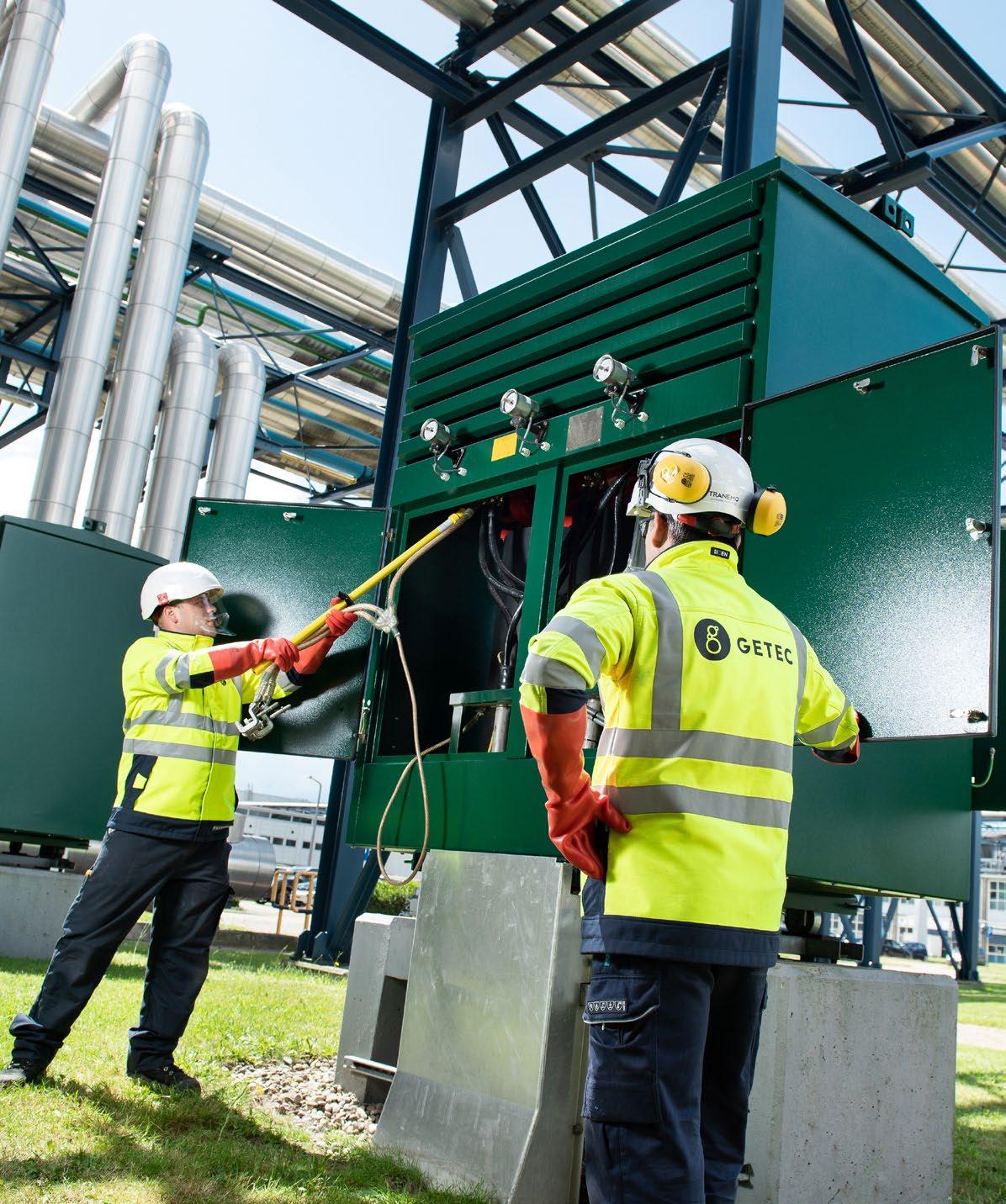

Just because there’s an inspection sticker on a ladder doesn’t necessarily mean that it’s safe. It could have been run over by a forklift in the meantime, unreported or unnoticed by anyone. However, according to DIN standards, this ladder would be considered safe. That’s why there’s a sticker on it.
The Hearts & Minds safety program differs fundamentally from the traditional way of working solely on the basis of DIN standards, adding valuable aspects to the company’s safety approach. The modular training program was introduced at GETEC PARK.EMMEN in the Netherlands in 2012 and is already a standard aspect of the company’s culture. The basic idea of Hearts & Minds is that employees not only implement safety standards because they have to but because they truly understand them and have taken them to heart, working with their colleagues to improve them. Hendrik van der Ploeg, Head of GETEC PARK.EMMEN, uses a practical example to illustrate what this actually means. “We needed to convert a gas turbine as quickly as possible and had planned three consecutive eight-hour shifts – including a night shift – to achieve this. This complied with the standard and was how we had always done things. On the basis of the Hearts & Minds philosophy, the team questioned this approach. Their question was whether it would not be safer to perform the same work over two ten-hour shifts, leaving the night for recovery. The benefits were clear. First, this plan is safer because people generally work more safely during the day than at night because they are able to sleep as normal. And the idea also delivers economic benefits. We only need two specialists instead of three and, of course, most people work more efficiently during the day than they do at night. Because our employees took the initiative, we were able to improve.”
The Hearts & Minds program is a toolbox of various modules which helps the organization to operate safely and on the basis of individual initiative. This mindset – as the experts say –doesn’t just happen by itself but requires a change in the company’s culture. For example, the error culture. Tjisse Noordhuis, Manager Park Services: “In my opinion, Hearts & Minds is about encouraging employees to admit their mistakes so that everyone can learn from them. This requires an atmosphere of openness and courage because it isn’t easy to talk about one’s own mistakes. The prevailing culture in industry is to look for someone to blame and punish them. We’re not looking to point the finger at anyone. We want to improve the way we work and make it safer. That is efficiency.” Another key factor in the success of individual responsibility is to give employees the right information at the right time and a certain degree of freedom to make decisions themselves. Of course, this does not make everything magically better straight away. Hendrik van der Ploeg: “For example, anyone can make the decision to shut down a process. This approach needs some getting used to, especially for us managers. However, even if it might result in the occasional unnecessary shut-down at the start, this is the only way for employees to learn to make safe and sensible decisions.” This change in approach is certainly worth it. The safety culture at GETEC PARK.EMMEN has developed positively, which is underlined by the fact that there were no accidents at work in 2021 (LTIR).
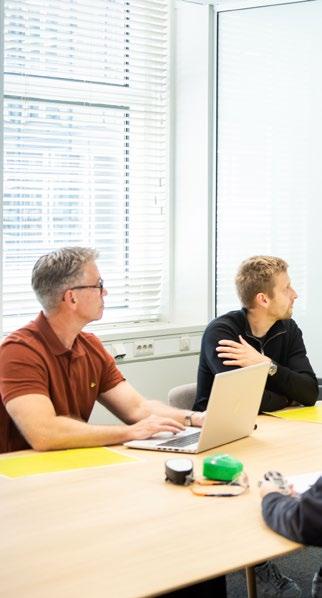
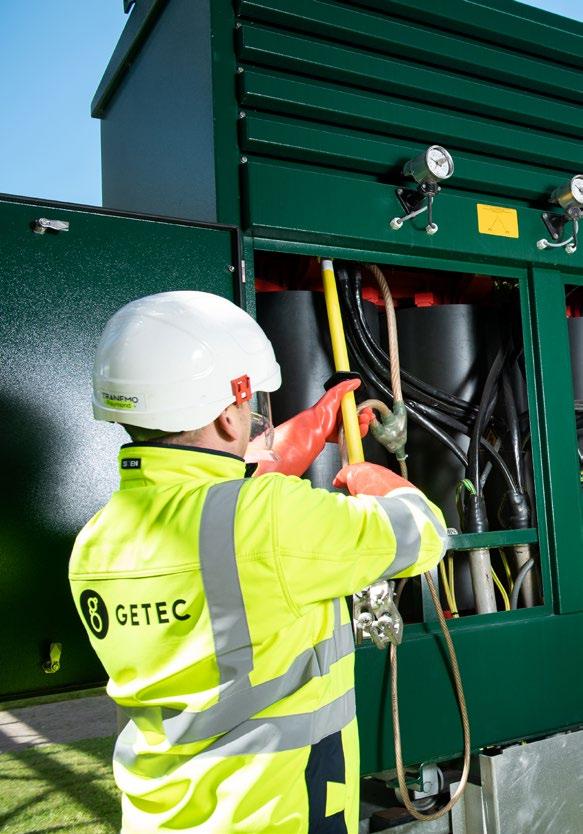
A high-voltage transformer from 400 volts to a maximum of 10,000 volts requires regular maintenance by electricians. To do this, the electrical current must be switched off. Among other things, the specialists have to move the thick grounding cable with a special seven-kilogram pole. Under no circum stances can the grounding cable be allowed to touch other cables because this would cause a dangerous short circuit which could be fatal. Standardized safety processes are used for this intervention in the high-voltage power circuit. This situation is less impacted by the Hearts & Minds program because the inherent risk to life means that there has always been a strong awareness for safety. Raymond Harms, techni cal specialist: “There is a risk to life when moving the ground ing cable which is why clear rules are in place and there is no room for discussion.” Jamie Nijholt, technical specialist: “One rule is that I can’t move the grounding cable on my own. The regulations require that this is always done by two people who have the appropriate qualification and have completed special safety training. ”
Technical specialist Jamie Nijholt moves the grounding cable of a high-voltage transformer, watched by his colleague Raymond Harms (not pictured).
Safety Officer Stephanie Fekkes at a safety meeting with Peter Nillesen (Project Manager/ Manager Operations), Robin Meinema (Senior Administrator), Silvia Zwiggelaar (QHSE Coordi nator) and Yvonne Wessels (engineer).
Hydrogen sulfide is hazardous to humans which is why anyone who works close to the waste water treatment plant needs to carry an alarm and a face mask. Sometimes, hydrogen sulfide is released to the air during treatment processes. Training sessions and meetings are held to ensure that the employees behave responsibly in this environment. Stephanie Fekkes, Safety Officer at GETEC PARK. EMMEN, leads many of these meetings. Her philosophy: “At every meeting, I try to not only explain the rules but to make it clear why we have these rules. At the end, the employees should understand that the rules are their rules and for their protection. I want them to internalize the rules and implement them individually. The technical term for this is “intrinsic motivation.” As the Safety Officer, my ap proach is that, if something happens, I don’t just investigate what happened but also why it happened. Say a colleague has been injured because he was working too fast. I want to know: Was he tired? Was the pressure too much for him? Or perhaps he didn’t have the right equipment? Finding out why enables me to change the situation permanently.

Patrick Bloemsma and Erik Renkema use a forklift to move octagonal boxes known as OctaPacks full of granules around the warehouse. The drivers almost dance their vehicles around each other. They are an experienced team and their work not only presents a risk to the drivers but also to colleagues or external visitors using the designated walkways inside the warehouse. Stephanie Fekkes, Safety Specialist: “”If something changes here, everyone has to monitor this change critically. For example, the customer recently changed the packaging material for the OctaPacks. Now we need everyone to tell us their opinion. Does this present a risk? Is the new material as stable as before? What have I observed in practice? To do this, everyone needs to 1. be informed in advance, 2. analyze their own work areas and 3. share this knowledge.”

It is GETEC’s corporate policy to conduct all its activities in a responsible manner in order to protect and foster the health, safety and well-being of its employees.
Many of our employees work in maintenance and service or in installing our energy solutions in plants or on construction sites. They are therefore exposed to the risks that are usual for the industry. Accidents can have considerable consequences for GETEC, both economically and socially. We feel the same sense of responsibility for workplace safety when it comes to our contractors. And customers may also stipulate occupational safety requirements that need to be considered in our occupational health and safety management system.
We want to provide a healthy environment to everyone who works for us and give them the training they need to be able to move with foresight and routine in this environment. Moreover, healthy employees are the foundation of our success. Occupational health and safety remains one of the material topics that impacts the entire GETEC Group. In some cases, separate conditions apply for the employees of our platforms. These are shown in tabular form starting on page 90.
in combination with other GRI 403 requirements
The Health, Safety, Security and Environment (HSSE) Policy applies to all consolidated GETEC Group compa nies on all platforms. Due to regional requirements such as national legislation, each platform has its own independent HSSE management system. This is aligned with the Group’s objectives and is regularly reviewed at Group level.
The Group Executive Committee of the GETEC Group has overall responsibility for the HSSE Policy and its im plementation. Day-to-day business is steered by the management and HSSE departments of the regional plat forms. They are responsible for implementing the HSSE Policy in line with Group requirements, for adapting it to comply with local needs, regulations and laws, and, in the event of an operational incident or emergency, for its application. Moreover, all our managers have the task of strengthening occupational safety in their areas of responsibility and of setting a good example in their day-to-day work. All employees, suppliers and contractors are obliged to familiarize themselves with the statutory and company requirements as well as the particular environmental and occupational safety risks that apply to the field in which the company operates. The HSSE targets are uncompromising: no serious accidents involving employees; no fatal accidents at work involving employees and the company’s partners; no serious accidents at the premises of partners and sub contractors.
Our goal is prevent accidents from happening. To this end, we have developed our 360° Safety Culture. The approach encompasses nine principles ranging from the creation of awareness for safety and the estab lishment of effective safety standards, through extensive training, to the rapid investigation of events. We consider HSSE from a 360-degree perspective that covers customers, partners, employees, subcontractors and society. We provide information material and instructions on how to implement safety and security measures and what to do in the event of an accident.
Health protection, occupational and process safety, and environmental protection are accorded the highest priority at GETEC and are core elements of our ESG strategy.
We have anchored a proactive and generative safety mindset within the Group.
We will align our organization with the goal of achieving zero accidents
We will ensure transparency and clarification – we investigate every incident in order to understand its causes and make lasting corrections.
We establish effective safety standards anchored in target agreements and implement measures consistently
We view HSSE from a 360° perspective that includes our customers, partners, employees, subcontractors and society at large.
We promote and provide training to increase safety awareness and behavior within the Group.
We intervene promptly and proactively to prevent potential accidents.
Our occupational health and safety management system applies across the GETEC Group and complies with the relevant legislation in each country. In addition to our 360° Safety Culture, our HSSE Group Policy and our strategy and targets, our occupational health and safety management system encompasses the following elements: a wide range of process and operating instructions intended to ensure the safe operation of plants; documented training; an accident and incident reporting system combined with root cause analysis and measures for the continuous improvement of the working environment and individual conduct; hazardous substance management; plant- and activity-based hazard assessment; health management; subcontractor management. We also provide our employees with high-quality protective work wear.
Examples of our safety culture in practice are reported as Safety Moments, which comprise the first agenda item at company meetings. If an accident or near miss has occurred, this will be discussed. Or there are brief reminders on topics such as COS: cleanliness + order = safety. The regular Stand-Up Meetings introduced last year in the operational area are used to discuss in detail any unsafe situations that have been identified and any near misses in order to draw attention to potential sources of risk. In order to anchor these principles more strongly in our day-to-day work, we have added occupational safety as a performance parameter on the feedback form used in the annual employee dialog.
In addition to the legally prescribed reporting obligations, GETEC has a system for reporting accidents at work, commuting accidents, near misses and unsafe situations. A detailed process describes the accident reporting system and is applicable to all employees. The goal is to ensure a standardized and uniform reporting chain in the event of accidents at work, commuting accidents, near misses and unsafe situations. This procedure also ensures that management is immediately informed in the event of an incident and that standardized measures are implemented. In addition, the relevant department works with the respective HSSE department to perform a root cause analysis and a safety evaluation in order to rule out repeat accidents. This is done by asking the persons involved specific questions to determine the cause of an error or problem. The root cause analysis is aimed at eliminating the actual cause rather than the symptoms so that similar sources of danger can be avoided in the future. It uses the 5W method, which repeatedly asks “why” to assess the incident in increasing detail and quickly uncover the root cause.
As well as recording and evaluating individual steps, root cause analysis serves to determine preventive action, thus helping to continuously improve occupational health and safety. The HSSE department of the respective regional platform is responsible for subsequently updating the relevant processes, for example, and for implementing further improvements. Management is responsible for ensuring the implementation of and compliance with processes via the management cascade.
Each incident – for example, each accident that results in medical treatment (medical treatment case, MTC), accident at work resulting in lost working time, commuting accident, near miss or unsafe situation – must be reported to the respective direct supervisor immediately. The supervisor informs the regional platform’s HSSE department without delay using the procedure that has been defined for this purpose. Central accident statistics are also maintained by the regional platform’s HSSE department. Accident figures are reported using the most common international occupational safety indicators (TRIR – total recordable incident rate and LTIR – lost time injury rate).
See the table on page 90 with information about the individual platforms.
The Group HSSE Committee meets each month. Its members are the Group CEO, Group COO and those respon sible for HSSE for the platforms. The purpose of this meeting is to monitor the targets that have been set by way of indicators, identify measures and initiatives to attain the targets, standardize and refine HSSE topics across all the platforms, foster dialog and share best practices.
In addition, various occupational health and safety meetings are held regularly at GETEC’s regional platforms. In Germany, this is the Occupational Safety Committee (Arbeitssicherheitsausschuss, ASA) which has the task of discussing issues relating to occupational safety, plant safety, occupational health and prevention, con sulting on measures and preparing decisions. The Occupational Safety Committee meets at least once every quarter and then reports to GETEC’s management. It is made up of the Head of HSSE, representatives from the works council, safety experts, (technical) managers from various departments and the company’s medical officer. The safety committees for the other regional platforms work in the same or a similar way.
Our employees participate in developing, implementing and assessing our occupational health and safety management system in the following ways: All necessary information is made available in our intranet. It includes the 360° Safety Culture and HSSE Policy, the process and operating instructions and detailed forms for plant safety and hazard assessments. We have also initiated an employee survey on occupational safety for the platforms, which enables our employees to provide their specific feedback on issues that are relevant to them.
We conduct meetings with employees who are returning to work after their recovery following an accident at work. Such meetings are led by the employee’s supervisor. The goal is to identify and define suitable measures to prevent similar accidents. The involvement of the employee affected is invaluable in this respect.
From early 2020, the COVID-19 pandemic meant that our company had to introduce additional processes and structures. We established a Coronavirus Crisis Team which met at least once a week during the reporting period. It was responsible for collating and evaluating information about the company’s situation and its employees and about the political and regulatory environment in order to develop suitable measures for the company. The Crisis Team steered implementation of the measures and monitored their effectiveness.
It was made up of the GEC members and specialists from the Communications, HSSE and HR departments. The Crisis Team issued various HSSE instructions in which it defined and regularly updated measures to protect the health of employees, customers and business partners. The measures included the RVT (recov ered, vaccinated, tested) rule, the “hands, face, space, fresh air” formula, room use concepts, temperature measurement, new visitor regulations, the introduction of mobile working, business travel restrictions, virtual meetings by video, testing for employees and much more. Our employees could access information about the latest occupational health measures via the company’s intranet and were given regular updates in video podcasts by the GEC and the head of the Crisis Team. GETEC was able to successfully manage the coronavirus year 2021 by taking the right measures at an early stage, providing information frequently and implementing its plans systematically. Due to the Group’s growth, additional coronavirus crisis teams have been established for each platform. They address specific regional regulatory requirements and report the status on a weekly basis to the head of the Group Coronavirus Crisis Team using a coronavirus dashboard. The number of cases among employees in 2021 was largely in line with the respective regional averages. Employees were proven to have been infected at work in just three cases, which is evidence of the effectiveness of the measures that were taken.
Our occupational health and safety system is underpinned by continuous training and development measures. We also use an online training system to offer various safety training sessions, either as mandatory annual training or as additional briefings. Both technical employees and office staff must receive training on certain topics. Supervisors are responsible for assigning training measures to their employees. There are various train ing packages depending on an employee’s activity profile. Training for office staff includes fire prevention, first aid and electrical hazards. The package for technical employees includes additional training in the use of personal protective equipment and the maintenance of plant and machinery, the safe use of tools, hot media and hazardous substances, and the use of ladders and step ladders.
See the table on page 90 with information about the individual platforms.
We expect our business partners to ensure a safe and healthy working environment in their companies. Sup pliers are expected to ensure the high quality of their business processes, especially concerning occupational health and safety. Our Supplier Code of Conduct defines the following requirements: Our business partners comply with the principles and applicable provisions of occupational health and safety in the workplace. They ensure appropriate controls, safe working procedures, preventive maintenance and the necessary technical protection measures to minimize occupational health and safety risks and ensure a safe working environment for their employees and third parties on the basis of applicable local legislation. Our service agreements also include a clause concerning the reporting of accidents to GETEC.
If the employees of one or more contractors or independent subcontractors work at a specific location, the companies must cooperate concerning safety and health protection. In particular, they must appoint a coordinator to plan operations if this is necessary to prevent potential hazards to each other’s employees. The coordinator must have certain qualifications and the necessary authority to issue instructions to prevent spe cific hazards. GETEC manages the cooperation between several employers by way of an operating instruction, a health and safety plan and a questionnaire to be completed by the coordinator.
Each platform has its own occupational health and safety management system in order to comply with local requirements.
PF D
HSSE manage ment system
Certification
Occupational health Occupational health services (GRI 403-3)
Certified to ISO 14001 and ISO 45001; G+E GETEC Holding GmbH, Magdeburg
Replace the existing decentral occupational health services: Central provision of medical care services by BAD Gesund heitsvorsorge und Sicherheitstechnik GmbH – an expert for occupation medicine, occupational safety and health management; various contacts close to each location
Status 2021; other GETEC companies to follow
Implemented in 2021
Occupational health Promotion of worker health (GRI 403-6)
Ergonomic office furniture at the Berlin and Hamburg locations: Office concepts with spaces to retreat; workplace inspections in accordance with local HSSE standards (in collaboration with the works council); at the Magdeburg site: running group (participation in competitions), prevention measures (workshops, health days), collaborations with gyms, company sports offerings
Occupational health Sustainable health management Health management (communication, management training, change management); a structured analysis is performed to establish health management requirements
PF ITA HSSE manage ment system Certification
Accident pre vention Reduce accident figures (LTIR, TRIR)
Occupational health Occupational health services (GRI 403-3)
PF CH
Established
Reassessment and structuring planned for next year
Certified to ISO 14001 and ISO 45001 Certification ongoing until 2023 and 2024, respectively
Improved online training and e-learning, improved root cause analysis and communication, for example, by way of Safety Moments
One occupational health physician with a coordinating role; eight additional occupational health physicians who work for the company throughout Italy
Rolled out in 2021
Established
GETEC in Switzerland is a signatory to Responsible Care, an initiative by the International Council of Chemical Associations which is commit ted to the protection of people and the environment.
HSSE manage ment system Certification
Height ened safety requirements in the chemical industry
Reduce accident figures
Certified to ISO 14001
360° Safety Culture program
Weekly safety meetings of the heads of the operational departments with management and the HSEQ department (safety issues, implementation of measures)
Documented safety checks of all employees (central analysis, definition of countermeasures)
The need for ISO 45001 certification will be assessed as necessary
Introduced
Established
Established
PF NL
The Hearts & Minds safety program introduced by Platform Netherlands is considered best practice for the entire Group. The platforms’ HSSE departments will assess which of the training modules can be used at other sites.
HSSE manage ment system Certification
Improvement in safety culture
At least one rung higher on the safety culture ladder defined by the Hearts & Minds program
ISO 14001 and ISO 45001 (GETEC PARK.EMMEN, ISO
for the logistics area)
Use the Hearts & Minds program to increase awareness of safety (five-rung safety culture ladder: pathological, reactive, calculating, proactive, progressive); status of Platform Neth erlands: between “calculating” and “proactive” Use Hearts & Minds updates, initiate improvement measures, develop a training program for all platform employees, roll out a suitable Hearts & Minds program in each department
Achieved
Continue implement ing the program: 2022 and subsequent years
Topic
Height ened safety requirements in the chemical industry
Reduce accident figures Implement and refine high standards: Continuous training to build awareness Safety dialog (also at safety meetings) (Sub)contractors: external audits, add clause to purchasing terms and conditions to sharpen focus on safety of con tractors
Roll-out of HSSE survey being planned Improvement of quarterly HSSE reviews (focus on project assessments)
2021
Occupational health Occupational health services (GRI 403-3)
Occupational health services on site Established
Occupational health Additional offerings Medical check-ups (voluntary); focus: psychosocial impact of work 2021
The number of accidents resulting in lost working time (one day and more) per million hours worked (lost time injury rate, LTIR) during the reporting period was 5.48 (2020: 3.14). There were no fatalities or serious accidents. We continue to measure the total recordable incident rate (TRIR), which stood at 9.23 per million hours worked in 2021 (2020: 7.5; difference due to recalculation*).
* The TRIR for the Group was
the
Employee occupational safety TRIR – number/million hours
Employee occupational safety LTIR – number/million Hours
Fatal accidents at work involving employees and partners
for 2020.
a value of 5.96
and now assume a higher value of 7.5.
31, 2020
31, 2021 Target for 2030
annual improvement
annual improvement
The Group has established safety processes and standards for assessing the effectiveness of the measures that have been taken. Theses include, for example, safety checks, internal and external audits, and the perfor mance of hazard assessments. Nevertheless, more accidents occurred in the reporting year than in 2020. The increased number of accidents in 2021 occurred mainly in the regional platforms in Switzerland, Germany and Italy. In terms of frequency, the causes revealed the following picture.
Analysis showed that the causes were attributable to:
from a lack of safety awareness
training in some cases
In Italy, the main reason for the increased number of accidents was the platform’s growth. The 28% expansion of the workforce resulted in a backlog of training for new employees. They should be trained and onboarded properly first.
As a matter of principle, the cause of each incident was investigated. We therefore amended our management approach and initiated countermeasures, some Group-wide and some regional. In particular, we will be assessing whether the proven Hearts & Minds concept from Platform Netherlands can be deployed across the Group.
Group Implementation of Group HSSE Steering Committee
Continuous dialog about accidents and root causes within the Group Steering Com mittee
Roll-out of HSSE survey (launched in Switzerland in 2021; already completed in Italy; platforms in the Netherlands and Germany to follow in 2022)
Review the roll-out to other areas of the Group of best practices such the Hearts & Minds program from Platform Netherlands
Develop specific roadmaps for each platform
HSSE information letters from the Group CEO to all platforms
Stronger HSSE communication between the platforms (including use of Safety Mo ments content from other platforms)
Focus on assessing near misses and unsafe situations as these may be indicators of potential (serious) accidents at work
PF Germany
Stronger focus on plant inspections and on-site safety checks (equipment, tool checks, documentation)
Intensify obligatory Safety Stand-Up Meetings
PF Italy Continue to grow HSSE team
Monthly communication campaign covering various safety topics initiated (safety drive, overconfidence, etc.)
Defibrillator training for first aid teams Management safety day planned for 2022
PF Switzerland Development of extensive safety action plan
HSSE survey conducted
Conduct a slip and trip course for all employees
Stronger HSSE communication like the HSSE roadshow
PF Netherlands Development of extensive safety action plan
HSSE survey planned for 2022



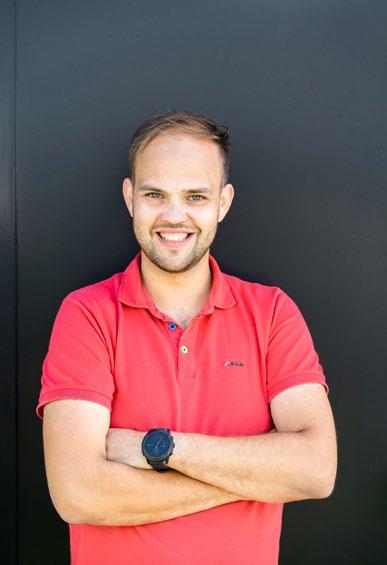

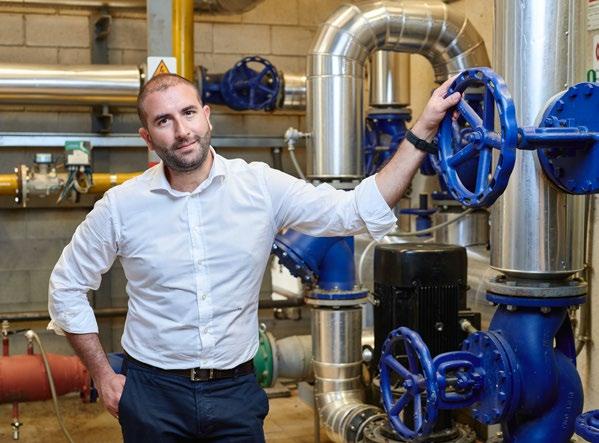
Percentile*
STATUS QUO 2022
25th–49th percentile
TARGET FOR 2027
At least 90th percentile
TARGET FOR 2025
75th–89th percentile
The response rate of 85.4% was slightly higher than the outstanding figure for 2021
Slight year-on-year improvement in Q12 result but still in middle percentile
Significant year-on-year improvement in overall satisfaction
· Increase of 5% for employees with strong emotion al ties

Viewed overall, we also achieved a slight improve ment in our strengths
We worked hard on our weaknesses and achieved a significant improvement
* EXPLANATION OF PERCENTILE: The 25th percentile indicates that 75% of the working groups are above this result. The higher the percentile, the stronger this element in comparison with the database. The percentile rating is used as a reference value for comparing the results of your team with those of other teams.
** EXPLANATION OF POINTS: Up to five points can be allocated. The strength or weakness of the number of points does not depend on the abso lute number of points but on how comparable working groups answered the same question. The basis for the reference group is the Gallup database.
know what
colleagues have
work, employees’
salary and incentives are fair in relation to the market for people who do a similar

work, there
the opportunity
have a clear understanding of my company’s future
is open communication across all levels of my company.


“The unimaginable happened in the early morning of February 24, 2022: Russia attacked Ukraine.” These were the opening words of GETEC’s in-house appeal for donations. The company committed to matching every euro donated by employees. Our employees’ generosity exceeded all expectations, raising €250,000 – a quarter of a million – for the Ridni Foundation. This organization already ran orphanages and social centers during peacetime. Following the outbreak of the war, it has been necessary to arrange the relocation of children and their caregivers who were living close to the front line. On the one hand, the money donated will benefit Ridni’s fostering program. It will also facilitate the completion of the Center for Social Support for Children and Families and the Spilnota Center for 16 orphans. Mariana Romaniak, CEO of the Ridni Foundation: “We are very grateful to GETEC for their support for the orphans. The only way we can help children who have suffered the effects of war is to collaborate with people who have an open heart for the problems of others. Thanks to GE TEC’s generous donation, around 70 orphans and children in difficult circumstances will be able to live in new high-quality conditions and provided with everything they need for their healthy development and psychological well-being.” The request for donations was not just a short-term campaign. GETEC will continue to support the Ridni Foundation.





Only a company with values that it lives by, which customers trust and which can be relied on will be successful in the long term. GETEC prioritizes these values and regularly trains its employees to raise their awareness for compliance issues. Anoth er focus is cybersecurity. Despite an increasing number of cyber attacks, GETEC did not record a single data security breach in 2021.

Based on the GETEC Group’s business model, the company’s overarching policy also includes environmental policy. The guiding principle is that all activities must be conducted in a responsible manner in order to protect the health and safety of employees, customers, contractors and society. Day-to-day business decisions should be taken in a way that minimizes impact on the environment. This policy is derived from GETEC’s ESG vision.
The HSSE (Health, Safety, Security and Environment) Policy applies to all consolidated GETEC Group companies on all regional platforms. In response to regional requirements (for example, laws), each platform has an HSSE management system adapted to the local situation. It is closely aligned with the Group’s objectives and is regularly reviewed at Group level.
As far as environmental compliance is concerned, activities must be designed and steered in such a way as to prevent pollution and other impacts on the environment and health. Full consideration must be given to environmental aspects such as biodiversity. Since environmental compliance is largely the responsibility of the regional platforms, they must work to continuously improve their HSSE performance and measure this against targets. On account of the great importance of environmental compliance, GETEC Group management ensures the availability of all necessary resources.
The GEC of the GETEC Group has overall responsibility for environmental compliance as an aspect of the company’s HSSE Policy. Day-to-day business is steered by the HSSE managers for the regional platforms. They are responsible for implementing the HSSE Policy in line with Group requirements, for adapting it to comply with local needs, regulations and laws, and, in the event of an operational incident or emergency, for its application. All employees, suppliers and contractors are obliged to familiarize themselves with the statutory and company requirements as well as the particular environmental safety risks that apply to the field in which the company operates.
Environmental compliance has the following objectives:
No violations of technical and environmental regulations (concerns, for example, power plants)
Avoid incidents and entirely prevent serious accidents
No health hazards or environmental damage
In order to attain these objectives, we have implemented a number of preventive concepts to ensure safety in production, transport and warehousing. For example, there is detailed documentation for our plants covering safety installations and protective measures such as leak controls, leak sensors, overfill protection and limit indicators. For the safety concept, the risks the plant may present to, for example, water, are assessed. This is followed by an analysis and assessment of the plant design (for example, calculation and definition of the necessary retention capacity, measures to identify and fight fires and retain the extinguishing media).
To avoid emissions of chemicals, fuels or oils, we have extensive operating instructions that comply with legal requirements (safety data sheets). These describe protective measures and rules of conduct – from handling, through storage, to protective clothing and hygiene.
Preventive measures to avoid emissions or the escape of substances (for example, gas or oil; platforms in Germany and Italy).
Retention vessels (double-walled or with leak monitors) have been installed in the plants to protect the environment from hazardous substances. These are inspected by third parties, for example, at the plat forms in Germany and Italy.
There are operating and process instructions defining how employees must handle hazardous substances in order to protect themselves and the environment.
As an energy services provider which is actively shaping the climate transition, we consider it a matter of course to use state-of-the-art filter technology for energy-efficient and emission-reducing plants. This is already included when designing the plants. Threshold compliance is assessed during the approval test by the authorities.
This is an aspect of, for example, approval applications for plants. It is performed before construction by way of a third-party review of noise emission forecasts.
Company-wide work processes governing labeling, storage, handling and transportation of hazardous substances
There are also extensive operating and process instructions for handling hazardous substances.
Regular training on company-wide work processes governing the storage, handling and transportation of hazardous substances
Annual training is provided on how to handle hazardous substances, divided into different substance classes.
Every two years, Platform Germany provides training for asset managers on the Federal Immission Control Act (Bundes-Immissionsschutzgesetz, BImSchG), covering various aspects of industrial environmental protection and the corresponding operator obligations.
Work processes implemented or innovative technologies to reduce, reuse and recycle waste Platform Switzerland uses the ecological and economical waste-to-value approach to create sustainable closed material cycles. The central power plant with waste incineration generates the power required and mineralizes the site’s waste.
At office sites, a new instruction was created to regulate the separation of waste and an entirely new waste management system was implemented.
We respect biodiversity by conducting extensive risk analyses before implementing new projects at a site. Before any planned operational activities, we commission an environmental compatibility study to identify the potential impact on biodiversity (local environment, fauna, protected areas, endangered species). This type of study is carried out when planning new plants, for example. It examines the impact on the environment of the construction and operation of the planned plant.
For example, before we build and operate a district heat and electricity plant, we record the project and site characteristics and local biodiversity issues. It is examined whether the site is in or adjacent to a nature reserve, protected habitat or other protected area. We also determine the expected effects – from surface sealing or the potential emission of hazardous substances, through the impact on water resources, to air pollution, noise emissions and the impact on flora and fauna.
Example: Before constructing a thermal oil heating plant for a customer, we first checked whether the construction site and its close vicinity were home to reptiles. Since the planned site was a potential habitat for these strictly protected species, we had to comply with species protection legislation. However, no reptiles were found during an inspection of the construction site and neighboring areas conducted under optimal conditions. We would otherwise have implemented compensatory measures.
In the reporting year, we coupled our customer satisfaction survey with the promise to plant a tree for each questionnaire completed. Customer feedback is one of the most important factors in a collaborative partner ship. That is why we ask our customers each year about their satisfaction in general and our joint projects in particular. The result was that we planted a very large number of new tree in the Heideland-Drössig reforesta tion area. In this way, we generated more customer feedback than in previous years and we were also able to make a small contribution to climate protection.
The GETEC childcare facility at the Magdeburg site of the Germany regional platform makes a further con tribution to biodiversity. In 2019, working with a local beekeeper, the childcare facility became the sponsor of two beehives with dedicated flower beds and a wildflower meadow as food sources. As a side effect, the young generation has the opportunity to learn about species protection and diversity at an early age.
We also expect our partner companies to have a functioning environmental compliance program and to satisfy the following requirements:
Compliance with all applicable environmental, occupational health and safety regulations is ensured.
Their products are developed, manufactured, transported, stored, used and disposed of safely and in an environmentally compatible way.
The environment, human life and health are protected against any hazards that might arise in connection with their manufacturing processes and products.
They operate in a way that minimizes the use of resources, recycling and/or reducing waste and emissions to the air, water and soil in such a way as to limit their impacts on human health, biodiversity, climate change and water scarcity.
Environmental management system certified to ISO 14001
In addition, Platform Germany holds regular environmental meetings. These review and monitor compliance with threshold values and discuss specific countermeasures in the event of violations. Moreover, the responsible authorities conduct regular plant inspections as well.
For Platform Germany, the following environmental issues, laws and regulations are relevant.
Emission control: Monitoring of existing plants that require a permit under Germany’s emission control leg islation, plants as defined in the 42nd and 44th Ordinances on the Implementation of the Federal Immission Control Act
Preparation of permit procedures, monitoring plans and emission reports in accordance with Germany’s emission control legislation
Reporting, for example, renewable energy levy, self supply with energy, energy statistics
Preparation and submission of emission statement in accordance with the 11th Ordinance on the Implemen tation of the Federal Immission Control Act
Preparation of applications and support for necessary modifications to existing plants that require a permit under Germany’s emission control legislation
Performance of permit procedures and preparation of application documents (permits for new plants in accordance with the 4th Ordinance on the Implementation of the Federal Immission Control Act and permits for modification in accordance with section 16 of the Federal Immission Control Act)
PF ITA
Environmental management system certified to ISO 14001
Transport of chemicals, oil or fuels by qualified subcontractors
Chemicals stored in retention tanks
Safety data sheet for each chemical
Operating instruction for the use of chemicals (including environmental section)
Updating of the “Reporting and analysis of incidents” template
PF CH
Environmental management system certified to ISO 14001
Regular site inspections and, if necessary, refurbishment of the non-discharging sumps (catch potential leaks from containers, tanks and plant components)
Water runoff from the site’s roads is removed via a rainwater drainage system. This is constantly monitored (pH, TOC, turbidity) and switches automatically to the retention basin if a threshold value is exceeded. The rainwater is only released to the Rhine after analysis and approval. If any pollution is identified, it is either treated on-site, pumped away for further treatment or slowly transferred to the waste water treatment plant via the industrial waste water drainage system.
The industrial waste water drainage system collects contaminated waste water at the site. This is either pre treated at the site’s own plant (AVORA) or transferred directly to the waste water treatment plant. This waste water stream is also monitored both at the point it leaves the production facility and by a continuous central system. If threshold values are exceeded, it will be automatically rerouted to emergency tanks.
In 2021, there were ten incidents involving the release of environmentally hazardous substances. There was no lasting damage to the environment in any of these cases because the safety concept (retention in non-discharging sumps/cellars, rerouting to emergency tanks, removal of leaks by the company fire brigade) functioned well. The causes of the substance releases (defective gaskets or connectors or damage to con tainers) were remedied immediately. Other measures included shortening maintenance cycles and providing employees with additional training on securing loads.
Platform Netherlands
PF NL
Environmental management system certified to ISO 14001
Various safety precautions for employees, visitors and contractors are documented in the handbook of applicable rules and regulations.
Regular ADR inspections are performed (at supply and logistics companies) and annual ADR reports are produced (no reportable incidents).
Various regulations and processes to ensure environmental safety, for example, spill control (laboratory and logistics), handling hazardous waste, handling logistics-related damage and incidents, storage of hazardous substances in accordance with Dutch regulation PGS 15. Complaints process exists
Environmental reports are recorded in the incident registration system.
GETEC’s HSSE departments operate a control system. Internal audits are conducted regularly at the regional platforms. These include the environmental meetings held at Platform Germany. If one of these audits reveals non-compliance with any provisions, the persons responsible immediately initiate the necessary countermea sures.
GETEC’s compliance organization also conducts ad hoc and general audits. If necessary, changes are made on site and regulations are amended and supplemented.
In addition, the authorities monitor compliance with statutory environmental regulations. Since all the platforms are certified to the ISO 14001 environmental management standard, regular external audits are performed anyway.
value of
number of non-monetary
For a company like GETEC, ethical conduct is both essential and a matter of course because our business success is highly dependent on the reputation we enjoy on the market. Compliance violations could result in criminal or civil litigation, which might jeopardize the company’s future development because assets are withdrawn, refinancing has become more difficult or the company experiences other disadvantages as a result. Compliance violations can also mean that the company is excluded from tenders, customers do not place orders or cancel those they have placed, or subcontractors no longer want to work with us. Corruption, especially, can undermine stakeholders’ trust in the company, resulting in litigation and fines and jeopardizing the company’s progress and innovation.
Upholding statutory, contractual and internal requirements and preventing corruption are of great importance in the business development of a company like GETEC. We already have to submit statements concerning our compliance with ethical business standards when participating in both public and private tenders.
Functioning environmental compliance (GRI 307) is another essential aspect of the business model for a company in our industry. Environmentally relevant laws must be observed. Failure to do so will result in fines, sanctions or environmental damage and will thus also have a negative impact on our good reputation. The GETEC Group’s compliance regulations apply to all consolidated companies.
The compliance management system serves two strategic goals:
1. It is aimed at preventing compliance violations across the Group.
2. This is intended to create a compliance culture with a reach that extends beyond the company. It requires both GETEC employees and external employees to proactively report on activities.
To this end, the following structures and processes have been established:
We have implemented an independent and autonomous compliance organization for the entire Group. Its independence is ensured by the direct reporting line to the Chairman of the Group’s Advisory Board. The compliance organization is authorized to implement all the measures it considers appropriate and to directly instruct other organizational units.
The Compliance department has a clear organizational structure and is guided by internal regulations cov ering everything from reporting, through investigation processes for compliance cases, through to training plans.
The compliance organization:
Investigates compliance violations
Takes the necessary action Acts on its own initiative
Independently organizes its tasks Acts on its own discretion to use external resources as necessary
Core tasks of the compliance organization:
Preparing proposals for new regulations or updates of existing regulations with compliance-relevant content
Preparing an overview of the parts of the GETEC Group that are particularly exposed to compliance issues
Preparing compliance audit plans and performing general compliance audits
Providing information and compliance training to managers and employees
Performing compliance reporting
Investigating compliance cases on an ad hoc basis
Preparing compliance audits
NOT included: Tax compliance
The platforms in Germany and Italy have their own compliance officers. The platforms in the Netherlands and Switzerland have in-house lawyers who are responsible for compliance issues in their respective countries and for investigating any compliance cases in their area of responsibility.
In recent years, we have continued to professionalize the GETEC Group’s compliance organization and pro cesses in the context of our platform strategy.
Specifically, this means:
Group-wide organization and regulations prepared by Group Compliance
Local implementation by the platforms’ compliance departments
Expansion of compliance training for the Group’s top management
Ensuring full participation by all employees in obligatory compliance training
All compliance units – whether at platform or Group level – can be contacted on compliance issues.
In the context of risk control, the GETEC Group has defined compliance-relevant areas of activity that are subject to a greater risk of compliance violations. They are assigned to a risk category (low, medium, high). On this basis, the Compliance Officer proposes audit focuses for the annual audit plan. In the first quarter of each fiscal year, the Compliance Officer reviews the compliance-relevant areas of activity to check whether they are still valid and amend them if necessary.
In 2021, the Compliance Officer again carried out a review to determine the activities with a risk of potential compliance violations (including corruption and bribery). He identified two constellations with a fundamen tally higher risk: corruption in procurement and in accounting (checking incoming payments and invoices).
In order to assess risks specifically, we apply the following risk classifications and categories:
In the Industrial Segment: Investigate the chain from ordering through protecting operational secrets to competition law.
In the Real Estate Segment: As in the Industrial Segment, but the use of brokers and consultants is also sensitive.
In Operations: Procurement, emission control and permits are considered to be a medium compliance risk.
In the central service units: Procurement (preventing corruption), Accounting, Finance and Treasury (check ing incoming payments and invoices, approving payments) are assigned to the high risk category.
In energy management: The focus of compliance is procurement.
Non-German business: Separate review of the specific risks in individual countries.
In order to minimize risks, we sanction compliance violations in various ways which are described in an extensive sanctions catalog containing standard sanctions for compliance violations that take place within and outside the GETEC Group. These sanctions range from reprimands and written warnings to dismissal (for employees) and delisting (for suppliers). The fundamental principle is that a sanction must be proportionate to the violation. The compliance officers of the regional platforms are responsible for this process. Individual cases may be decided at the discretion of GETEC Group management.
Our Code of Conduct (CoC) governs how we behave vis-à-vis our environment and how we aim to operate in full compliance with the law and with moral and ethical principles. The CoC:
Summarizes all basic rules of our conduct; Goes beyond strict compliance with statutory requirements; Ensures ethically and morally irreproachable conduct; Guarantees that our conduct is in compliance with the laws, guidelines and regulations that apply to us; Applies without exception to all GETEC employees and corporate bodies; Specifies what is expected from everyone at GETEC; Supports a responsible and respectful way of working.
All employees are obliged to familiarize themselves with the Code of Conduct, consulting their supervisor for guidance if necessary. In addition, all members of the top three management levels are required to provide formal confirmation each year that they act in compliance with our Code of Conduct. In 2021 and 2022, these compliance statements were submitted in full for Platform Germany. We are seeking to harmonize this approach across all platforms this year.
The CoC applies to the platforms in Germany, the Netherlands and Switzerland. The Italian platform has its own CoC, which will be aligned with the Group. In addition, each platform has its own internal guidelines to supplement the Code of Conduct. These cover signing powers, travel, gifts and invitations, in particular. They can be found on the intranet and should be studied regularly, alongside the CoC.
When employees join the company, they must participate in compliance training. Annual refresher courses are also held. Team meetings additionally include Compliance Moments, which aim to raise employee awareness of the subject. Any incidents are discussed and employees are reminded of the significance of compliance and the Code of Conduct.
December 31, 2020 December 31, 2021 Target 2030
Trained employees (Code of Conduct) – % 88 80 100
The training rate declined slightly compared with a year earlier. There are many reasons for this. First, the Group has undergone enormous growth, both in terms of the number of additional employees and the inte gration of new companies. For that reason, some compliance training events did not take place until spring 2022, especially for new hires who joined the company at the end of 2021. Then there were a number of cases in which the training tool was used incorrectly, which meant that attendance figures were not recorded correctly. These deficits will be remedied in 2022 and measures taken to raise the training rate again. For example, we intend to provide third-party online training to the Group’s top 50 executives. Moreover, SAM compliance training for all employees will be improved.
Compliance in the supply chain
We do not believe that our corporate responsibility is restricted just to our company. We also expect moral conduct from our business partners and stakeholders as well. Our Supplier Code of Conduct directly addresses our suppliers and communicates our understanding of fair treatment and compliant conduct in the supply chain. Any violations by our suppliers always reflect on GETEC as well.
The Supplier Code of Conduct:
Addresses service providers, suppliers, contractors, subcontractors and consultants;
Is an essential element of our business relationships; Must be expressly accepted by business partners when contracts are concluded (exception: the partner already has its own equivalent rules);
Is intended to have a positive influence on the entire value chain; Is the basis for collaborative partnership; Should be accepted by business partners and foster the appropriate conduct.
In the event of non-compliance with SCoC regulations, business partners must take immediate remedial action. We reserve the right to terminate agreements with business partners who are unable to verify their compliance with this SCoC in the course of a review (audit, assessment). Since 2020, suppliers have been gradually accepting the SCoC. The start was made with Platform Germany and its top suppliers. 77% of them had already accepted the SCoC in 2020. In the reporting year, this had risen to 84% of the top suppliers to Platform Germany. At the same time, we started the roll-out to other platforms. We aim to provide the KPIs for the entire Group in our next ESG Report. It remains our goal to ensure accep tance by all suppliers by 2030.
The SCoC applies to the platforms in Germany, the Netherlands and Switzerland. The CoC for the Italian plat form also applies to its suppliers. It still needs to be harmonized with the Group’s CoC.
In the context of the ESG Roadmap 2021, GETEC decided to review whether amendments to the German Cor porate Governance Code (GCGC) made it necessary to update the company’s own related documents. It was found that both the CoC and the SCoC were aligned with the GCGC and that no update was necessary.
As a matter of principle, we develop relationships lasting many years with our suppliers and contractors, which gives us good insights into these companies. The likelihood of supply chain risks occurring is therefore low. As much of the supply chain is located in the European Union, most suppliers operate in a well-regulated environment.
In its ESG Roadmap 2021, the GETEC Group outlined measures for sustainably developing the company’s procurement policy. The first elements (for example, regular quality audits of biomass suppliers) have already been implemented.
We use supplier audits to ensure that the respective supplier acts in accordance with the statutory require ments for its biomass products. This means that, in accordance with EEG, the biomass comes from renewable raw materials and landscaping products.
Also relevant for 2022 is the EU’s Renewable Energy Directive (RED II), which has been discussed in detail by our Regulatory Group. This Directive anchors the sustainability criteria for biomass in EU law and defines, for example, legal harvests, the preservation of soil quality, improvements in production capacity, biodiversity and the respect of protected areas. It concerns combined heat and power plants fueled by biomass and biogas plants, depending on the output, suppliers and dealers. If a company does not have a RED II certificate for its plant, it risks the proportional loss of its EEG feed-in remuneration. Training on RED II has already been provided by a certification body. Once the RED II requirements have passed into national law, we will include the relevant aspects in our supplier audits.
GETEC also assesses the risks specific to individual countries and industries. This risk assessment makes it pos sible to identify and evaluate the sustainability risks in countries where our business partners’ direct suppliers have their head office or, on the basis of supplier audits, use subcontractors from these countries. The goal of the analysis is to establish whether GETEC obtains raw materials or materials from a region or an industry which does not comply with minimum social and environmental standards or does not comply fully. We use the Corruption Perception Index (CPI) from Transparency International to evaluate country and industry risks.
Intensive assessment showed that we only operate in one country with a particularly high corruption risk: Romania. To date, there has been no case of corruption at our company in Romania and the company has received no information to this effect. As far as the potential risk of corruption at our Romanian site is concerned, a general legal opinion showed that the following forms of corruption are a criminal offense in accordance with Romanian law (Rom. Codul Penal, RCC): accepting and offering bribes (i.e., money or other unlawful advantages), offering a bribe by way of an intermediary with influence, purchasing the influence of an intermediary.
Such corruption risks may occur in connection with the following activities at our Romanian site: In dealings with public authorities (bribery and/or purchasing influence to obtain approvals, consent or licenses)
In dealings with the suppliers of goods and services (bribery and/or influence on human trafficking, prefer ential treatment of a certain supplier)
In dealings with our local customers (bribery and/or purchasing influence in order to obtain unlawful advantages or advantages in respect of the terms of the customer’s contract, accomplice in or instigator of potential corruption, criminal acts by the customer in respect of public authorities/suppliers in connection with the development of the plant it operates).
The following internal measures were implemented or recommended and are now being reviewed or imple mented in order to limit the risk of corruption:
GETEC Code of Conduct rolled out to all employees
GETEC Supplier Code of Conduct rolled out to suppliers
Dual control principle applied to orders, contracts and payment transactions
Regular participation in compliance training
Strict monitoring of payments made by or on behalf of GETEC Servicii Energetice SRL to third parties
Inclusion of a standard anticorruption clause in all contracts concluded by the Romanian site; the parties expressly commit to strict compliance with statutory anticorruption requirements and require the same of their representatives, employees and subcontractors.
Lastly, the corruption awareness of employees and representatives can be increased by including anticor ruption provisions and corresponding sanctions in the internal rules of conduct. In addition, regular training on corruption risks should be provided to those who have direct contact with the authorities and business partners.
The appointment of an anticorruption officer is also recommended to provide advice and monitor the situation.
The anticorruption code applied by our platform in Italy is exemplary. It is integrated into an organic and coherent system in order to prevent the risk of unlawful practices by management and all other functions. The anticorruption coordinator and advisor delegates the actual application of this code to a dedicated control instance which performs audits to monitor compliance with the provisions of the code and reports to the co ordinator every six months. The anticorruption coordinator and advisor regularly reviews the code on the basis of the audit findings and recommends necessary updates or amendments to the Advisory Board.
The following areas are considered vulnerable to corruption: gifts and hospitality, sponsorship and contribu tions to associations and facilities, recruitment and hiring of employees, freelance services, applications for business assistance and inspection of accounting records.
The anticorruption index used by the Italian platform governs:
The procurement and management of contracts
The supply of goods and services
Transactions (mergers and acquisitions)
Principles of conduct
Employee training and communication of the anticorruption code
Warnings
In order to comply with the anticorruption code, the following general rules of conduct must be observed: Separation of responsibilities: Different people must be responsible for operational activities and control functions.
Signing authorization system: Clearly defined signing authorizations must be associated with a person’s organizational and administrative responsibilities and used in accordance with the specified value limits.
Impartiality and absence of conflicts of interest: The recipients of the code must act professionally, impar tially and in accordance with anticorruption regulations. They must therefore avoid situations which might result in a conflict of interest.
Traceability and archiving: All activities and the associated controls must be traceable and verifiable at a later date.
PF D
PF ITA
Compliance Recording of compliance violations
SpeakUp whistleblowing system: see graphic Supplements proven reporting channels
Reports can be submitted by phone or electronically
Option for especially sensitive cases
Detailed instructions
Anonymity guaranteed because third-party service
Supply chain Sustainable procurement Sustainable procurement of materials and services: Procure materials and services in accordance with all appli cable laws and regulations as well as our own policies
Guideline for sustainable procurement for Platform Germa ny:
Used by the Technical Procurement department (excluding the procurement of energy and fuel)
Mandatory for all employees
Provides guidance on considering sustainability in pro curement
Supplemented by the instruction “Minimum requirements for procurement processes” (covers requirements for tenders, negotiations with contractors, awarding contracts, approving suppliers, contractual requirements and docu ment obligations)
Supply chain Supply Chain Act Germany’s Supply Chain Act will come into force in 2023, with the goal of improving the protection of human rights in global supply chains. GETEC is in the process of preparing itself to comply with these statutory requirements.
Socioeconomic compliance Integration of existing compliance requirements
Own CoC; harmonization of Italy’s existing compliance regulations (which are basically comparable with those of the GETEC Group) with the Group’s standard regulations.
Since 2019
2021: Creation of the basis for a pro curement structure
2022/2023
Mid-term target
Socioeconomic compliance
Recording of compliance violations
Own whistleblowing hotline Established
PF NL
Socioeconomic compliance
Anticorruption Anticorruption index: see text
Established
PF CH
Compliance Recording of compliance violations
Use of SpeakUp hotline, which is available in the local language
Established
Compliance Recording of compliance violations
Use of SpeakUp hotline, which is available in the local languages
Established
The core tasks of our compliance organization include procedures for regularly reviewing the appropriateness and effectiveness of the processes. For example, general compliance audits are performed or compliance procedures reviewed on an ad hoc basis. Compliance reporting facilitates control. Amendments are made if necessary. Regulations are amended and supplemented on a regular basis. The compliance organization is structured to ensure its independence in making continuous improvements.
In principle, our compliance management system has proven to be effective in recent years. In 2021, the compliance organization was assessed again in the context of the EcoVadis evaluation. Overall, the company was awarded a silver medal. Management accords high priority to this matter.
Compliance cases in figures
2021:
26 compliance cases investigated (2020: 39); 23 of these cases were closed (2020: all cases)
3 reports made via the whistleblowing system (2020: 5)
External compliance-related costs: approx. €5,000 (2020: approx. €31,000)
Dismissal by employer due to compliance violations: 1 (2020: 4)
We are targeting zero compliance cases in 2022.
December 31, 2020 December 31, 2021 Target for 2030
Trained employees (Code of Conduct) – % 88 80 100
Employee compliance – material incidents – number 2 0 0
Supplier compliance – material incidents – number 1 0 0
Technical and environmental compliance of power plants – material incidents – number 1 0 0
December 31, 2020 December 31, 2021 Target for 2030 i. Total value of significant fines 0 0 0
ii. Total number of non-monetary sanctions 0 0 (Material) Compliance cases related to data security 0 0 0
In 2021, we created the foundation for establishing a Group-wide procurement structure. We involved Procurement in implementing projects and in service and operation, especially for key product categories. Framework agreements enabled us to achieve a more favorable price structure and optimize processes.
The Procurement department is now responsible for purchasing all goods and services for GETEC – with the exception of primary fuels and the associated emission certificates.
The key product groups are:
Systems and components for our plants at customers’ sites; examples include components for heating and cooling, electricity generation in boiler and condensation systems, fuel supply, measurement and control equipment
Construction services and various assembly/dismantling services for the construction of plants Services, repair and replacement parts during operation IT systems and technology (hardware and software)
Commercial services and external consultancy services Facility management and fleet services
In 2022, the following activities are planned as central projects for further optimizing procurement structures:
Development of an app to create Group-wide transparency of procurement data and the quality of pur chase-to-pay processes
Creation of a product category strategy for those categories that are of strategic relevance to GETEC Establishment of an innovation management system in Procurement to identify key technological trends and, in conjunction with the relevant departments, assess their potential relevance for GETEC Development of a risk monitor to identify structural supply and cost risks and serve as the basis for deter mining suitable optimization measures
Further development of supplier management in the SRM system, including supplier assessments Extension of current ESG management in Procurement, for example, to include CO2 transparency in procure ment activities
A significant part of our supply chain concerns the project business which, depending on the customer, is often a one-time business. In the case of a major project, we may place orders with more than 100 suppliers and service providers. They deliver, for example, all the components we need for a power plant – from a pump costing €100 to a boiler system worth €20 million. After completion of a plant, we often collaborate with specialized component service providers for many years. These partnerships enable us to exert a large influ ence on these companies’ ESG development.
The Supplier Code of Conduct (SCoC), a component of our business relationships with suppliers, is described in the “Compliance” chapter.
In 2021, the regional platform for Germany had spending in the triple-digit million euro range for purchases from around 4,800 suppliers. Around 20% of this is accounted for by annual expenditures to ensure the ongo ing operation of installed plants. Our some 170 plants in the Industrial segment and more than 11,600 heating and cooling plants in the Real Estate segment often work with subcontractors. Most of our suppliers and service providers are based in Germany, followed by Austria, Poland, the Netherlands, Romania, Luxembourg and the United Kingdom.
GETEC Energy Management GmbH is responsible for procuring primary fuels for the GETEC Group’s regional platform in Germany. The company is also the Energy Management and Energy Markets Competence Center for all the Group’s marketing units. All our energy management suppliers and service providers come from Germany. In the reporting year, around 35 of them worked directly for GETEC Energy Management GmbH and around 300 (mainly biomass suppliers) for other GETEC Group companies. In 2021, we made payments in the triple-digit million euro range to energy management suppliers and service providers. These include, firstly, primary fuel suppliers (natural gas, biomethane, electricity and heating oil), secondly, producers of biomass (wood chips, landscaping products) such as forestry companies and producers of pulverized lignite, and thirdly, the providers of energy market information, invoicing services or IT services. The GETEC Group regional platforms in the Netherlands, Switzerland and Italy take a similar approach and apply similar standards.
In 2021, the regional platform in Switzerland procured goods and services in the triple-digit million euro range from more than 1,000 suppliers and service providers. These are assigned to the following sectors: chemicals, services, energy and liquids, packaging, construction and maintenance services, and technical equipment. The goods purchased included measuring and control systems, batteries, equipment, construction materials, chemicals, electrical components, seals, fuels and gases, coolants, filters, hardware and software, pumps and pipes. The Muttenz multiclient site procured the following services: analytics, inspection, cali bration, construction and plant planning, IT services. The suppliers are headquartered in Switzerland, Austria, Belgium, Germany, France, Ireland, Israel, Italy, the Netherlands and Sweden.
In 2021, the regional platform for the Netherlands procured the following goods and services: mechanical components such as valves and bearings, IT and automation, electrical equipment and measuring instruments, laboratory materials and equipment, tests and inspections, transportation and fuel, chemicals and packaging materials. In the reporting year, the number of contractual suppliers (including service providers) totaled more than 560. The Emmen multiclient site spent an amount in the low double-digit million euro range on procuring goods and services. Most of the suppliers are headquartered in the Netherlands, with others from Germany, Belgium, the United States, Ireland and Switzerland.
In 2021, the regional platform for Italy procured goods and services from around 1,000 active suppliers at a cost in the triple-digit million euro range. The largest proportion of this amount (more than 40%) was paid for contractual services, one third went for gas and chemical products and 17% for materials. The rest was assigned to categories such as consultancy, general services, IT and telecommunications.
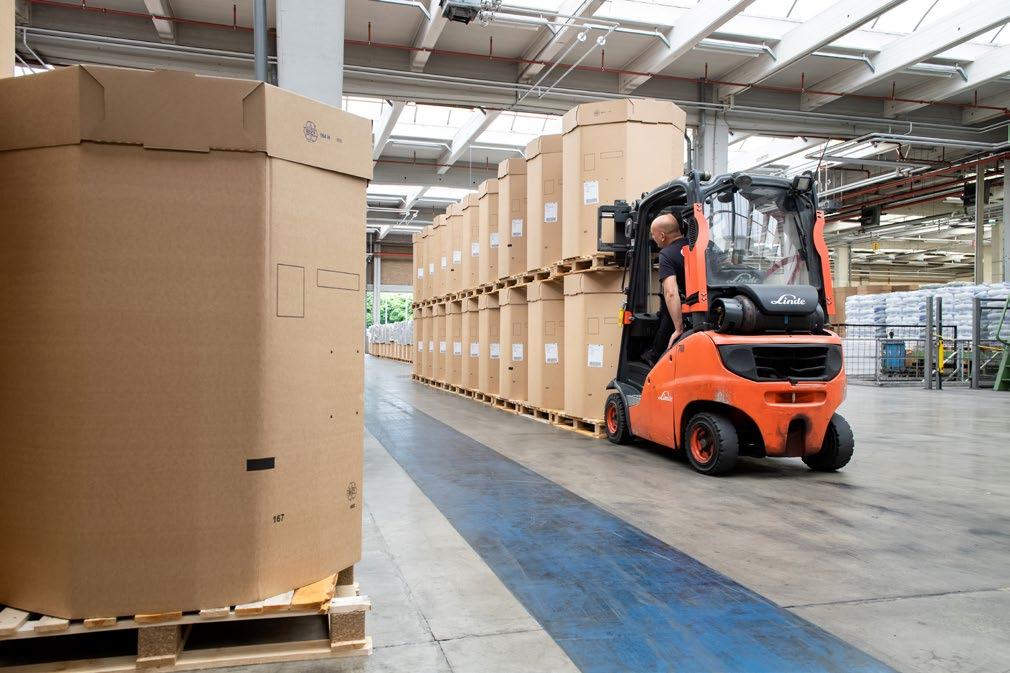
WELCOME. YOU BECAME THE CHAIR OF THE GETEC GROUP’S ADVISORY BOARD IN MAY. WHAT ATTRACTED YOU TO THIS ROLE?
The energy industry has enormous relevance for the future of humankind. The interesting thing is that the industry’s transformation will be disruptive. The German market is particularly interesting in this respect because certain decisions are being made which are now forcing the entire industry to transition rapidly toward a green, renewable and technology-friendly approach. I’m pleased about this because I’m a bit of a technology freak. I believe that technology does more good than bad. It will take us into a better future. That’s why I think we need to be more courageous when it comes to technology.
YOUR JOB CERTAINLY WON’T BE EASIER. THE UTILITIES AND ENERGY SERVICES BUSINESSES ARE MORE POLIT ICAL THAN EVER BEFORE. WHERE DO YOU SEE GETEC’S RESPONSIBILITY, ALSO AND ESPECIALLY IN LIGHT OF THE CONFLICT BETWEEN RUSSIA AND UKRAINE?
We are living in very dynamic times. As difficult as the situation might seem at the moment, it also harbors many new opportunities. Our world order is changing, in terms of politics but also in respect of the food industry and, of course, the energy industry. Companies like GETEC have a particular responsibility. Many companies will be facing difficulties now, but companies like GETEC are seeing new opportunities. Current developments are forcing the company to ask itself how it can contribute to society. It therefore needs to identify solutions aligned with its values and capabilities. That is an enormous task. It’s quite simply a matter of keeping the econ
omy moving sustainably and providing people with electricity and heating. GETEC has a unique opportunity here because, as an innovator, it is able to react more openly than other companies. In other words, GETEC can deploy state-of-the-art technologies and deliver the best service with the best work force. If we succeed in this, we will move into this new future one step at a time. I find this image not only interesting but also moving.
WHEREAS PROFIT WAS ONCE THE MAIN MEASURE OF SUCCESS, CORRECT CONDUCT AND GOVERNANCE ARE NOW BECOMING INCREASINGLY IMPORTANT. WHAT SPECIFIC IMPACT WILL THIS TREND HAVE ON THE WORK OF COMPANIES LIKE GETEC AND ITS CUSTOMERS?
I’ve been working for our family-owned company for 34 years – a small eternity. During that time, I have repeatedly experienced the following phenomenon. When one’s own values and the company’s values align and create value – in other words, things come together which are both true and a good fit – this will generate profit. They simply belong together. Value and profit are not contradictory terms. On the contrary. They are both essential to making the world a better place. You need to be profitable in order to develop greener technologies for the future. And you can only be profitable in the future if you respect certain values. Those companies which fail to create additional value will have trouble being profitable in the future.
Hydrogen is a very relevant aspect of the future. However, this technology has not yet developed to the stage we need today. To understand this, you need to look at the overall picture. We have the transport industry covering aspects such as in dividual transport, goods transport and energy transport, the combined heat and power sector and electrification, to name just a few. Hydrogen alone will not be able to meet all these requirements. The segment needs to evolve. Hydrogen is just one solution, but there need to be others as well. However, there is a lot of potential. We still don’t have broad access to many biological resources. The key question, therefore, is what we should do in the current situation. What is reason able? Until recently, we thought that gas would facilitate the transition from coal to greener energy sources. However, for political reasons, this transition is now no longer interesting. The question now is how quickly we can realign. We suddenly no longer have a five-year horizon, but less than one year. For GETEC, this means we have to look more closely at the big picture and ask what makes the most sense for our customers, society and our planet. Hydrogen is certainly a very promising feature of this big picture. In Finland, for example, there are a number of very interesting hydrogen start-ups offering some good solutions. But we need other solutions as well. The Advisory Board has therefore concerned itself very specifically
Anne-Catherine Berner has been Chair of the Advi sory Board of GETEC Group since May 10, 2022. The Swiss-Finnish entrepreneur and director is Finland’s for mer Minister for Transport and Communications. In 2015, Ms. Berner was elected as a member of the Finnish Par liament, representing the electoral district of Uusimaa as a non-attached candidate of the Center Party. For many years, she headed Vallila Interior, a family-owned interior design company. Before starting her career in politics, she initiated a charity project to construct the New Children’s Hospital in Helsinki, which opened in 2017.

with the big picture and these solutions, and has initiated a review of the Technology Roadmap.
I would like everyone at GETEC to be curious and open to what the future brings. I would like people to be interested in pursuing the new paths that present themselves. Above all, however, I would like GETEC to be and remain the best possible partner to our customers, the best place to work for our employees, and to create sustainable value – cultural, professional and, of course, monetary. I am very grateful and pleased to able to make my own small contribution.
HYDROGEN IS THE NEW BEACON OF HOPE IN EUROPE. IF IT WERE DOWN TO PUBLIC OPINION, THE INDUSTRY COULD NOT SWITCH FAST ENOUGH TO THIS SUSTAINABLE FUEL. GETEC ADDRESSED THIS DEVELOPMENT AT AN EARLY STAGE AND WILL SOON BE ONE OF THE FIRST ENERGY SUPPLIERS IN THE NETHERLANDS TO USE HYDROGEN ON A LARGE SCALE TO GENERATE ENERGY. THIS SUCCESS RESULTED FROM MANY STAKEHOLDERS IN GOVERNMENT, INFRASTRUCTURE AND INDUSTRY PULLING TOGETHER.
PROJECT MANAGER PETER NILLESEN in Eemshaven: Soon, hydrogen will be transported via pipelines from here to GETEC PARK.EMMEN.


Anyone looking at Eemshaven in the Groningen province of the Netherlands sees something of a paradox: dikes and sheep alongside power plants and wind turbines. In Eemshaven, nature and industry exist in pragmatic juxtaposition. This is all the more true if one also looks ahead to the near future.
Eemshaven will soon become a role model in the energy transition. Together with Delfzijl, it is the starting point for the HEAVENN model project to create a hydrogen valley in the northern Netherlands. The concept is based on the use and integration of existing and planned project clusters at six locations: Eemshaven, Delfzijl, Zuidwending, Emmen, Hoogeveen and Groningen. The vision and goal of many of the project partners from industry, science and government is to use green hydrogen along the entire value chain, at the same time developing viable business models for the large-scale commercial use of hydrogen.
proach which prioritizes the use and refurbishment of existing infrastructure.
Eemshaven thus represents the start of the energy transition to which GETEC is making a significant contribution via its Platform Netherlands and the Hydrogen Competence Center. GETEC PARK.EMMEN is not only a project partner in HEAVENN but also in the GZI Next project based in Emmen. On a slightly smaller scale, GETEC is working with GZI Next on the site of NAM’s former gas scrubbing facility to produce green hydrogen in an electrolyzer and renewable electricity from a photovoltaic plant. Both are then transported via a four-kilometer pipeline directly to GETEC PARK.EMMEN for use as energy. In collaboration with a research project of the German Aerospace Center (Deutsches Zentrum für Luft- und Raumfahrt, DLR), GETEC’s engineers succeeded in installing new boiler technology in the Park’s CHP so that hydrogen can be added to the fuel mix. Today, the hydrogen content is already 18% and is intended to rise to 100% in 2025.
The project work of the team in the Netherlands is supported and supplemented by Platform Switzerland’s newly created Hydrogen Competence Center. “As a climate-neutral fuel, green hydrogen will play a key role in providing decarbonized energy services to industry, at the same time contribut ing to the transformation of energy value chains. It is a climate-neutral raw material for the production of basic chemicals, and a clean and sustainable fuel for the net zero society,” says Dr. Guido Zimmermann, Platform CEO Switzer land and Head of the Hydrogen Competence Center.
This involves integrating the renewable energy sources that are widely available in the coastal region – onshore wind, offshore wind and solar. The hydrogen produced in elec trolyzers is intended to serve as a storage medium for the later recovery of electricity and as a fuel for industrial heat generation and for transport. Also planned is an LNG terminal in Eemshaven, which will be able to handle hydrogen as well as natural gas. The hydrogen produced in the electrolyzers will be transported via modified and refurbished natural gas pipelines and newly constructed infrastructure to various destinations such as Emmen. This is a very sustainable ap
“WE MUST STAY ACTIVE WHEN IT COMES TO HYDROGEN. THIS WILL DEMAND A GREAT DEAL FROM ALL PARTIES: PRO DUCERS, GOVERNMENT AND CUSTOMERS. HOWEVER, IF WE KEEP TALKING TO EACH OTH ER, THINK SUSTAINABLY AND CONTRIBUTE WHAT WE CAN, THEN WE WILL TRULY HAVE ACHIEVED SOMETHING.”
DR. GUIDO ZIMMERMANN, PLATFORM CEO
Pipelines are needed to transport the hydrogen to GETEC PARK.EMMEN and other destinations. Gasunie Transport Services is currently laying these pipelines, for example be tween Emmen and the GZI Next Energy Center. This pipeline will link GETEC PARK.EMMEN to the hydrogen infrastructure. Thanks to the fortunate situation that some industries had to switch from low-calorific to high-calorific gas in 2022, there was a unique opportunity to lay the hydrogen pipeline at the same time.
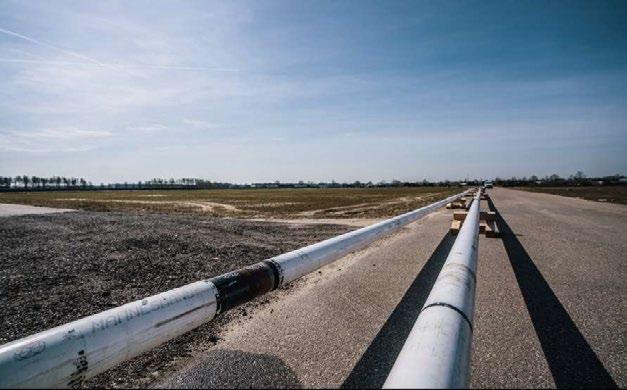
Thomas Schoepke, Platform CEO Netherlands, outside the power plant which will later use hydrogen in the fuel mix: “On the basis of our role as the Hydrogen Competence Center, we are modifying both our CHPs to be able to process up to 18% hydrogen. In a later phase, this will increase to 100% hydrogen once we are connected to the hydrogen pipeline. Using hydrogen to generate electricity and steam is a key element in our joint commitment to making a posi tive contribution to environmental protection and to meet our customers’ increasing need to reduce their carbon footprint.”


In November 2022, a floating plat form will be installed in the port of Eemshaven for use in transferring two billion cubic meters of liquid hydrogen or natural gas to land. A further stationary terminal will be added between 2025 and 2027 at the earliest. This port can be supplied from various sources, thus making Europe’s future energy sup ply more flexible and independent.
In 2017, the Netherlands national oil and gas company NAM closed its desulfurization plant in Emmen. Working with regional partners, a plan was made to use the site as an energy center. As part of a working group, GETEC is focusing on the use of hydrogen. The gas turbines for this project were developed and modified together with the consortium. Henrik van der Ploeg, Head of GETEC PARK.EMMEN: “We already started focusing on hydrogen five years ago. Back then, there were many critics who considered the tech nology unrealistic because they thought the costs were too high. Our persistence in pursuing this strategy is now paying off.
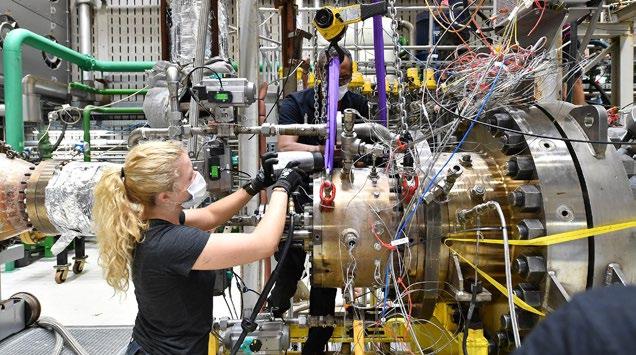

At the Hydrogen Competence Center, GETEC began acceler ating its Group-wide initiatives for the use of hydrogen at the start of 2022. Examples of the projects that the Hydrogen Competence Center is conducting across all GETEC’s regional platforms are the conversion of blue and green ammonia, which bind hydrogen, into heat and electricity or the reforma tion of ammonia to form clean hydrogen. Other development projects concern the production of green methanol or the use of hydrogen in micro combined heat and power plants and fuel cells. All of these efforts are focused clearly on sup porting GETEC’s customers with hydrogen-based contracting solutions on their route to net zero.
The necessary capabilities and processes must comply with high safety, economic, regulatory and operational require ments, as well as chemical industry requirements. These are capabilities offered by both GETEC parks in Muttenz and Emmen. To gain rapid access to the volumes of hydrogen required by the Competence Center, GETEC is one of the first German companies to conclude a cooperation agreement with the Abu Dhabi National Oil Company (ADNOC) for the supply of hydrogen produced in the United Arab Emirates (UAE). The agreement was signed during the visit of a business delegation, including GETEC, that accompanied Germany’s Economics Minister, Robert Habeck, on a trip to Abu Dhabi. Following a pilot delivery of blue ammonia, the cooperation is to be expanded to the supply of green ammonia that is pro duced entirely using renewable energy and can be reformed into green hydrogen when it arrives in Europe. In this way, GETEC has acquired access to various sources of hydrogen within just a short time, thus contributing a massive boost to the energy transition.
“For GETEC, good governance also means steering the company safely through uncertain situations such as geo political crises, increasing its resilience and acting with foresight. The Ukraine conflict with its many victims is a painful reminder of this necessity. It is therefore essential to review our own Technology Roadmap on a regular basis and devise alternatives for the future of energy. That is why we took the early step of developing our own Hydrogen Competence Center and facilitating the use of hydrogen by all GETEC Group customers in the northern Netherlands and Switzerland.”
Thomas Wagner, Group CEO
Green hydrogen is produced by electrolyzing water with electricity generated from renewable sources. This hydrogen can be bound in ammonia to make it easier to transport.
Blue hydrogen is produced from natural gas, with the CO2 by-product being stored rather than released to the environment.
Grey hydrogen is produced from natural gas, with the CO2 by-product being released to the environment.
Rolf Buch is CEO of housing company Vonovia. Vonovia SE is Europe’s leading private housing company which owns more than 550,000 apartments in all attractive cit ies and regions of Germany, Sweden and Austria. In addi tion, the company manages around 72,500 apartments.
When he became CEO, Rolf Buch listed Vonovia on the stock market. In 2015, Vonovia SE was included in Germany’s lead index DAX 30 (now DAX 40) and, in Sep tember 2020, in the EURO STOXX 50. The company is also listed in other national and international indices such as the DAX 50 ESG. Vonovia employs 15,900 people.

February 24 changed Europe. The war has brought unimag inable suffering to the people of Ukraine. Many women and children have sought refuge in Germany. They are vulnerable and urgently need their own apartment as a safe haven. It is our task to provide them with this safe haven. To date, we have rented more than 420 apartments to Ukrainian citizens. However, the war is also having a macroeconomic effect. Prices are rising rapidly, inflation is at its highest level since the 1970s, and interest rates are increasing. The war and the economic sanctions on Russia have made materials more ex pensive and supply chains longer. All of this results in delays. The shortage of qualified labor is also contributing to making projects slower than planned.
THE GERMAN GOVERNMENT HAS TIGHTENED ENERGY EFFICIENCY REQUIREMENTS FOR BUILDINGS. CAN THE REAL ESTATE SECTOR COMPLY WITH THESE REQUIRE MENTS?
The main priority is to switch to sustainable forms of energy, both to protect the climate and to become more independent of the international energy markets. This is the only way to ensure the continued affordability of heating, hot water and electricity. We have committed to a climate path which we are now accelerating to make our portfolio of apartments virtually climate-neutral by 2045. We want to achieve this by modernizing the energy systems and using electricity from renewable sources. We have taken a great stride in this direction by installing photovoltaic modules on 30,000 roofs, thus also increasing our offering of green electricity for our tenants. By contrast, political demands are becoming increas ingly divorced from reality. There is a lack of materials, labor and binding regulatory requirements. In addition, increasing interest rates are dampening the investment environment. The government needs to act.
Definitely. At least a year ago, Vonovia developed a software solution to measure the impact of its own portfolio on the climate and its own ESG tool. This software is now in use and
subject to ongoing optimization. In the end, it will be more than just a planning and analytical tool. As soon as possible, it will include modules for implementing and monitoring measures, feedback management and the generation of vari ous reports. We are also working with a number of start-ups on other projects such as the digitalization of building appli cations. For example, we are currently cooperating with the City of Bochum and start-up VSK Software to develop a mod el-based digital solution for checking building applications in light of the applicable local building regulations. The solution will make work easier for the applicant and the responsible building authority, making the approval process more efficient while ensuring the high quality of the checks.
ARE INTEREST RATE HIKES, THE SHORTAGE OF QUALI FIED LABOR AND THE ENERGY TRANSITION JEOPARDIZ ING THE FUTURE DEVELOPMENT OF THE MARKET AND YOUR COMPANY?
2021 was the most successful year in our company’s history. Since our IPO, the high demand for real estate, the shortage of supply, and the low interest rates have given us a strong tailwind. The impact of the COVID crisis on our business was also limited. Our business model and digital management platform give us the strength to face the current macroeco nomic challenges.
“WE HAVE COMMITTED TO A CLIMATE PATH WHICH WE ARE NOW ACCELERATING TO MAKE OUR PORTFOLIO OF APARTMENTS VIRTUALLY CLIMATE-NEUTRAL BY 2045.”
One thing that elicits rare unanimity from all German busi nesses is that the threat of cybercrime is real and that they, especially critical infrastructure companies like energy suppli ers, need to face up to the challenge. However, according to Thomas Heinemann, GETEC’s Informa tion Security Officer, every crisis is also an opportunity for the company. “IT Security thinks in sustainable terms. We are looking for long-term solutions. In the past, we information security officers had to explain a great deal. This has paid off and we’re now getting a lot of support. This is important because, over the past four to five years, we’ve been observing a professionalization of cybercrime. Criminals are using illegal forums to offer certain services for money. This is a situation that requires a response from businesses and society alike. Cybercrime is one of the most lucrative criminal markets and will therefore continue to grow.” This is a topic which has now attracted public interest. Many companies – especially those in the very vulnerable automotive industry – have been complaining of more attacks since the start of the war in Ukraine. What is the situation at GETEC?
“We had feared that we would be affected more. Fortunately, however, we haven’t recorded any significant increase. Our own errors when harmonizing systems or installing updates are actually more relevant as the causes of outages than ex ternal attacks. My colleagues in our IT network report similar situations. Luckily, although there is more activity, little harm has been caused because we are increasingly well-prepared. However, we must remain vigilant.”
And how? What is GETEC doing specifically to ensure IT/OT security? “In principle, there are three aspects: protection, detection, response,” says Heinemann. To ensure protection, Information Security trains employees to be vigilant. The department provides training films and simulate phishing attacks, for example, to see how employees react. The second aspect is technical protection provided by processes and soft ware. “Unfortunately, there’s no such thing as 100% protec tion. Someone always manages to get past the firewall. That’s why we’re increasing our focus on active protection. Hackers are now so professional that normal employees sometimes have no way of recognizing the attack, no matter how well trained they are,” explains Heinemann.
If an event occurs, the detection measures usually kick in. GETEC Information Security has installed internal systems to identify anomalies. These systems are evolving autonomously using machine learning. This is important because no human could do this work. In order to identify anomalies, thousands of pieces of information are scanned per second. In addition, external service providers are used to monitor the information 24/7.
If, despite these measures, malware manages to penetrate the system with the intention of causing damage, the Cyber Incidence Response Plan comes into effect. This is a clearly defined process which categorizes each specific case and handles it in accordance with a given playbook. The catego ries are: event, incident, emergency and crisis. It is usually only the crises that make it into the public eye. We have all seen headlines like “Hackers grab customer data from car hire companies,” “Hacker attack on energy company” or “German government confirms cyber attacks on authorities and minis tries.”
Operational technology (OT) refers to the use of hard ware and software to control industrial equipment. OT includes, for example, specialized systems for the plants used in energy supply.
Information technology describes data systems which are responsible for transmitting and storing information. Examples are company networks or customer databases.
How does GETEC handle threats like these? “There are basi cally two strategies for protecting the systems: isolation or segmentation,” says Heinemann. The isolation strategy has not aged well. For a long time, the prevailing opinion in oper ational technology (OT) was to never touch a running system. Specifically, this means that a functioning system should be updated as little as possible and not opened to the outside. However, that is difficult to achieve in the modern digitalized economy. Regular updates are essential because new vul nerabilities are being discovered all the time. And external support is usually provided remotely because anything else is inefficient and expensive. A new strategy is therefore needed: segmentation.
Says Heinemann: “We rely on diversity in our control systems. All the systems can be run in segments on which the opera tion of our plants depends. In an emergency, we can cut the connection, which means that only one system is disrupted, not all of them.” This is easier said than done. The separate systems come together in the Smart Control Centers, but must not be linked. Moreover, certain efficiencies must be sacrificed for the duration of active segmentation.
“One of the exciting aspects of information security is finding the right balance. It is the task of the future,” concludes Heinemann.
Information and its processing are the basis for all business processes. Therefore, ensuring the security of this information and the processes used in its processing are of strategic importance to the GETEC Group. If defined protection targets are not observed, this may jeopardize the company’s operations and thus the foundation of its business.
When we talk about information security, we mean the security of both operational technology (OT) and information technology (IT) and of the information used outside technological systems.
The scope and significance of information security to the entire Group is illustrated by looking at the stakeholders which interact with the information. The company’s employees need certainty for handling infor mation and want to know that their personal rights are protected. Customers, service providers, partners and suppliers rely on smooth-running information processes and data protection. The Group IT department aims to upgrade operational security measures, increase awareness among all employees and management and improve the company’s resilience and ability to react to cyber attacks. The Legal and Compliance department insists on compliance with laws, regulations and contracts.
In respect of information security, we have identified risks which have a tangible or significant disruptive ef fect on our business processes and the supply of energy to our customers and, as a result, can reduce or have a very negative impact on the annual results of GETEC and its customers.
In order to adequately protect the foundation of the company’s business, the GETEC Group operates an information security management system (ISMS). In implementing technical and organizational measures to achieve the protection targets, it is necessary to record detailed information about the processes in GETEC’s technical systems. Some of this information may be personal data, so data protection must be maintained.
In organizational terms, the scope of application of the ISMS covers the GETEC Group (G+E GETEC Holding GmbH and its direct and indirect wholly owned subsidiaries). It is also applied as far as possible to those subsidiaries in which G+E GETEC Holding GmbH does not directly or indirectly hold all shares. The managing directors of these subsidiaries appointed by GETEC are required to ensure that the legal entities they manage also comply with these policies.
The ISMS is the organizational basis for the safe handling of information by all those involved. In the area of cybersecurity, the GETEC Group concerns itself intensively with measures to protect the technical information systems, raising user awareness for the safe handling of information and providing the necessary training, and the options, processes and preparations for detecting and reacting to cyber attacks. Cybersecurity is that part of information security which practically implements the requirements for safe information processing.
Two risks have been identified as especially relevant to GETEC:
The failure of central systems (both the company’s own systems and systems operated in the cloud) Ransomware (encryption of parts of systems or all systems in the networks)
All of GETEC’s business processes are dependent on information and its processing. Information security has the overarching objective of ensuring that the business processes are executed in the way expected by GETEC and its stakeholders. We specifically pursue the following protection targets:
Confidentiality ensures that information is accessible to only a certain group of people.
Integrity requires that information either cannot be modified or that any modification can be reliably identified.
Availability means that information must be available at the right time in the right place.
The GETEC Group manages information security on the basis of risk. To this end, the information security risks for the critical processes and systems are identified and assessed. Using these assessments, management defines the action strategy based on the principle of appropriateness. The following options for action exist:
Acceptance: The risk and its potential impacts are borne.
Reduction: The risk is reduced by way of suitable measures.
Transfer: Measures to reduce risks or their potential impacts are transferred to third parties.
Avoidance: The risk is avoided by shutting down or modifying the business process that causes it. This is a continuous process. Following the implementation of measures or changes to the conditions, the risks are reassessed. Irrespective of such actions, risks are identified and assessed annually.
GETEC management has overall responsibility for information security and has appointed the Information Security Officer (ISO) to perform the resulting tasks. In addition, each GETEC employee and any third party acting on behalf of GETEC are responsible for ensuring information security in their respective area of activity.
Information security is organized on two levels: Group level and platform level.
Because they are located in different countries and have different business models or different areas of activ ity, the platforms are steered by an independent management structure. A platform’s guidelines and policies specify the Group-level requirements for the platform and additional detailed implementation processes.
The Information Security Coordinator (ISC), who coordinates information security for a platform, consults with the ISO and platform management.
The IT department in Germany, headquartered in Magdeburg (Platform Germany), has a special role. This platform’s regulations serve as the blueprint for all other platforms. Any deviating regulations will only be implemented if they can be justified to the ISO and the Group Steering Committee. The respective ISC is responsible for establishing, operating, reviewing and improving the ISMS for a platform.
The GETEC Group ISMS Steering Committee receives the ISO’s reports about the status of the ISMS, resolves on Group ISMS guidelines and policies, and decides on how to address the risks that have been assessed. There is an ISMS steering committee at platform level as well.
Management has appointed the Information Security Officer (ISO) to steer the ISMS processes. His area of activity encompasses more than 20 tasks, some of which are described below. The ISO: Aligns the information security targets with GETEC’s business objectives; Prepares and updates the information security policy and agrees this with the ISMS steering committee; Is responsible for establishing, operating and developing GETEC’S ISMS; Evolves GETEC’s information security concept (for example, adapting it to new statutory requirements); Advises top management on all information security matters; Coordinates awareness and training measures on information security; Plans and designs measures for handling emergencies; Takes the lead in analyzing and following up on information security incidents; Arranges audits in order to review the level of information security; Is involved in decisions (for example, initiating IT projects or procuring systems to process information); Creates and maintains the audit program.
Moreover, within their respective areas of activity, all GETEC employees are responsible for maintaining infor mation security and are obliged to comply with the ISMS policies. This also applies to third parties who are not employed by GETEC but use the aforementioned assets, for example, service providers and suppliers acting on behalf of GETEC. They bear the same responsibility for maintaining information security. They must also comply with the ISMS policies and contribute reports, information and suggestions concerning the further development and improvement of information security.
The ISMS can only function with effective communication. All the roles and stakeholders involved must re ceive the detailed information they need to manage information security. In turn, they must act independently to provide the necessary information to the relevant recipients.
Communication channels have been defined within the Group, between the Group and the platforms, and within a platform. The stakeholders involved in communication are the ISO, the ISC, the ISMS Steering Committee, the process owner (responsible for a process), the asset owner (responsible for an asset) and the risk owner (responsible for the risks associated with an asset). Communication covers, for example, incidents, risk treatment plans, proposed measures, status reports in respect of the implementation of measures, audit results, reviews and agreements.
We operate an ISMS based on the ISO/IEC 27001 standard to help us achieve our information security targets. The assets to be protected are managed on the basis of policy IS002 (ISMS Processes). An effective ISMS is built on three processes: asset management, risk management and response management.
Asset management
Information asset is threatened by
Risk management
Risk influences measure
Audit Audit
The three processes are directly related. Assets are threatened by risks. In response, measures are taken to influence the risks in such a way that they are acceptable to GETEC in line with the company’s risk appetite.
We define processes (business processes or areas of application), information, services, applications (software), IT infrastructure and physical infrastructure (buildings, rooms, supply equipment for electricity, communica tions and other media) as assets.
The following must be documented for each asset: asset category, owner/responsibility, platform responsible for asset management, dependencies on other assets. In addition, the recovery point objective (RPO) and maximum tolerable downtime (MTD) are documented for the process asset category.
The security requirements for each asset are then determined on a four-stage scale ranging from low to very high.
The properties and links between assets and processes are also documented. This forms the basis for risk management.
We have established our own risk management process to handle information security risks. The starting point is the identification of any vulnerabilities by the ISO and ISCs. Moreover, all stakeholders are required to report any vulnerabilities they identify to the ISCs. These may be associated with either the technical systems used by GETEC to process the information or with the organization that handles information.
The process is as follows:
Document vulnerability – using an audit-proof ticket system.
Assess risk – probability of occurrence and impact of damage (five defined stages ranging from insignificant to catastrophic); these two dimensions result in a risk matrix.
Conduct dialog: On the basis of the risk assessment, the ISC initiates dialog with the platform’s Head of IT. The aim of this is to review the outcome of the assessment and adjust it, if necessary.
Treat risk: The ISC then proposes a strategy for treating the risk.
Risk acceptance: The risk appetite represents GETEC’s willingness to bear risks. Generally speaking, risks that fall below the appetite threshold are accepted.
Risk reduction: Suitable technical and organizational measures (TOM) are deployed to reduce the prob ability of occurrence and the impact of damage.
Risk transfer: The goal is to transfer the risk and/or its impacts to an insurer or other third party.
The ISC and the affected process or asset owner develop measures to reduce or transfer the risk. The following factors are included in assessing the measures: investment and service costs, personnel expenses, time, risks (for example, disruption to operational processes) and opportunities (for example, leveraging additional value).
On the basis of this assessment, a decision is taken about which measures to implement. Generally speaking, the asset or process owner is responsible for implementation, which is monitored by the ISC.
Measures have been implemented to minimize the probability of the identified risks occurring and/or their impact. They include:
Establishment of a change management process
Increase in the proactive monitoring of critical IT systems
Introduction of regular reviews of the authorizations that have been issued
Implementation of a cybersecurity incident response plan (CIRP), including the necessary emergency and crisis organization and playbooks for potential emergency scenarios
Introduction of firewall solutions which use current thread intelligence information to actively identify and suppress threats in network data traffic
Transition from conventional virus scanners to an extended detection and response solution which, support ed by machine learning, recognizes and suppresses attacks
Implementation of multi-factor authentication for IT systems which can be accessed from the public network
Introduction of a continuously adaptive phishing simulation with teachable moments to raise employees’ individual cybersecurity awareness
Regular penetration tests conducted by external experts
Continuous monitoring of the central systems for known technical vulnerabilities
The need for additional measures is regularly reviewed and they are implemented as necessary.
The GETEC Group works continuously to improve the protective measures. However, we know there is no such thing as 100% protection. That is why we prioritize identification and response alongside prevention. Any anomalies in the systems are identified with the support of machine learning and external experts. We have established processes to respond effectively to any incidents that are identified. These processes include predefined emergency measures.
Our ISMS is secured by an audit program with a three-year cycle. An audit serves to review the implementa tion of policies and determine the effectiveness of the ISMS. We use the following types of audits: self-as sessments (requested and performed by GETEC itself), internal audits (commissioned by GETEC and performed by an external organization), external audits (may be commissioned by a customer), certification audits by an accredited certification body.
In connection with the information security management system, GETEC has introduced the following direc tives:
Information Security Guideline
Defines GETEC’S organizational framework, information security policy and information security targets
ISMS Processes
Defines the underlying processes for asset management, risk management and response management, as well as audit regulations
Authentication Authentication specifications for users of GETEC systems
Regular Use
Manages the approved use of GETEC’s assets
Backup and Recovery
Specifications and requirements for data security and the recovery of information and systems
Mobile Working
Specifications and responsibilities for information security in respect of mobile working Physical Security
Definition of physical security at the GETEC sites
Access Management
Management of access authorizations for information, systems and rooms Dealings with Suppliers
Information security requirements in supplier relationships
Information Security Aspects of Contracts
Dealing with information security aspects in contracts with customers and partners Cryptography
Specifications for handling and applying cryptographic processes for the transport and storage of digital information Information Classification
Specifications for the classification, identification and handling of GETEC’s information Secure Software Development Regulations to manage the secure development of software by GETEC Malware Protection
Specifications for implementing suitable protection against malware Logs and Records
Handling event logs and other records Network Security Specifications for the design and operation of secure networks
The measures implemented to improve security may record certain information that might include personal data. In the case of network components, this information may include the start and end of communication and the communication source; in server applications, it may be the start and end of a session and the users who are logged in; on GETEC’s terminal devices, it covers the metadata of the files used, for example.
These data are recorded only for the purpose of automatically strengthening the resilience of our IT infra structure and business processes, and for the forensic analysis of information security incidents. Any improper use of the data recorded, irrespective of who within GETEC initiates that use, will be considered a violation of the Code of Conduct and GDPR, and dealt with accordingly.
Processing the data recorded is the sole responsibility of the ISO. Only those employees with information security tasks receive access to the data.
The three processes are directly related. Assets are threatened by risks. In response, measures are taken to influence the risks in such a way that they are acceptable to GETEC in line with the company’s risk appetite.
Platform Germany has implemented an information security management system (ISMS) and an information security guideline. The ISMS was developed in accordance with ISO 27001 and is to be certified in 2022.
To date, the ISMS does not extend to our regional platforms in Italy, Switzerland and the Netherlands. Howev er, it is intended to roll the system out to these platforms as well.
The effectiveness of the measures implemented in fulfilling the information security targets is assessed by the ISO and those with operational responsibility at regular intervals or following the implementation of measures. The ISO reports the outcome of these assessments to GETEC’s management.
Information security is not a one-time process that results in secure information processing as its final status. On the contrary. The process is characterized by many dynamic risks. Business processes or statutory requirements can change while, on the technical level, new threat scenarios may arise. In order to meet the challenges of this dynamic environment, the ISMS ensures that the measures are implemented in repeated cycles. This ensures the continuous improvement of information security, as well as its adaptation to changed conditions.
All employees are still required to participate actively in the further development and improvement of the ISMS by contributing reports, information and suggestions. This also applies to any third parties involved, such as service providers working on behalf of GETEC.
We measure the successful implementation of information security and cybersecurity on the basis of the following indicators:
Number of incidents
Especially in the area of cybersecurity, events may occur in large and seasonally fluctuating numbers. As a rule, pure information security events occur far less frequently. Events become incidents if they cause or could cause quantifiable damage.
Number of emergencies
Incidents which have caused tangible restrictions of operations or other significant damage.
Number of crises
Emergencies which have escalated to crises because of their catastrophic impact that jeopardizes the company.
It goes without saying that GETEC’s goal is to keep all three indicators as low as possible. Incidents cannot be avoided completely. In principle, we assume that we will not achieve zero incidents. However, we certainly aim to avoid any crises. Our basic aim is to improve year by year.
We achieved our goals in 2021. Only 22 of the 6,822 information security events had to be classified as incidents. Five of these incidents were escalated to emergencies which were successfully dealt with by our emergency management. No crises occurred.
In recent years, information security and cybersecurity have become increasingly significant to GETEC. The frequency of successful attacks on the entire range of companies has sharpened our focus on this issue. Over the same period, therefore, we have invested a great deal in security and feel we are well-prepared to deal with the challenges. This applies both to proactive protection and to detection and response.
Digitalization is a key factor in the dependency of GETEC’s business processes on the functionality of our IT systems. The coronavirus pandemic delivered additional impetus for mobile working, something which is not unique to us. Of course, this raised the interest of criminals. It is therefore essential that we ensure the resilience especially of our systems and our organization.
We will continue to pursue and extend the course we have adopted. Having mainly focused on Platform Germany until now, we are turning our attention to the company’s other platforms.
MEETING SAVINGS TARGETS, SATISFYING THE REQUIREMENTS FOR SUBSIDIES, SAFEGUARDING SUPPLIES: MODERN ENERGY MANAGEMENT IS
COMPLEX UNDERTAKING. THAT IS
GETEC HAS DEVELOPED
SYSTEM FOR THE INTELLIGENT COMMUNICATION OF REMOTE MONITORING OUTCOMES.
Throughout Italy, GETEC manages more than 3,000 public buildings – a highly complex undertaking. Viewed individ ually, however, most of the plants are technologically simple systems which deliver standardized data.

These energy data (consumption, production, efficiency) and the main tenance times are recorded daily and can be viewed in real time. Analysis of these data provides a valuable basis for continuous improvement using artificial intelligence and for active energy management.
The 3,000 buildings are organized de centrally and individually. When GETEC takes over management of a building’s power supply system, it installs stan dardized technology. This enables us to analyze each individual customer overall and manage their system from a central control room. In this way, each project benefits from the experience of the entire network.
Each of the systems is equipped with the VeroEnergy dashboard developed by GETEC to analyze performance. All data are consolidated here. The operations team can use this information to ac tively design energy management. Once the specifications have been defined and the system implemented, manage ment is largely automated because the monitoring and remote control systems communicate intelligently. The operator can view the data in real time and adjust the systems if necessary.

Thanks to its innovations and sustainable business models, GETEC is leading the energy transition. This leadership position brings with it a responsibility to be active in the political and social environment, to provide information and to defend the company’s positions. In order to exercise this responsibility, GETEC is a member of various associations which, depending on the industry they serve, may give us close proximity to our customers. The company also maintains con tact with political institutions. At the same time, GETEC satisfies all compliance-relevant requirements, for example, the transparency regulations concerning the newly introduced lobby register that have applied to Platform Germany since early 2022.
GETEC association memberships
Country Platform
AHK Polska Poland Germany
BBA-Akademie der Immobilienwirtschaft e.V. Germany Germany Bundesverband der Immobilienverwalter e.V. BVI Germany Germany Bundesverband freier Immobilien- und Wohnungsunternehmen e.V. Germany Germany Bundesverband für Materialwirtschaft, Einkauf und Logistik Germany Germany Chemport Europe Netherlands Netherlands Creditreform MD Harland KG Germany Germany Deutsche Unternehmensinitiative Energieeffizienz e.V. DENEFF Germany Germany
Die Wohnungswirtschaft Deutschland, GdW Germany Germany ECSPP Netherlands Netherlands
EHI Retail Institute e.V. Germany Germany eid Evangelischer Immobilienverband Deutschland Germany Germany Forum Contracting e.V. Germany Germany Frauen in der Immobilienwirtschaft Germany Germany Grüner Wirtschaftsdialog e.V. Germany Germany Industrieclub Magdeburg e.V. Germany Germany ivh-Industrieverband Hamburg Germany Germany
NPAL Netherlands Netherlands
NVDE Netherlands Netherlands Ondernemend (formerly VPB) Netherlands Netherlands Österreichischer Biomasseverband Austria Germany Powerloop Austria Germany
Project 6-25 Austria Germany
SBD Netherlands Netherlands Stadtmarketing “Pro Magdeburg” e.V. Germany Germany Stichting FC Emmen Naoberschap Netherlands Netherlands SWISSESCO Switzerland Switzerland
VDIV Deutschland Germany Germany
VdW Verband der Wohnungsgenossenschaften Sachsen-Anhalt e.V. Germany Germany VEMW Netherlands Netherlands
Verband der Immobilienverwalter Hessen e.V. Germany Germany Verband der Thüringer Wohnungs- und Immobilienwirtschaft Germany Germany Verband der Wohnungswirtschaft Sachsen-Anhalt Germany Germany Verband Sächsischer Wohnungsgenossenschaften e.V. Germany Germany Verein IG-Holzkraft Austria Germany
VIK – Verband der Industriellen Energie- und Kraftwirtschaft Germany Germany VNW Verband norddeutscher Wohnungsunternehmen e.V. Germany Germany Wenb Austria Germany Westwinkel Austria Germany Wirtschaftskreis Mitte e.V. Germany Germany Wirtschaftsrat der CDU Germany Germany ZellCheming, Verein der Zellstoff- und Papier-Chemiker und -ingenieure Germany Germany Zentralverband Deutscher Milchwirtschaftler e.V. Germany Germany
Reduction of CO2e emissions (Scope 1 & 2) – tCO2e/a 551,000 642,000 3,158,000 110a.1
Reduction of CO2e emissions (Scope 3) – tCO2e/a 59,000 70,000 N/A 110a.1
Total reduction of CO2e emissions – tCO2e/a 610,000 712,000 N/A 110a.1
Proportion of coal-free energy generated (capacity) – % MWh 92.7 94,0 100
Proportion of renewable energy generated (volume) – % MWh 29.0 30,0 63
Disclosure 305-4: GHG emissions intensity – Scope 1 & 2 – gCO2/kWh 219 203.57 89
CO2 emissions (Scope 1) (direct emissions) – tCO2e/a 1,287,075 1,576,936 2,329,000 110a.1
CO2 emissions (Scope 2) (indirect emissions) – tCO2e/a 189,127 106,022 327,000 110a.1
CO2 emissions (Scope 3) (indirect emissions) – tCO2e/a 852,010 831,228 N/A 110a.1
Employee occupational safety TRIR – number/million hours 7.5 9.23 10% annual improvement 320a.1
Employee occupational safety LTIR – number/million hours 3.14 5.48 10% annual improvement 320a.1
Fatal accidents at work involving employees and partners – number 0 0 0 320a.1
Proportion of women in management – % 8.4 11.1 25
Proportion of women overall – % 20.3 21.7 25
Health rate – % 97.0 96.7 98.0
Employee training and qualification – days 1 day/FTE 1.8 days/FTE 5 days/FTE
Employee turnover – % 4.3 7.8 <5
Trainees and dual students – % (of total workforce) 2.2 5.0
Trained employees (Code of Conduct) – % 88 80 100
Employee compliance – material incidents – number 2 0 0
Supplier compliance – material incidents – number 1 0 0
Technical and environmental compliance of power plants – relevant incidents – number 1 0 0
Disclosure 307-1: Non-compliance with environmental laws and regulations
– Total value of significant fines – € 0 0 0
Disclosure 419-1: Non-compliance with laws and regulations in the social and economic area
– Total value of significant fines – € 0 0 0
Data security compliance – material incidents – number 0 0 0 550a.1
Purchasing volumes in countries with a CPI < 60 points <1% <1% <1%
Suppliers recognizing the GETEC Supplier Code of Conduct 77%* 84%* 100%
The Sustainability Accounting Standards Board (SASB) is an independent standard-setting body which supports companies in the disclosure of finan cially relevant issues in the environmental, social and governance (ESG) areas. Our disclosures for 2021 are based on the SASB Standard “Electric Utilities & Power Generators”. The comparison with and use of additional SASB Stan dards is planned.
Standard Aspects Disclo sure Description Page
GRI 102: General Disclosures 14
Organizational profile 102-1 Name of the organization 14 102-2 Activities, brands, products, and services 16–19 102-3 Location of headquarters 14 102-4 Location of operations 15 102-5 Ownership and legal form 20/21 102-6 Markets served 21 102-7 Scale of the organization 22 102-8 Information on employees and other workers 22 102-9 Supply chain 113/114
102-10 Significant changes to the organization and its supply chain 23 102-11 Precautionary Principle or approach 23 102-12 External initiatives 23 + 139 102-13 Membership of associations and external initiatives 23 + 138
Strategy 102-14 Statement from senior decision-maker 8/9 102-15 Important impacts, risks and opportunities 25
Ethics and integrity 102-16 Values, principles, standards, and norms of behavior 27 Governance 102-18 Governance structure 14
Stakeholder engage ment 102-40 List of stakeholder groups 28
102-41 Collective bargaining agreements 91 102-42 Identifying and selecting stakeholders 28 102-43 Approach to stakeholder engagement 29 102-44 Key topics and concerns raised 29
Reporting practice 102-45 Entities included in the consolidated financial statements 21 102-46 Defining report content and topic Boundaries 30 102-47 List of material topics 30 102-48 Restatements of information 30 102-49 Changes in reporting 30 102-50 Reporting period 30 102-51 Date of most recent report 30 102-52 Reporting cycle 31 102-53 Contact for questions regarding the report 31 102-54 Claims of reporting in accordance with the GRI Standards 31 102-56 External assurance 31
GRI-relevant: Security of information and op erational technologies (IT and OT security), including cybersecurity and data protection
103-1 Explanation of the material topic and its Boundary 128 103-2 The management approach and its components 129 103-3 Evaluation of the management approach 134
GRI 305: Emissions 38
102-55)
Standard Aspects Disclo sure Description Page
103-1 Explanation of the material topic and its Boundary 38 103-2 The management approach and its components 38–44 103-3 Evaluation of the management approach 45 305-1 Direct (Scope 1) GHG emissions 37, 145 305-2 Indirect (Scope 2) GHG emissions 37, 145 305-3 Other indirect (Scope 3) GHG emissions 145 305-4 GHG emissions intensity 37
GRI 306: Waste(incl. effluents) 64
103-1 Explanation of the material topic and its Boundary 64 306-1 Waste generated and significant waste-related impacts 64 306-2 Management of significant waste-related impacts 65 103-2 The management approach and its components 65 103-3 Evaluation of the management approach 66 306-3 Waste generated and its treatment 67
GRI 307: Environmental Compliance 100
103-1 Explanation of the material topic and its Boundary 100 103-2 The management approach and its components 100–103 103-3 Evaluation of the management approach 103 307-1 Non-compliance with environmental laws and regulations 103
GRI 403: Occupational Health and Safety 84
103-1 Explanation of the material topic and its Boundary 84 103-2 The management approach and its components 84 103-3 Evaluation of the management approach 90 403-1 Occupational health and safety management system 84/85 403-2 Hazard identification, risk assessment, and incident investigation 85/86 403-3 Occupational health services 86 403-4 Worker participation, consultation, and communication on occupational health and safety 86/87
403-5 Worker training on occupational health and safety 87 403-6 Promotion of worker health 87 403-7 Prevention and mitigation of occupational health and safety impacts directly linked by business relationships 87–89 403-9 Work-related injuries 89
GRI 405: Diversity and equal opportunity 72
103-1 Explanation of the material topic and its Boundary 72 103-2 The management approach and its components 72–79 103-3 Evaluation of the management approach 79 405-1 Diversity of governance bodies and employees 79
Socioeconomic Compliance 104
GRI 419:
103-1 Explanation of the material topic and its Boundary 104 103-2 The management approach and its components 104–111 103-3 Evaluation of the management approach 112 419-1 Non-compliance with laws and regulations in the social and economic area 112
24/7 24 hours on 7 weekdays
adj. Adjusted
ADR Agreement concerning the International Carriage of Dangerous Goods by Road
AEVO Ordinance on Trainer Aptitude (Ausbildereignungsver ordnung)
AHK Polska German-Polish Chamber of Industry and Commerce
AI Artificial intelligence
ASA Occupational safety committee (Arbeitssicherheitsau sschuss)
AVORA Waste water pre-treatment plant
AWE Waste water treatment (Abwasserentsorgung)
B.V. Besloten vennootschap met beperkte aansprakelijkheid (Dutch limited liability company)
BAD B.A.D. Gesundheitsvorsorge und Sicherheitstechnik GmbH
BaustellV Construction Site Ordinance (Baustellenverordnung)
BCG Boston Consulting Group
BDEW Federal Association of Energy and Water Management (Bundesverband of energy- und Wohnungsunterneh men e.V.)
BetrSichV Industrial Safety Regulation (Betriebssicherheitsver ordnung)
BImSchV Federal Immission Control Act (Bundes-Immissionss chutzverordnung)
BMS Building management system
BU Business unit
CHF Swiss francs
CHP Combined heat and power plant
CIRP Cybersecurity incident response plans
CO Carbon monoxide
CO2 Carbon dioxide
CO2e CO2 equivalents
CoC Code of Conduct
COVID Coronavirus disease
CPI Corruption Perception Index
CSRD Corporate Sustainability Reporting Directive
DAA Deutsche Angestellten-Akademie GmbH
DENEFF German Corporate Initiative on Energy Efficiency (Deutsche Unternehmensinitiative Energieeffizienz)
DGNB German Sustainable Building Council (Deutsche Ge sellschaft für Nachhaltiges Bauen)
DGUV German Social Accident Insurance (Deutsche Gesetzli che Unfallversicherung)
DIN German Institute for Standardization (Deutsches Insti tut für Normung e. V)
DLR German Aerospace Center (Deutsches Zentrum für Luft- und Raumfahrt) e/E- Electric or electronic
E10 10% ethanol content
EBITDA
Earnings before interest, taxes, depreciation and amortization
ECSPP Expert Committee on Specifications for Pharmaceutical Preparations
EEG Renewable Energy Sources Act (Erneuerbare-Ener gien-Gesetz)
EMC Electrical measurement and control technology
EQT
EQT Group
ESG Environment, social, governance
FCH JU Fuel Cells and Hydrogen Joint Undertaking
FSM Field service management
FTE Full-time equivalent
g/kWh Specific fuel consumption (grams per kilowatt hour)
GCGC German Corporate Governance Code
GDPR General Data Protection Regulation
GEC Group Executive Committee
GEG Buildings Energy Act (Gebäudeenergiegesetz)
GHG Greenhouse gas
GRI Global Reporting Initiative
GWth Gigawatt thermal
H2 Molecular hydrogen ha Hectare
HFS&F
Hands, face, space, fresh air
HR Human Resources
HSSE Health, Safety, Security, Environment
IBC Intermediate bulk container
iCHP Innovative combined heat and power plant
IEC International Electrotechnical Commission
IHK German Chamber of Industry and Commerce
IoT Internet of Things
IPC In-process controls
ISC Information Security Coordinator
ISMS Information Security Management System
ISO Information security officer
ISO International Organization for Standardization
ISO Information Security Officer
IT Information technology
JAV Youth and trainee council (Jugend- und Auszubilden denvertretung)
KfW KfW Development Bank (Kreditanstalt für Wiederauf bau)
KPI
Key performance indicator
LNG Liquefied natural gas
LTI
LTIR
Lost time incident
Lost time injury rate
M&A Mergers and acquisitions
MBA Master of Business Administration
MCS Multiclient site
MGMT Management
Micro CHP Micro combined heat and power plant
MOG Organization and management model (Modello Orga nizzativo e Gestionale)
MTC Medical treatment case
MTD Maximum tolerable downtime
MW Megawatt
MWel Megawatt electric (electrical output)
MWh Megawatt hour
MWh/a Megawatt hour per year
MWth Megawatt thermal (thermal output)
NFRD Non-Financial Reporting Directive
NGO Non-governmental organization
NOX Nitrogen oxides
NPAL Noordelijke ProductiviteitsAlliantie
NVDE Nederlandse Vereniging Duurzame Energie
ODV Advisory and oversight committee (Organismo di Vigilanza)
OEM Original equipment manufacturer
OHSAS Occupational health and safety assessment series
OT Operational technology
P2H Power-to-heat
P2X Power-to-X (storage/use of surplus power)
PGS Publicatie Gevaarlijke Stoffen
pH value Measure of the acidity or alkalinity of an aqueous solution
PPE Personal protective equipment
PV Photovoltaics
RCA Root cause analysis
REACH Registration, Evaluation, Authorisation and Restriction of Chemicals (EU chemicals legislation)
RED II Renewable Energy Directive
RPO Recovery point objective
RVT Recovered, vaccinated, tested
S.à r.l.
French limited liability company (société à responsabil ité limitée)
S.p.A. Italian public limited company (Società per azioni)
S.R.L. French limited liability company (société à responsabil ité limitée)
s.r.o.
Polish liability company Spolocˇnost’ s rucˇením obmedzeným
SAGA Siedlungs-Aktiengesellschaft, Hamburg
SAM Online training system
SASB Sustainability Accounting Standards Board
SBE Samenwerkende Bedrijven Eemsdelta
SBTi Science Based Targets initiative
SCC Smart Control Center
SCoC Supplier Code of Conduct
SDG Sustainable Development Goal
SRM Supplier relationship management
STEM Science, technology, engineering, mathematics
tCO2e tCO2e metric tons of CO2 equivalents
TOC
Total organic carbon
TOM Technical and organizational measures
TRIR Total recordable incident rate
TÜV Technical Inspection Authority (Technischer Überwa chungsverein)
TWh Terawatt hour
VDIV Association of Real Estate Managers Germany (Verband der Immobilienverwalter Deutschland)
WENB Werkgeversvereniging voor bedrijven in energie, tele com, recycling en milieu
ZIA German Property Federation (Zentraler Immobilien Ausschuss)
ZNU Center for Sustainable Leadership (Zentrum für Nach haltige Unternehmensentwicklung)
PUBLISHED BY:
G+E GETEC HOLDING GMBH Albert-Vater-Straße 50 39108 Magdeburg Germany
REPRESENTED BY: Thomas P. Wagner (Group CEO)
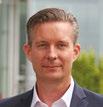
RESPONSIBLE FOR PUBLICATION: Corporate and Marketing Communication
WE WOULD WELCOME YOUR FEEDBACK.
Christian Faßelt
Head of Group Marketing and Communications Phone: +49 (0)391 2568-392 christian.fasselt@GETEC.de
EDITING AND DESIGN: Content Refinery / vorm.berlin
PHOTOS: Germany and the Netherlands: Benjamin Pritzkuleit for GETEC; Italy: Guido de Bortoli (Getty Images) for GETEC; We do that: Fischbeker Reethen (IBA Hamburg); agrothermal technology graphics: Frank Föckersperger GmbH, doppelacker.de; ice storage: Hansapark Nürnberg; Waste2Value portraits: BASF, Novartis, Bayer; Ukraine: Ridni Foundation; Buch portrait: Vonovia; VeroEnergy: Wikimedia; all other photos, illustrations and graphics: GETEC
CONTACT:
Phone: +49 (0)391 2568-100 Fax: +49 (0)391 2568-120 Email: info@GETEC.de
